IMPORTANT: IF YOU FIND EGGS BY THEMSELVES OR IN A NEST DO NOT TOUCH THEM! LEAVE THEM WHERE THEY ARE!
Many times, even if you find an egg on the ground, all by itself, with no nest around, it may be a species of bird that uses a scrape nest (just a simple scrape in the dirt) and they will return to lay more eggs until they have a full clutch before they start incubating the eggs. Please do not disturb nests or eggs that you may discover.
I no longer have the time to answer inquiries on egg and nest identification.
Please look though the information below. You should be able to identify the majority of the most common birds in North America
Western Bluebird Nest and Ash-throated Flycatcher Nest
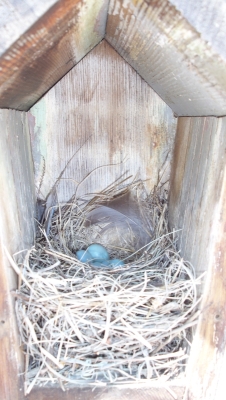
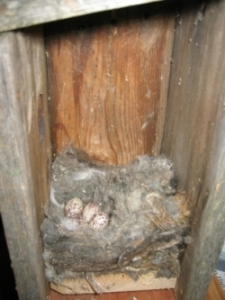
The Western Bluebird nest (left) is a collection of fine grasses and sometimes include a feather or two, leaves and thin bark. It has a fairly shallow cup with, if your lucky, up to seven pale blue eggs. The Ash-throated Flycatcher nest (right) is made up of grass, weeds, fur and hair. Sometimes containing some cow or horse dung.
Tree Swallow Nest and House Sparrow Nest
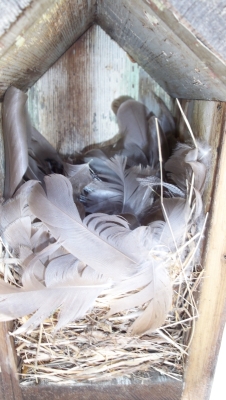
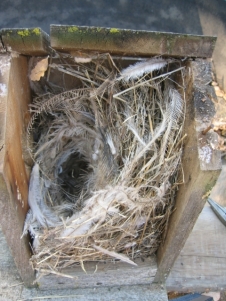
The Tree swallow nest (left) will look similar to the Western Bluebird with many more feathers. In this case the swallows had lots of goose feathers nearby. The House Sparrow nest (right) is a jumble of course grasses and weeds with seed heads and (in this case) Emu feathers that completely fill the nestbox. The nest will form a tunnel from the entrance hole almost to the bottom of the box.
Oak Titmouse Nest and House Finch Nest
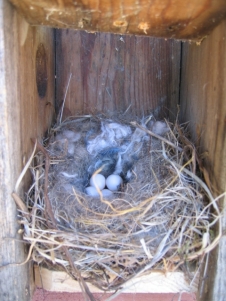
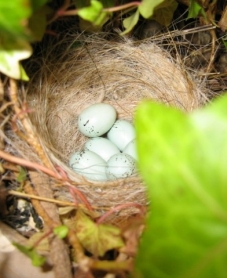
The Oak Titmouse nest (left) is made of grasses and moss, with fine hair and/or fur and sometimes small feathers making a deep cup for the eggs. The House Finch nest (right) is made of fine hair (horse hair in this nest) woven into a perfect bowl.
Cavity Nester’s Egg Comparison
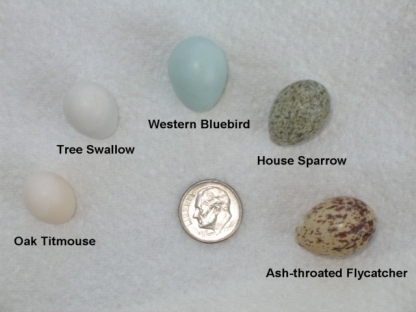
These eggs are all fairly shiny after the mother has been sitting on them for any length of time. Note the subtle differences between the Ash-throated Flycatcher’s egg and the House Sparrow’s egg. The House Sparrow egg has a cream, green or grayish background with irregular fine brown speckles whereas the Flycatcher’s eggs have an ivory or tan background with streaks or blotches of dark brown, purple or gray, heavier at the large end of the egg.
House Sparrow Nest and Eggs
The House Sparrow nest is an untidy domed structure, or when in a hole may be a cup; of straw, plant stems and any appropriate trash such as paper, string, or cloth; lined with feathers, hair and wool. The female usually lays 3 to 5 eggs which are incubated for about two weeks. The eggs are slightly glossy, white, or faintly tinted greenish or grayish; very variably marked with spots, speckling, or small blotches of gray, blue-gray, greenish gray, purplish-gray, black, brown, or purplish-brown. They leave the nest at about two weeks of age. This photo of their nest and eggs was sent to me by Robert from Kansas.
The House Sparrow is a non-native species that will sometimes take over a bluebird or other specie’s nest box. The male will then vigorously guard the nest and try to attract a female to it, to breed. He will normally emit a single chirp incessantly during the nesting season while they raise two or three broods per season.
Ash-throated and Great Crested Flycatcher Nest and Eggs
The Great Crested Flycatcher is the eastern cousin to the Ash-throated Flycatcher. I recently received a photo of a Great Crested Flycatcher nest in a natural tree cavity from Dick in North Carolina…
and here is the photo of the eggs.
This is another excellent photo of the Great Crested Flycatcher’s nest and eggs from Page, another one of my readers from North Carolina. I thought it would be nice to show the difference between the Great Crested Flycatcher’s nest (normally with the snake skins) and (more heavily streaked) eggs…
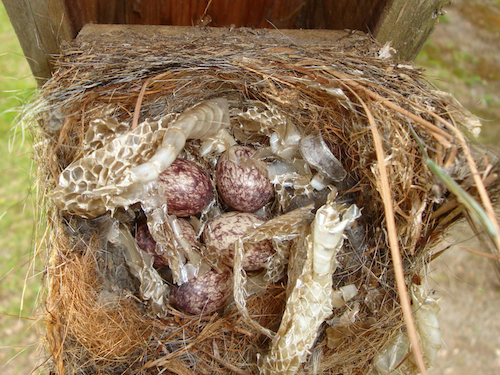
and the Ash-throated Flycatcher we have here out West.
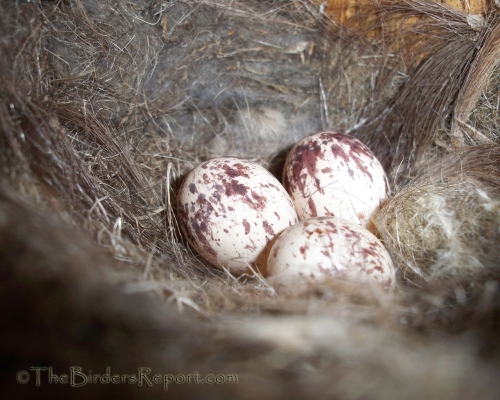
The Ash-throated Flycatcher nestlings day 1 …
Ash-throated Flycatcher nestlings day 10
Oak Titmouse Nest, Eggs and Nestlings
Oak Titmouse in nest …
Oak Titmouse nestlings day 1
Oak Titmouse nestlings Day 4
Black-crested Titmouse Eggs and Nest
These photos of the Black-crested Titmouse and its nest and eggs were taken by John from Blanco Texas. The nest has a base of moss and dead leaves; and a cup of hair, fibers, fur, wool, cotton, and similar material, and sometimes pieces of snake skin.
This is female inside the nest box …
and a couple of photos of the eggs.
White-breasted Nuthatch Nest and Chicks
White-breasted Nuthatches nests are floored with bark flakes and strips and lumps of earth; with a cup of finer bark shreds, grasses and rootlets, but mainly lined with fur, wool, hair and feathers. Their eggs are smooth and slightly glossy usually white, sometimes tinted creamy or pink. Speckled and spotted with light red, reddish-brown, brown, and purplish-red, and sometimes paler gray and purple. You can see a photo of them on my friend Bet’s page here. Here is a close-up of the chicks in the nest.
House Sparrows are a non-native, invasive species in North America and are not protected by law. They will take over nest boxes and chase off or kill native birds. There are several things you can do to protect your nest boxes against this invader. For extensive information on this subject, please visit my friend Bet Zimmerman’s Page.
Wild Turkey Nest and Eggs
Wild Turkeys breed in more open deciduous forest, along forest edges and in clearings; and in more open and scattered woodland of dryer regions. Their nest is on the ground, usually near or under shrubby cover or against a fallen log or foot of a tree; occasionally among rocks or in an open site. This photo was sent to me from Ontario Canada by Sheila.
Sandhill Crane Eggs
These Sandhill Crane eggs are on display in the visitor center at Modoc National Wildlife Refuge. Greater Sandhill Cranes nest on the refuge, sometimes very close to the auto tour loop, where they build their nests near open water in areas of tall grasses or rushy vegetation. They build a large nest on the ground or in shallow water, creating a heap of plant material on low ridges or a dry hollow, with an outside diameter of 3 to 5 feet. The eggs are about 3 1/2 inches by 2 1/2 inches.
Turkey Vulture Nest and Eggs
This photo of a Turkey Vulture nest with eggs was sent to me by Nancy from North Carolina. Turkey Vultures breed in a variety of habitats, usually in secluded and undisturbed sites. The nest may be in a cave or rock recess, in an unused building, hollow log or stump or on the ground in thick cover or a swamp. A dark site is preferred.
American Kestrel Nest and Eggs
This is a photo I took while helping my friend Steve monitor some of his American Kestrel boxes. He has over 75 Kestrel boxes he monitors every year, this being only a small percentage of the nest boxes he monitors. The American Kestrel lays 4 to 5 smooth, non-glossy, cream colored eggs, about twice the size of a Western Bluebird egg, with irregular brown spots. Notice they have only a small amount of sawdust as nesting material.
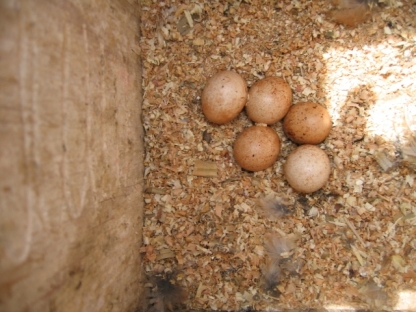
Chimney Swift Nest with Chicks
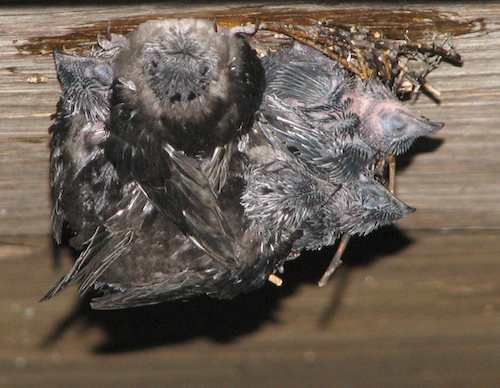
This was sent to me by Larry Arnold from Atlanta Georgia. He found this nest built inside his fireplace. This is a view looking down at the nest. He said that the baby’s singing for food filled the living room! That’s the adult bird right in the middle of the photo. The nest is a shallow half-cup of short dead twigs broken off by the birds in flight and glued together and to the wall by saliva! There is no lining and the eggs are white, 20 x 13mm.
Bushtit Nest
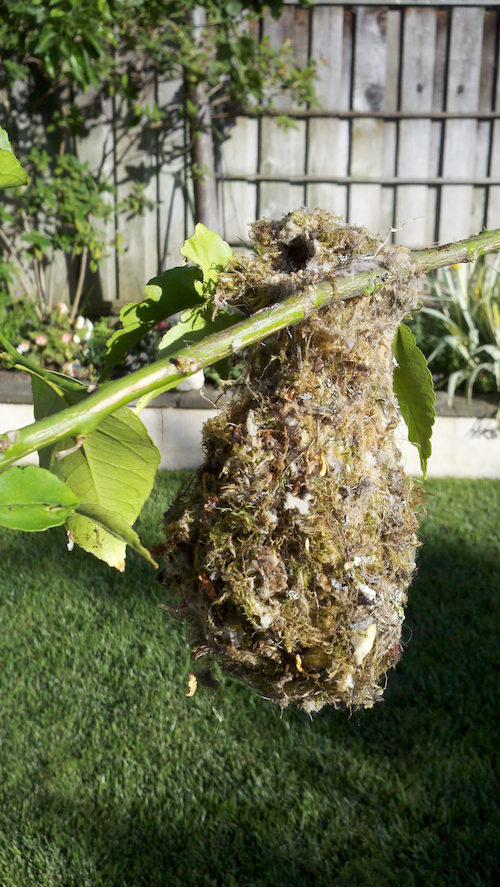
Here in the West and Southwest we have Bushtits. They build this elaborate pendulous gourd-shaped nest with a small, circular, side-facing hooded entrance near the top shown above, sent to me by Mark Prichard. The photo below was found by Chris Nelson in Chico, a community close to my location.
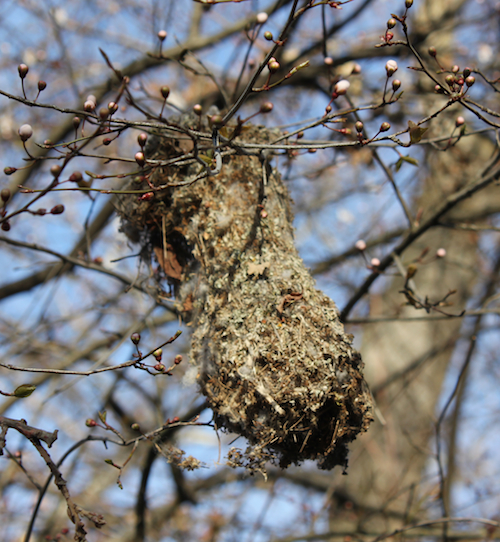
For more information on these cooperative breeders can be found in the post I wrote when I found a pair of Bushtits building a nest.
Mourning Dove Nest and Eggs
Mourning Doves breed in a wide variety of habitats. Open woodlands, cultivated areas with trees or shrubs, suburban gardens, semi-arid and arid areas within reach of water. Their nest is usually in a tree or shrub between 10 and 25 feet up; however, as you can se from these photos from some of my readers, they can be found almost anywhere. Their nest is a flimsy platform of twigs. They begin breeding in December to February in the south and April in the north. They have a long breeding season and will raise several broods per season. This photo was sent to me by Whitney from Louisiana.
Here’s a close-up of the chick and egg
Here’s a photo of a Mourning Dove nesting on the ledge of a building from Melanie.
And the same bird with the nestlings.
This bird decided the top of a light fixture was a good location from Christian in Florida.
And from Elizabeth in Denver, on her car in the garage!
And from Vinod in New Jersey, Mourning Doves eggs on the front door.
Whip-poor-will Nest and Eggs
The Whip-poor-will is a member of the Nightjar or Goatsucker family. They are nocturnal birds with large eyes, tiny bill, a large bristled gape, and very short legs. A voice in the night woods, they are more often heard than seen.
The Whip-poor-will breeds in drier, more open woodlands, or near woodland edge. They don’t build a nest but lay their two eggs on the ground in an open site under trees or under a bush, usually on a bed of dead leaves. A photo of this rare find was sent to me from Nicole in Pennsylvania.
Chuck-will’s-widow Nest and Eggs
The Chuck-will’s-widow is the southern cousin to the Whip-poor-will. It breeds in mixed oak and pine woods and lays two eggs on the leaves or pine needles of open ground under the trees. This photo was sent to me by Linda from Arkansas.
Ruby-throated Hummingbird Nest and Eggs
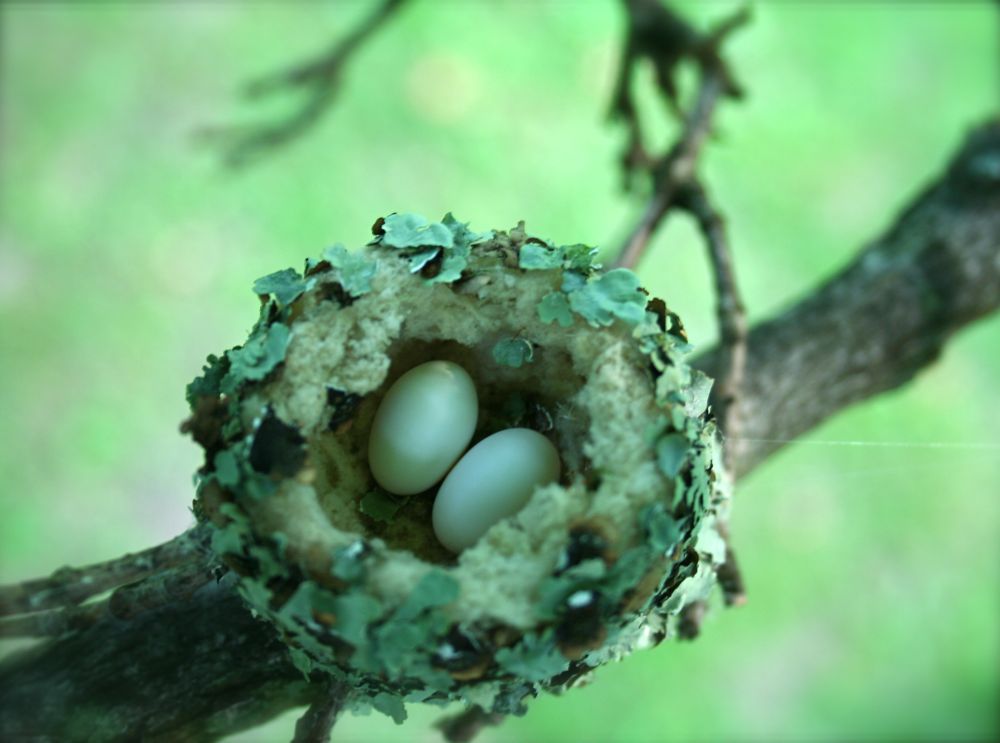
Here is a great photo of a hummingbird nest from my friend Nina over at Nature Remains. Go check out the entire photo story at her site. The typical hummingbird nest is tiny, about the size of half an English walnut shell. They are usually built on a small forked branch about the size of a pencil. The outer part is covered with moss and plant fibers to camouflage the nest. Sometimes it is shingled with lichens like this one. The rest of the nest is made of plant down and spider webs. Not just any spider webs either. Hummingbirds use only fresh spider webs made the same day, before any bugs are trapped in the webbing. Successful nests are usually built in a site that is out of the wind so the hummer moms can more easily control the nest temperature.
Anna’s Hummingbird Nest and Eggs
This photo of an Anna’s Hummingbird nest and eggs was sent to me by Cheryl from Salome, Arizona. Her friend Terry took the photos.
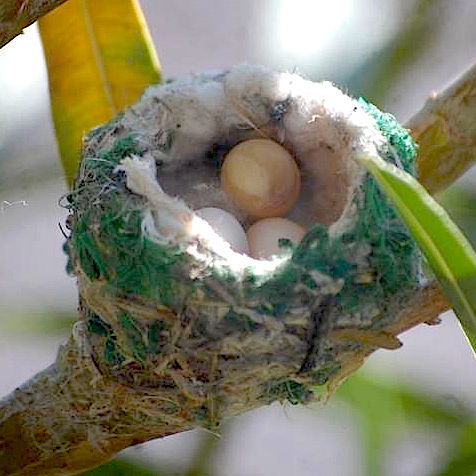
Here is the female hummingbird sitting in the nest
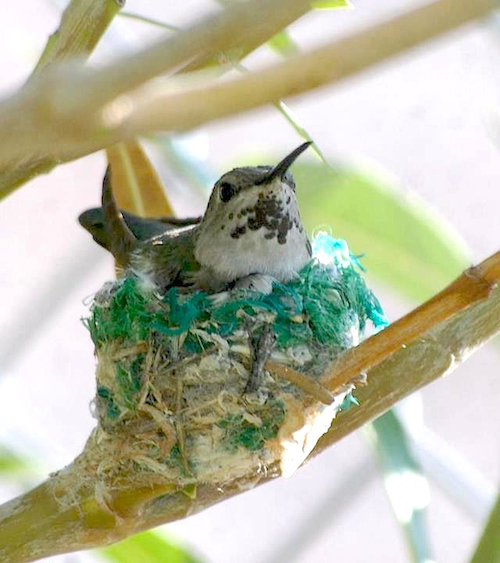
And finally, the first chick hatched. The yellowish egg is a mystery. I think it may be an unfertilized first egg, but you can see the other white egg and the dark colored chick with its black skin and gray down on the lower right.
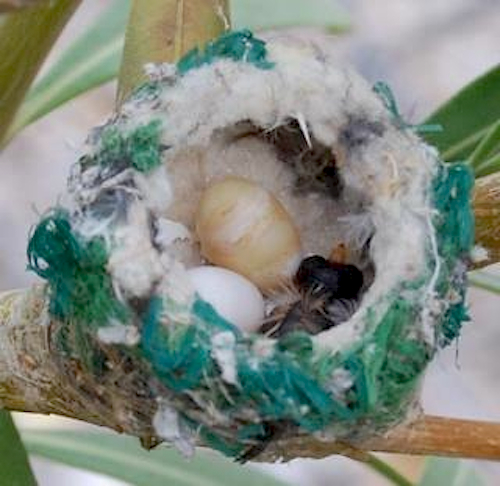
American Robin Nest and Eggs
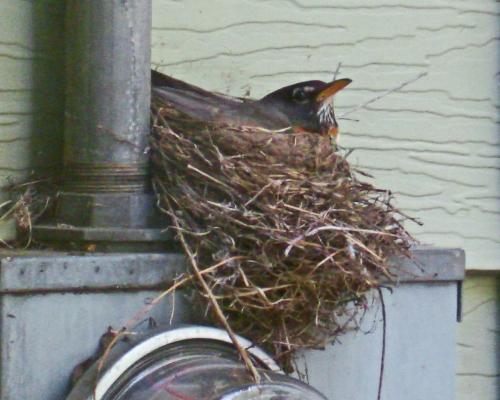
This photo of an American Robin sitting on the nest was taken by my brother at his home in Lake Tahoe. Robins will often build their nests on man-made structures in urban areas if other natural sites are not available. Rain gutters and any type of ledge, like this electric meter, will suffice.
The female selects the site and builds the nest which may be placed anywhere from the ground to the tree tops. She constructs the outer wall with dead grass and twigs, then brings in mud to reinforce the edge of the nest. Finally she will line the cup with fine dead grass.
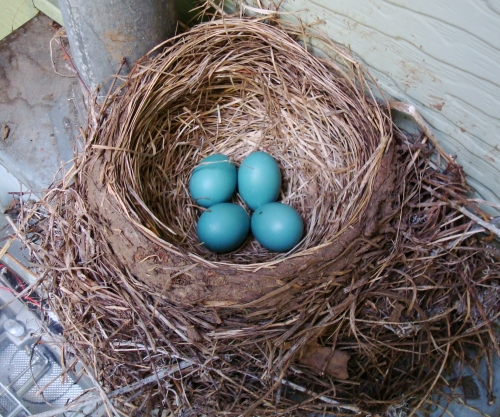
Diana from Hampden Maine sent me these American Robin photos of a nest she found in the top of her propane tank.
And a couple of photos of the newly hatched nestlings.
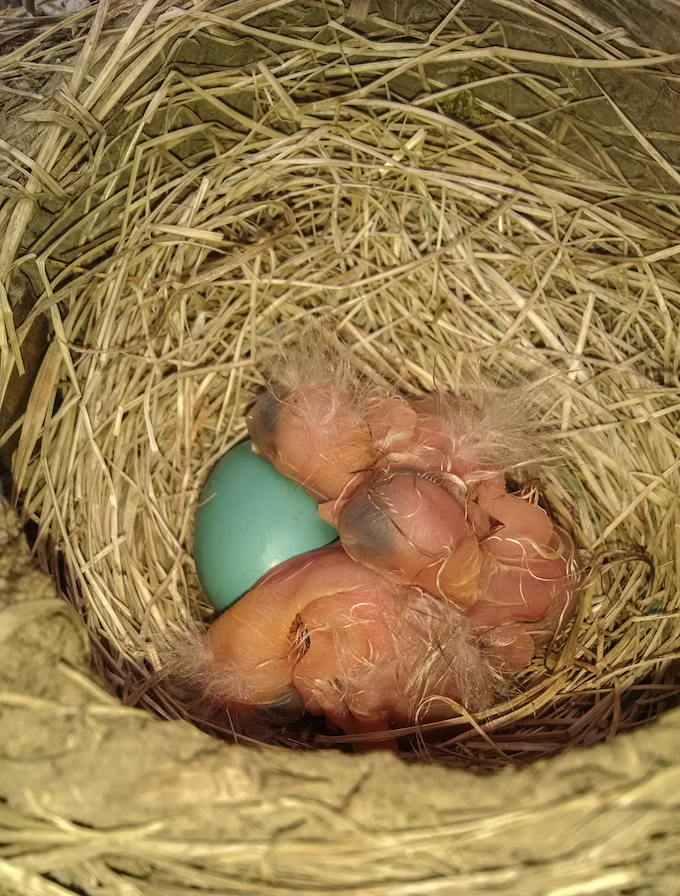
Sandra from Illinois sent me some photos of American robins nesting on the fire hose hook ups outside a fire house.
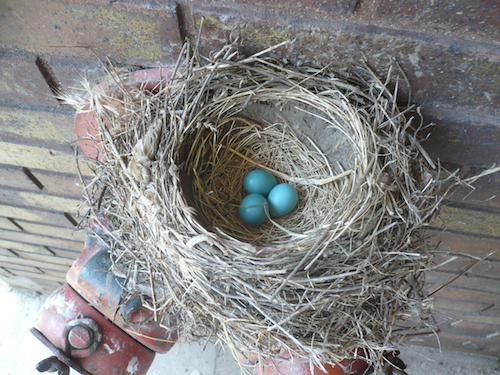
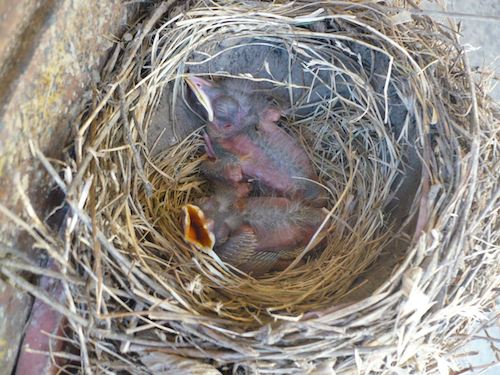
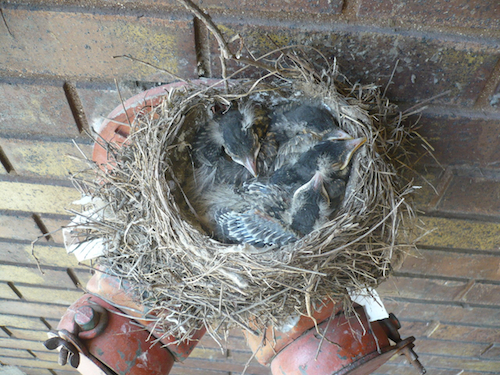
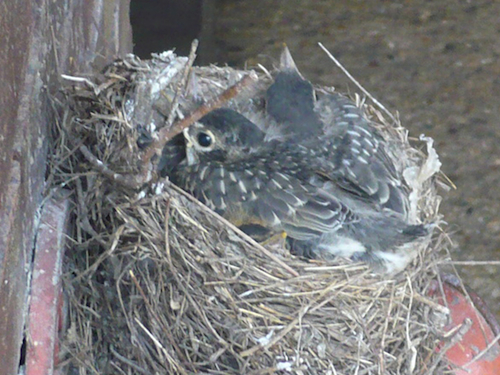
House Finch Nest and Eggs
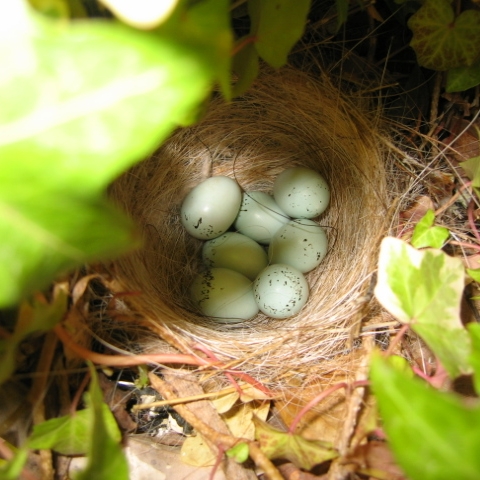
The House Finch is one of the most common backyard birds in the United States. Their nest sites include pine, spruce, and palm trees; cactus; rock ledges; vents, ledges, or ivy on buildings (including especially parking structures); street lamps; hanging planters; and abandoned nests of other birds. This nest was found in my neighbor’s hanging planter on her back porch. Read my post here.
This photo of a House Finch nest built in a wreath on the front door was sent to me by Terri from Denver.
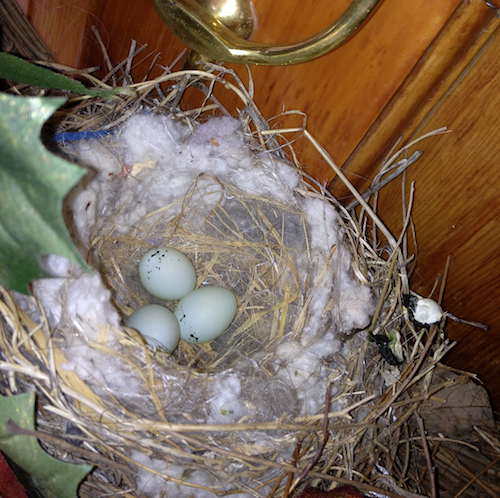
And from Bev in Tacoma Washington, House Finches nesting in a porch light
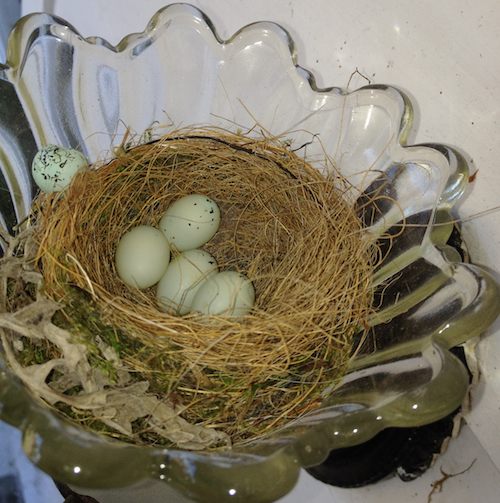
You can see the fecal droppings accumulate around the nest as the chicks grow
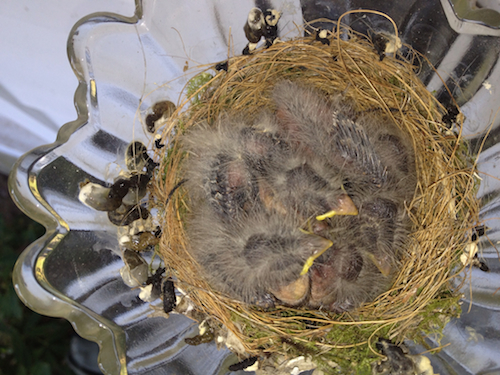
This is a shot of five newly hatched nestlings sent to me by Tera from Llano California. She found the nest in a small tree about four feet off the ground.
This is a House Finch nest that has been parasitized by Brown-headed Cowbirds. The cowbird eggs are the larger, brown speckled eggs.
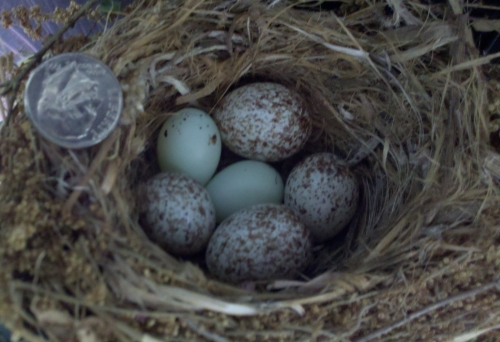
This is another great shot from Michael Jacobson in South Carolina, of a House Finch nest with five House Finch eggs and one Brown-headed Cowbird egg. You can read about the parasitic Brown-headed Cowbird here.
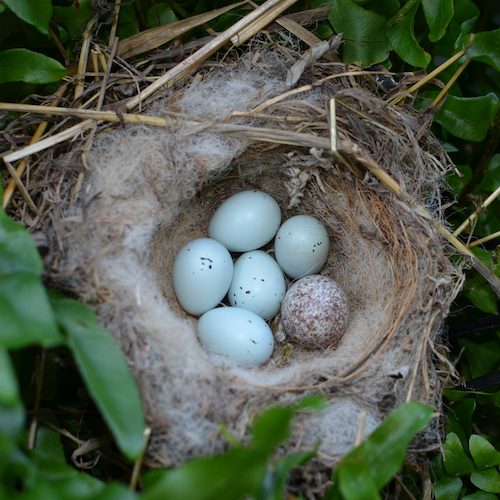
I have a video from a reader, Lacie from Indiana, of a House Finch nestling testing out its wings!
Mallard Nest and Eggs
The Mallard may be the most common duck found in North America. They breed near any type of fresh water, in a variety of habitats, though may be far from water. The nest is usually in cover on the ground, among tall vegetation, grasses, bushes, etc., and on small islands. The nest is a hollow lined with plant debris, leaves, grass, etc., the lining mixed with down and feathers. Down tufts are brown with paler centers and tips. Down covers eggs before incubation and when bird is away from nest. Outside diameter of nest is 11 to 12 inches, inside diameter 6 to 7 inches and depth, 4 inches. This photo from Shelley in Texas.
This is the female sitting in the nest.
I recently got some great photos from Jami in Michigan of a Mallard nest that was very close to her front porch. This is a photo of the nest and eggs.
And then they started to hatch…
are they cute or what?
American Coot Nest and Eggs
American Coot nests are built in stands of emergent vegetation along margins of ponds, lakes, larger pools, and particularly prairie potholes. Vegetated margins of swamps with some open water, canals, sewage ponds, and slower-moving rivers are also use. The nest is a bulky cup of dead leaves and stems of waterside plants, often well raised. The outside diameter of the nest is 14 to 20 inches and the inside about 7 inches. These photos were sent to me by Mark Dakin from Oregon.
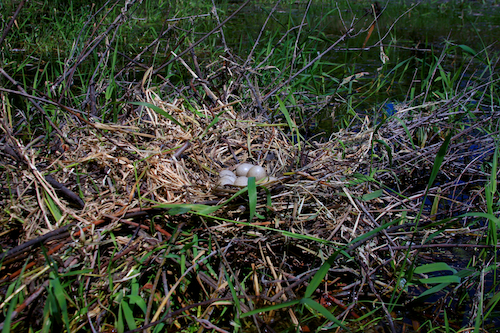
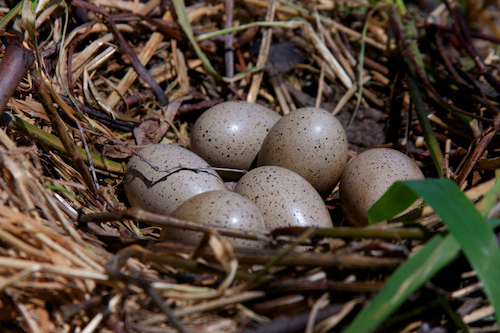
Killdeer Nest and Eggs
This is a typical Killdeer nest and eggs. The nest begins as a simple scrape in the ground but as laying and incubation progress, rocks, bits of shell, weed stems, or other material are added. Killdeer commonly nest on graveled road shoulders and in parking lots as well as on flat graveled rooftops. See my post here.
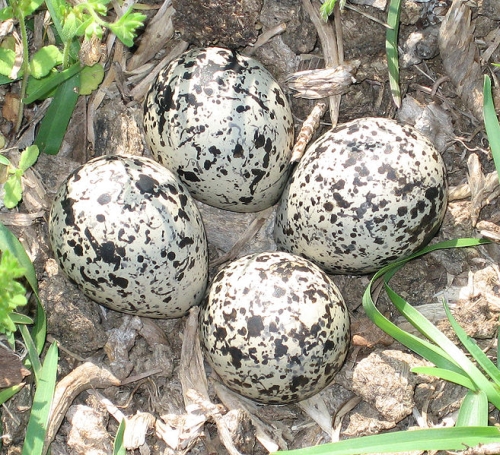
American Oystercatcher
Another bird that nests in a scape or shallow hollow is the American Oystercatcher. Richard sent me this photo of their eggs from Tampa Florida. The American Oystercatcher breeds in open sites on coastal beaches, among rocks on islands, in dunes or on shingle beds; occasionally on saltmarsh. Their nest is a shallow hollow, unlined or with pieces of dead plants, small stones, broken shells, or other debris. Often on a small mount serving as a lookout. This clutch is probably not complete as they almost always lay three eggs.
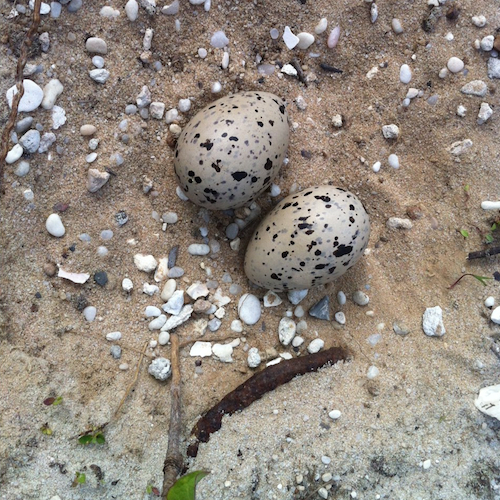
American Woodcock Nest and Eggs
The American Woodcock breeds in woodland sites, in low shrubby cover, or tall herbage, bordering clearings, in thickets or under scrub oaks or pines, or in open woodland with dead leaf cover on the ground, usually near a moist area. This first egg photo was sent to me by Michael from Ohio.
These next two photos were sent to me by Debbie from Michigan. The first is the Woodcock nest with eggs and the second image is a photo of the bird incubating the eggs.
Another photo of the American Woodcock nest and eggs from Philip, also from Michigan.
House Wren Nest and Eggs
The House Wren breeds over a wide range of country, from open woodland to cultivation and human settlement, wherever there is a low shrubby cover and thickets, with holes or niches for nesting. This particular bird decided to build a nest in a cardboard box in Virginia. The photos were sent to me by Linda.
This close up of House Wren eggs is from Rebecca who lives in California.
Bewick’s Wren Nest and Eggs
The Bewick’s Wren breeds in generally open woodlands and drier thickets, orchards, fencerows, and gardens and shrubby growth around houses, replacing the House Wren in some areas. They nest in a small natural cavity in a tree or post, woodpecker hole, crevice in a tree, wall or building, or between rocks or in a brush pile, hole in a bank, or any kind of hollow object, including a nest box or apparently a tractor!
Their nest is a bulky deep and irregular cup in a mass of varied material; plant material, bark and wood chips, rootlets and sticks; lined with feathers, moss, wool, hair, fur, and similar material; and like the House Wren, liable to incorporate almost any material into the nest. These photos were sent to me by Lance from Liberty Hill Texas.
In the lift arm of his tractor …
and here is a better shot of the eggs.
And this excellent photo of the Bewick’s Wren’s eggs from Amber in Santa Cruz, California
Carolina Wren Nest and Eggs
Here are some photos sent to me from Katherine in Atlanta, Georgia, of a Carolina Wren nest and eggs she found in her daughter’s playset refrigerator.
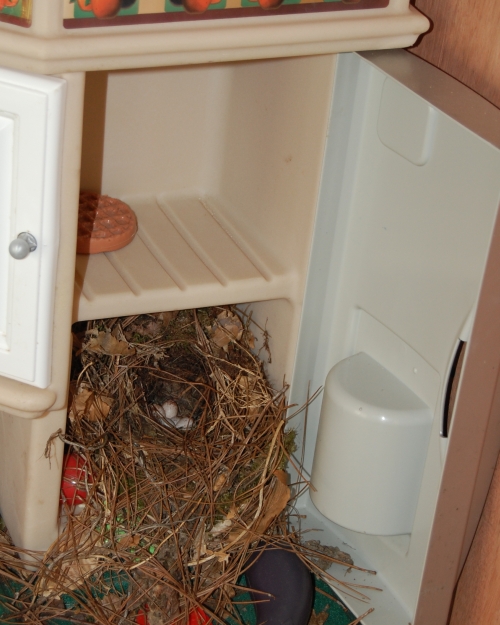
Isn’t that amazing nest construction? Look how well placed those leaves are around the perimeter.
Here is a better photo of the Carolina Wren eggs
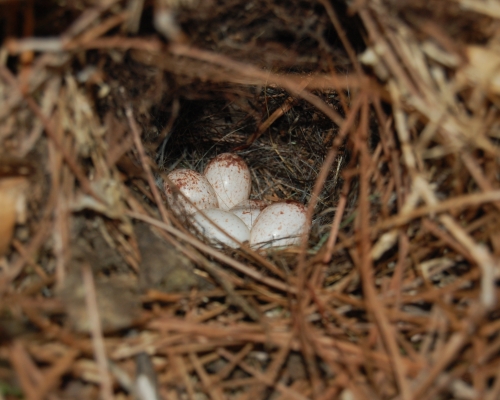
We hope for a successful outcome with the possibility of five new Carolina Wrens for the state of Georgia!
~~~~~~~~~~~~~~~~~~~~~~~~~~~~~~~~~~~~~~~~~~~~~~~~~~~~~~~~
Here is another Carolina Wren nest and eggs in a hanging basket from Judy in Texas. Notice the typical domed style used by this species when the nest is not in a confined space like a nest box or the “refrigerator” above
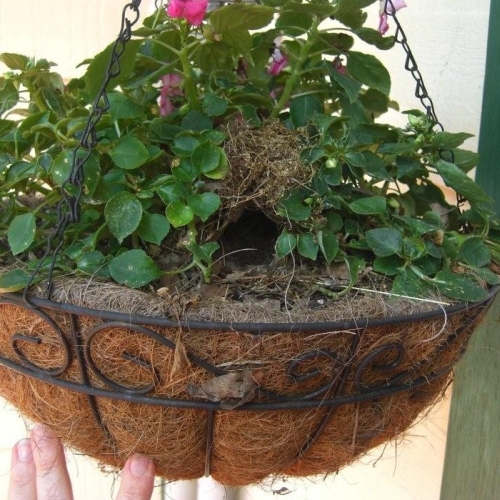
Here is a shot of the eggs through the domed entrance
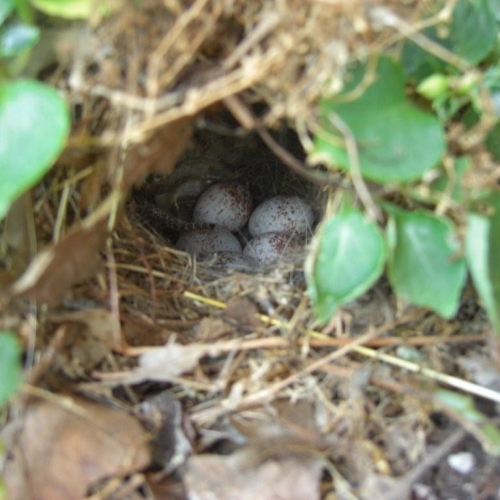
And a close up of the eggs where you can see what looks like a snake skin
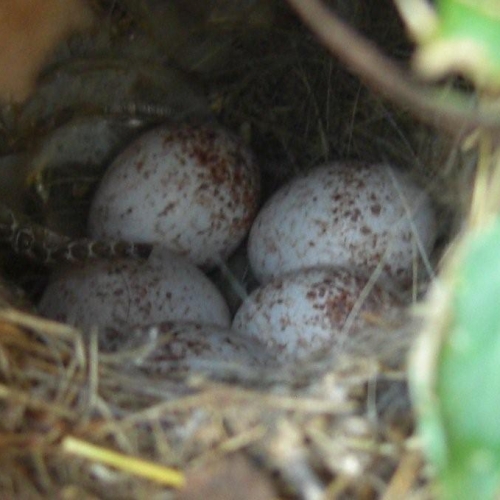
~~~~~~~~~~~~~~~~~~~~~~~~~~~~~~~~~~~~~~~~~~~~~~~~~~~~~~~~
More Carolina Wrens from Kirsten in Texas. This nest was discovered in a folded up lawn chair. Thanks for the great photos Kirsten!
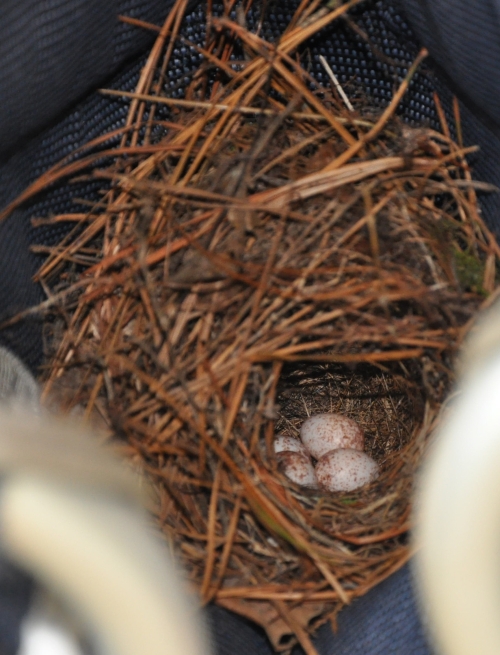
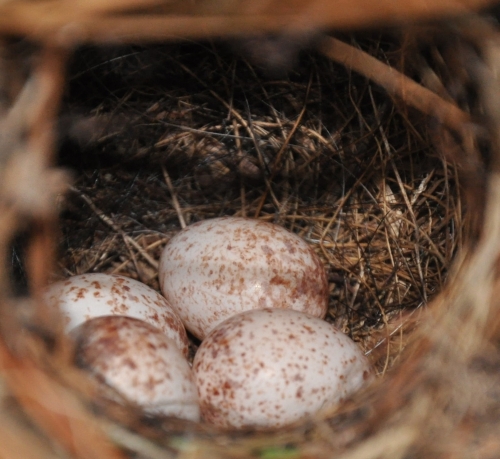
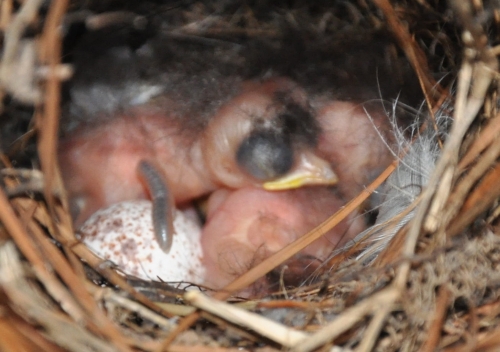
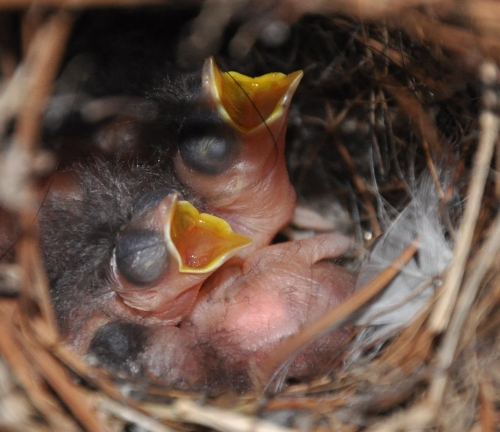
~~~~~~~~~~~~~~~~~~~~~~~~~~~~~~~~~~~~~~~~~~~~~~~~~~~~~~~~
Check out this Carolina Wren nest found by Laura in North Carolina. It was in a sweatshirt hanging on the clothesline.
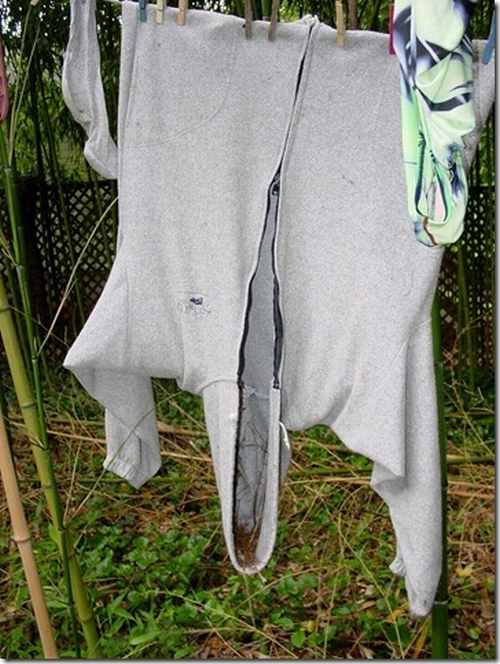
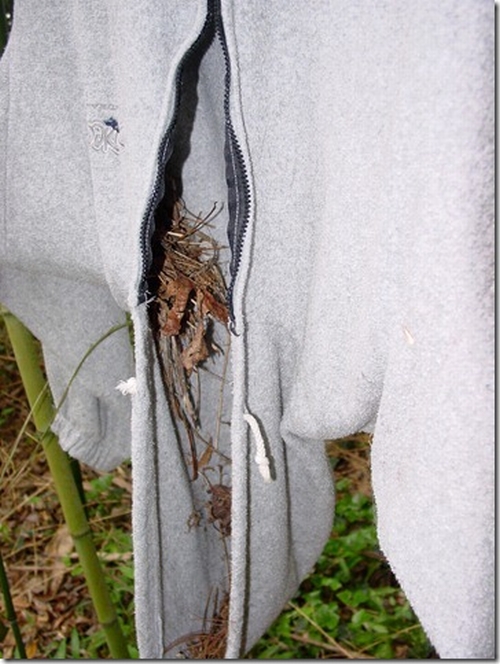
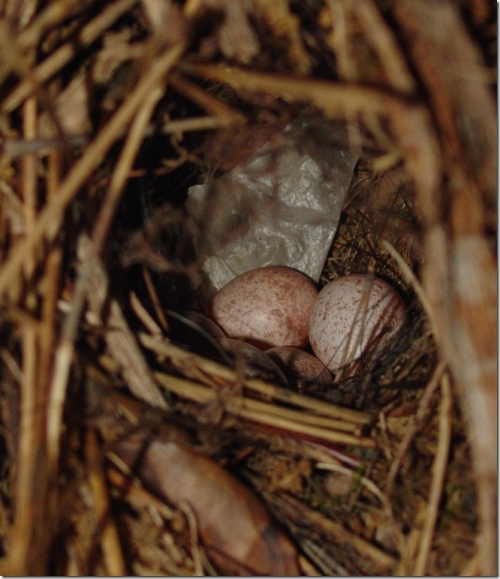
~~~~~~~~~~~~~~~~~~~~~~~~~~~~~~~~~~~~~~~~~~~~~~~~~~~~~~~~
And yet another Carolina Wren nest from Fannie in Virginia. She found this nest in a feed bucket by her rabbit hutch.
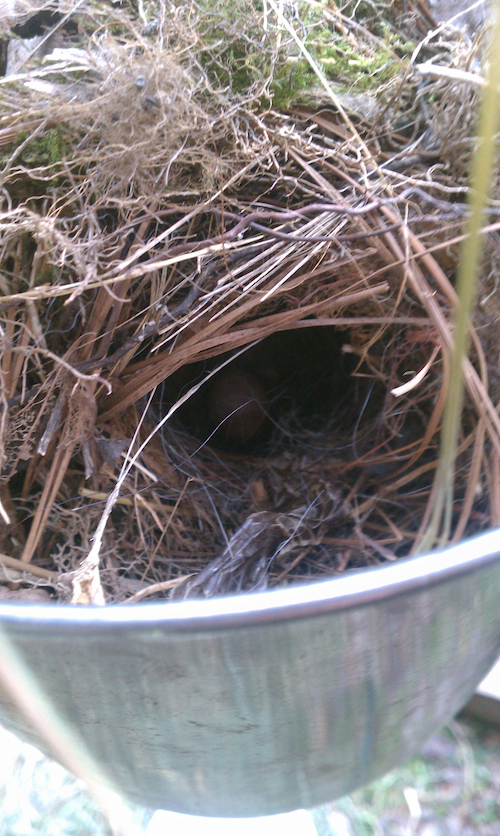
And a close-up of the egg
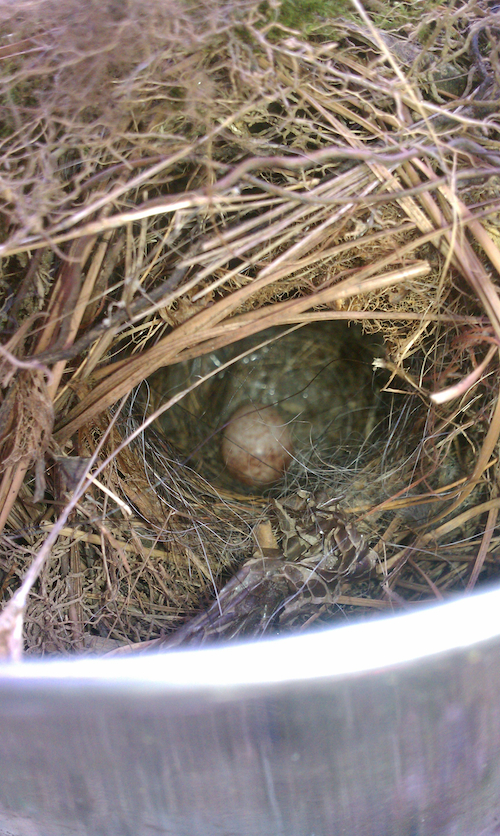
~~~~~~~~~~~~~~~~~~~~~~~~~~~~~~~~~~~~~~~~~~~~~~~~~~~~~~~~
This nest was found in a BBQ in Florida
~~~~~~~~~~~~~~~~~~~~~~~~~~~~~~~~~~~~~~~~~~~~~~~~~~~~~~~~
And another photo of the Carolina Wren eggs…
and Momma Wren sitting in the nest!
~~~~~~~~~~~~~~~~~~~~~~~~~~~~~~~~~~~~~~~~~~~~~~~~~~~~~~~~
This is a photo from Ann in Texas of four Carolina Wren chicks three or four days old.
Carolina Wren nests are typically 6 feet or less off the ground. They are often bulky and constructed loosely of bark strips, dried grasses, dead leaves, oak catkins, sticks, pine needles, mosses, hair, feathers, light straw, wool clumps, shed snake skin, paper, plastic, and string.
This nest was discovered by Amanda’s husband in Texas when he went to turn on the family grill. There was a bucket over the propane tank acting as the “roof” this wren usually constructs.
She sent me this great photo of the two youngsters that made it. You can see that there is an unhatched egg still in the nest.
Marsh Wren Male Building Nest
This is a photo of a male Marsh Wren building a nest at Sacramento National Wildlife Refuge. You can see the full sequence of photos and watch a video I filmed on my post here. You can see the eggs here.
Cactus Wren Nest
The Cactus Wren breeds in arid regions with low scrub growth and cacti. The nest is a bulky conspicuous mass on a cholla cactus, in a low twiggy tree or shrub, often thorny, or on top of a yucca; occasionally in buildings. It is a large domed structure about 12 inches in diameter. This photo was sent to me by a reader in Texas.
This is another Cactus Wren nest sent to me by Terry from Vail Arizona. Note that it is growing in a Palo Verde tree rather than the typical cactus.
Northern Cardinal Nest, Eggs and Nestlings
These photos of the Northern Cardinal nest, eggs and nestlings were sent to me by one of my readers, Cindy Griffin. You can visit her Flickr page here.
The nest not attached to the substrate; it is wedged into position. The bowl-shaped structure is composed of 4 layers: a rough outer material, leafy mat, grapevine bark, and grassy lining. It may contain weed stems, pliable twigs, strips of bark, grasses, vines, rootlets, leaves, and pine needles. Paper and plastic are common in the outer cup as seen in this nest.
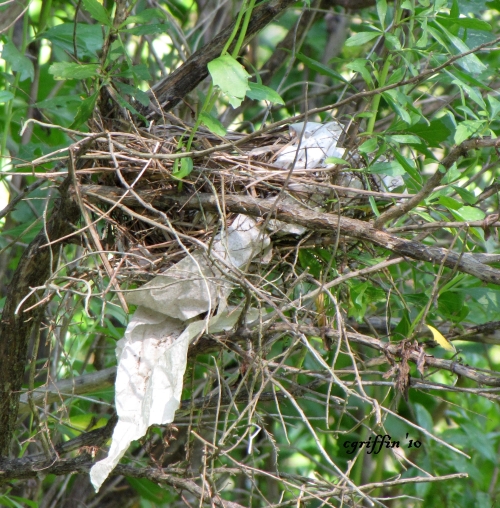
Here you can see the pine straw making up the inner cup
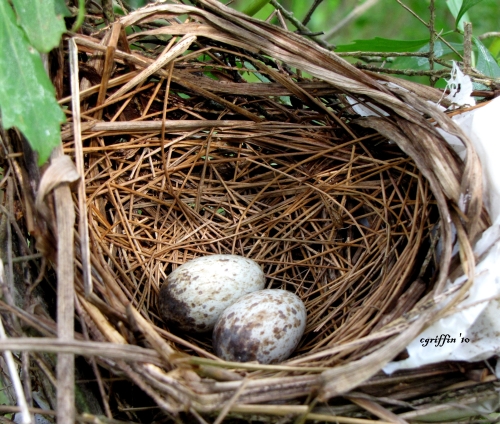
And two healthy newborn nestlings!
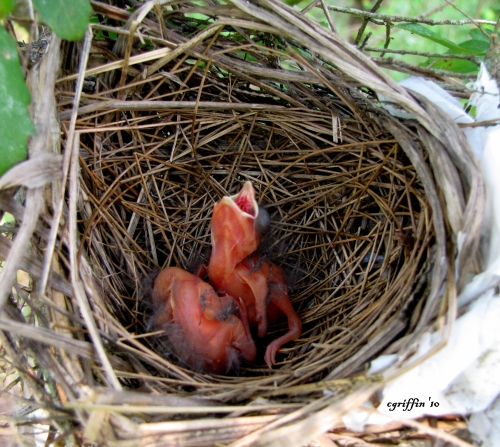
~~~~~~~~~~~~~~~~~~~~~~~~~~~~~~~~~~~~~~~~~~~~~~~~~~~~~~~~
Carmen sent me photos of this Northern Cardinal nest in Texas which has been parasitized by a Bronzed Cowbird. The Bronzed Cowbird egg is the light blue, unmarked egg in the nest.
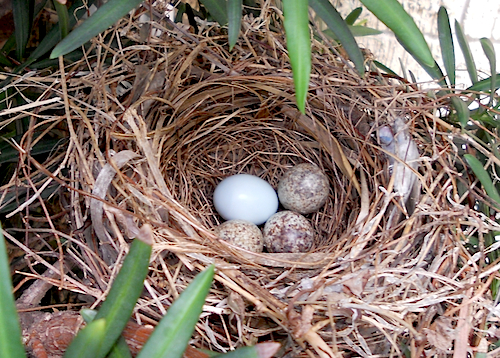
These are the chicks shortly after hatching, hard to tell one species from the other
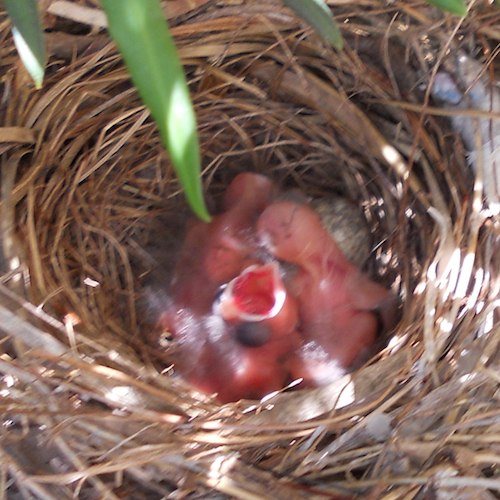
As the chicks get older, you can begin to see the difference
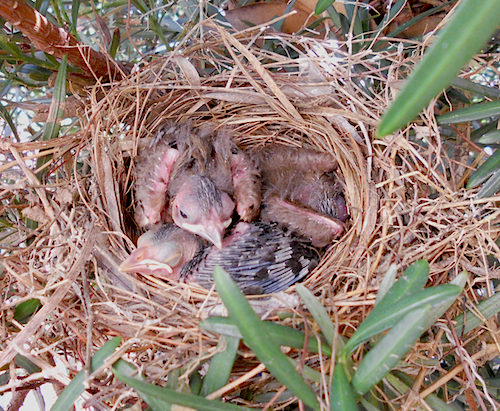
The Northern Cardinals have the brown plumage (in the foreground) and the Bronzed Cowbird has the darker feathering coming in and has its eyes open.
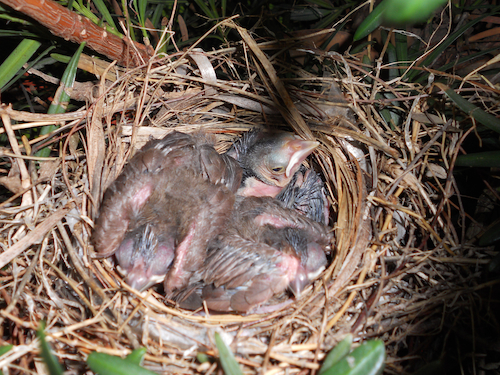
Pyrrhuloxia Nest and Eggs
Pyrrhuloxia breed in more arid regions, on mesquite edge and in more open sites in shrub growth than the Northern Cardinal uses. They nest in a shrub, 5 to 7 feet up, in a twig fork or against the trunk. The nest is a small and fairly compact cup, but with a loose outer layer of dry twigs, weed stems, coarse grass, bark fibers, and spider’s webs; lined with fine grasses, fibers, rootlets, and hair. This photo sent to me by Amanda from Texas.
Indigo Bunting Nest and Eggs
These excellent photos were sent to me by Jacinda from Ohio. The Indigo Bunting breeds in scrub, on forest edges and clearings, and in hedgerows and orchards. The nest is in a shrub, low bush, tree sapling, vine tangle, or on tall weeds; usually in a twig fork 5 to 15 feet up, sometimes lower.
This is what the nest looks like among the corn stalks.
Eastern Meadowlark Nest and Eggs
The Eastern Meadowlark breeds in open grassland, meadows and pastures, and in similar low herbage such as clover, alfalfa, or young corn. Their nest is on the ground in growing herbage, concealed by a domed top and overhanging grasses. This nest photo was sent to me by Josh from Rochester New York. You can see a photo of the eggs here.
Western Meadowlark Nest and Eggs
The Western Meadowlark makes a similar nest to its Eastern cousin. These photographs were taken by Jennifer in California.
Brown Thrasher Nest, Eggs and Chicks
This is a Brown Thrasher sitting in her nest from Mike Whalen
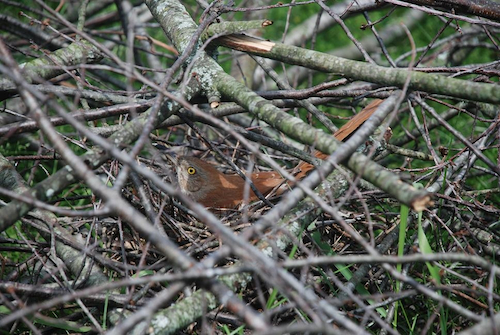
Brown Thrashers nest very low in a shrub or bush, near the ground , or on the ground under a bush, shrub or small tree. Rarely more than 7 feet up, usually under 3 feet. The nest is a cup with a loose outer layer of twigs, then dead leaves, bark, small twigs, and grass stems, lined with rootlets or fine grasses.
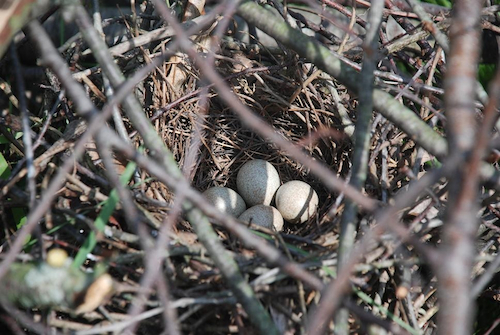
The chicks have dark pinkish-flesh colored skin. Their down is dark gray on their head, back, wings and thighs. Their mouth is creamy yellow, orange towards the throat and their gape flanges are white.
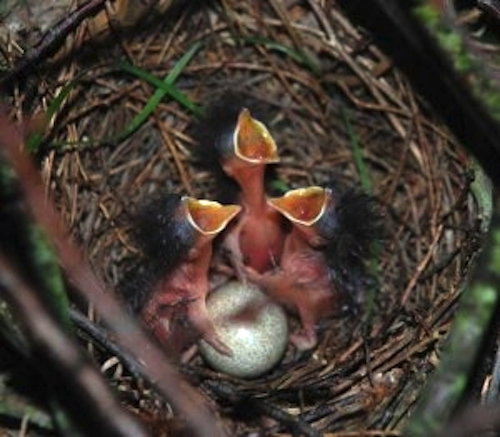
Gray Catbird Nest and Eggs
The Gray Catbird breeds over a wide range in low thick vegetation, often bordering woodland marshes or watercourses; or in hedgerows, orchards, or shrubberies. The nest is usually low, 3 to 10 feet up in a small tree, shrub, or bush; sometimes much higher, up to 60 feet in trees or rarely on the ground in a tree cavity. Similar to the Mockingbird, the nest is a bulky and thick cup of coarse sticks, weed stems, grapevine, leaves and grasses; lined with fine rootlets, bark shreds, decayed leaves, and pine needles, and sometimes hair. Other material, string, cotton, or rags may be incorporated. This photo of the nest and eggs was sent to me from Philadelphia by Betzalel.
And here is her photo of the nestlings.
Northern Mockingbird Nest and Eggs
Daryl’s tractor quit on him in the field last November and when the weather got good enough for him to check it out, he found this Northern Mockingbird nest had been built in the fan shroud.
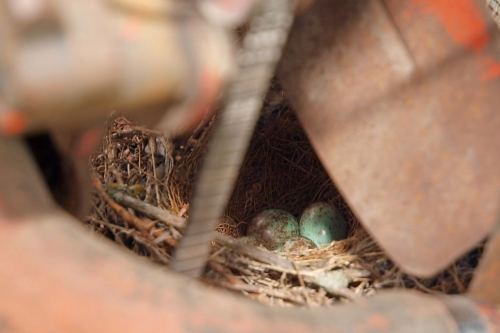
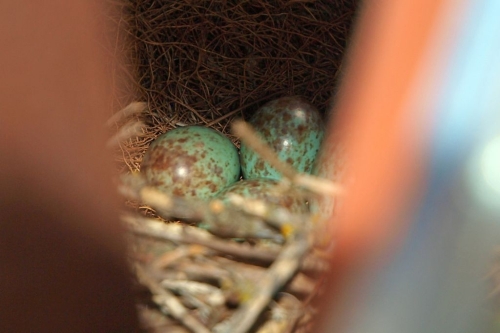
This Northern Mockingbird nest was discovered by Kim in Orlando Florida, in the crotch of a pear tree.
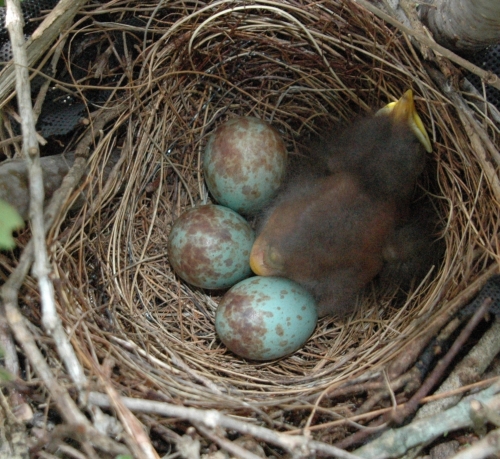
This is a great photo of a Northern Mockingbird nest with eggs from Tiffany in Louisiana.
And another showing the Mockingbird’s use of sticks in the nest from Kathy in Oklahoma.
This series of Northern Mockingbird photos was sent to me from Georgia by Shelley, beginning with the nest…
and the newly hatched chicks…
followed by the 5 day old chicks in the nest!
California Thrasher Nest and Eggs
The California Thrasher breeds in chaparral, scrub of lower mountain slopes, and along watercourses. They nest in a low tree or shrub, usually 2 to 4 feet up, but occasionally up to 9 feet. This bird was nesting in a friend’s yard.
Curve-billed Thrasher Nest and Eggs
The Curve-billed Thrasher breeds in arid places with sparse scrub growth and cacti, open areas in chaparral with prickly pears, and around settlements in arid areas. They frequently nest in cholla cactus, 3 to 5 feet up, or in low trees where they may nest up to 12 feet. These photos were sent to me by Kayla from Arizona.
European Starling Nest and Eggs
The European Starling is an introduced species from Europe that breeds in a range of habitats where cavities occur near open areas of herbage. These photos of their nest and eggs was sent to me from Dick and Joan in Tennessee. They found the nest in their barbecue when they opened it up for the first time to use it in the Spring. You can see a post I wrote on this ubiquitous bird which includes a magnificent video of a murmuration of Starlings.
Cordilleran Flycatcher Nest and Eggs
This uncommon Western Empidonax Flycatcher breeds in shaded woodlands in foothills and on lower mountain slopes, usually near streams or moist ravines. They nest in a sapling or shrub, in a cavity in a tree trunk, a crevice or cavity in a rock face, a mine shaft, or on a ledge, on a a stump, or among tree roots by a stream, in or under low banks of streams, or on ledges or in crevices of buildings. This photo was sent to me from Steve in Telluride Colorado.
The nest is a cup of green moss with a lining of finer materials and hair. Sometimes it includes bark strips, fine rootlets, and dead leaves with a fine lining. Isn’t that a cool nest?
Scissor-tailed Flycatcher Nest and Eggs
This beautiful Flycatcher breeds regularly from southeastern Colorado, southeastern New Mexico, south Nebraska, southwestern Missouri, western Arkansas, and western Louisiana south through southern Texas. This is a photo of the eggs and nest from Michael in Texas.
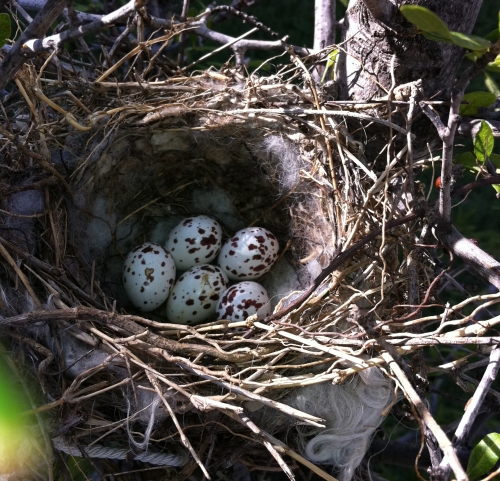
And more great photos of the Scissor-tailed Flycatcher from Denise in Oklahoma City
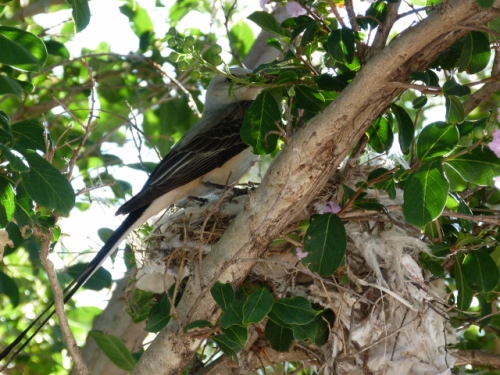
Scissor-tailed Flycatcher Eggs
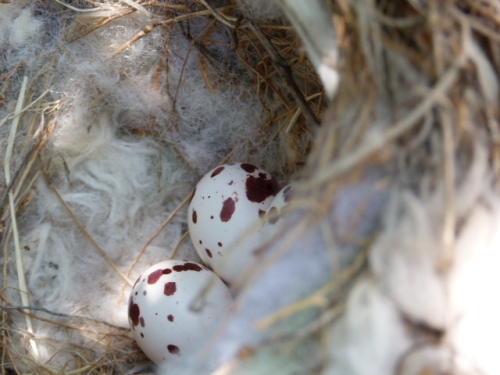
Scissor-tailed Flycatcher chicks in Nest
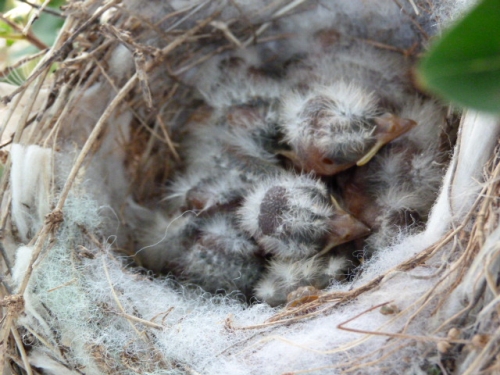
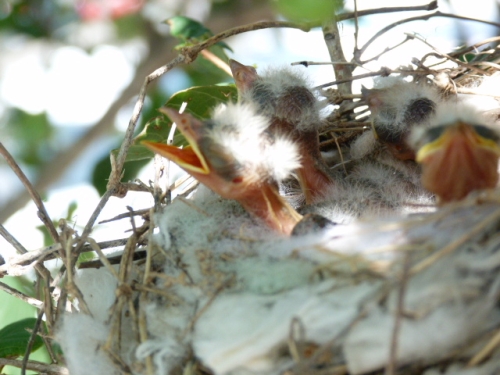
Eastern Kingbird Nest and Eggs
The Eastern Kingbird breeds over a wide range, preferring open areas (eg. farmland) with scattered trees, or forest edges. Nest usually towards the end of a horizontal branch of a tree. Often over water. Where trees are absent, post or stump may be used, sometimes standing in water. The nest is a large, deep cup, with loose material at the outside; of thin twigs, dry weed stems, straw, twine, plant down, and hair, sometimes with feathers, string, and pieces of cloth or wool; with lining of fine grass, rootlets, and hair. These photos are from Stephanie in Vermont.
She got some nice photos of the nestlings…
this one showing their gape which is often a good nestling identifier.
These photos from Jodie in New York shows the diversity of nests built by Eastern Kingbirds. This one built in a roll of rope on top of a slide.
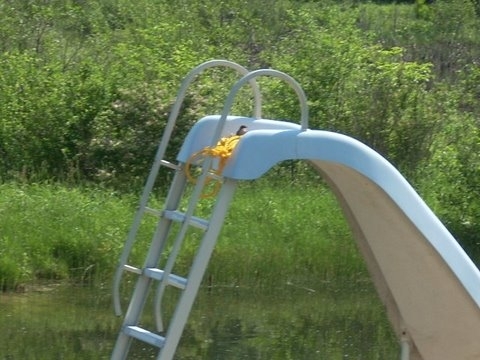
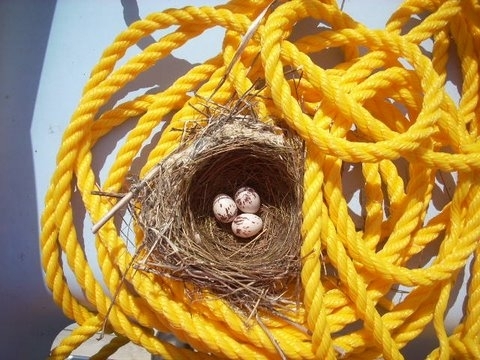
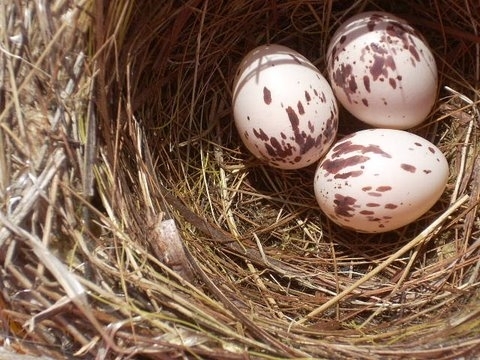
Black-throated Sparrow Nest and Eggs
This photo of the Black-throated Sparrow nest and eggs was sent to me by Maria from Nevada. This beautiful sparrow breeds in arid or desert areas with sparse cover of shrubs or cactus. They nest low in a small bush or cactus from 6 to 18 inches up, in a fork. The nest is a cup of fibers, blades and stems of grasses, weed stems and small twigs; lined with fur, hair, wool, fine grasses, and plant down, usually pale in color.
Chipping Sparrow Nest and Eggs
Chipping Sparrows breed in open woodland, on woodland edge and in clearings in parkland, cultivation with trees and in gardens. Their nest is in a tree, usually in a conifer, a shrub or a vine, occasionally in other sites, from 3 to 60 feet up but mostly between 3 and 20 feet up. This nest was found by Sasha’s three year old son in a gooseberry bush in Nebraska. You will note that there is a Brown-headed Cowbird egg in the nest with the three sparrow eggs.
Another Chipping Sparrow nest with a Brown-headed Cowbird egg from Jim in British Columbia.
Savannah Sparrow Nest and Eggs
The Savannah Sparrow breeds in open areas with grass or short vegetation, including meadows, dunes, tundra, sedge, bogs, prairie, salt marsh, and grass islands. They nest on the ground, sunk in a small hollow and usually concealed by a tuft of vegetation overhanging it. This photo submitted by Don from Point Reyes California.
Song Sparrow Nest and Eggs
The Song Sparrow breeds in low shrubby growth and thickets in a variety of habitats, but most often in moist or swampy places. Earlier nests are mostly on the ground under a tuft of grass or weed clumps. Later nests often in shrubs or trees, usually up to 4 feet.
White-crowned Sparrow Nest and Eggs
The White-crowned Sparrow breeds in open, stunted woodland and scrub in the north, similar habitat on western mountains and in cleared, cultivated, or burnt-over areas in forest. The nest is on the ground, partly concealed in moss and low shrubby growth, or in or under a grass tuft or fern, orat the base of a shrub. They can also be a few feet above the ground in a bush or low tree branch, exceptionally mush higher. These were sent to me by Danielle from Washington.
Dark-eyed Junco Nest and Eggs
Dark-eyed Juncos nests are rarely higher than 8 feet up. They nest in open woodland and forest edge. The nest is on the ground among tree roots or partly hidden by brushwood, stump or rock. They will also nest in low shrubs or on conifer branches. This photo was sent to me by Shawn and Kelly Benshoof.
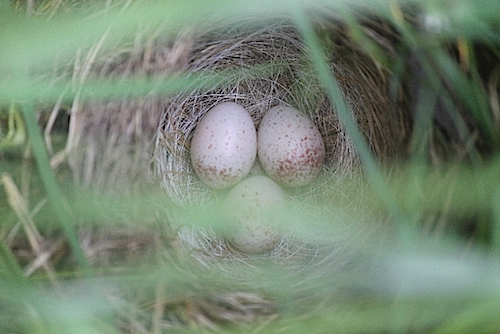
Here is another Dark-eyed Junco nest from Jennifer in Redmond, Washington.
Red-winged Blackbird Nest and Eggs
Red-winged Blackbirds usually breed on or over water in marshes, swamps or wet meadows, or in tall herbage bordering open water or slower streams; in cattails, rushes, sedges, large grass tussocks, waterside shrubs, or low trees. Occasionally in shrubs, bushes, and tall herbage some distance from water. This photo sent to me from Ingrid in Pennsylvania.
Common Grackle Nest and Eggs
The Common Grackle breeds through open and cultivated country, especially in wetter areas. They nest in trees, particularly conifers, in low shrubs and bushes, on dry land and in marshes, and in tall swamp vegetation. Also in shade trees around houses, and in niches and ledges on or in buildings. They nest from ground level to 45 feet up.
The nest is a bulky, externally loose cup, of twigs, weed stems, coarse grasses, Usnea lichen, Spanish Moss, pine needles, or seaweed in some areas, and an inner cup of mud or dung; lined with fine dry grasses and rootlets, a few feathers, or hair, and sometimes paper, string, or rags. These photos of the nest with eggs and the nestlings were sent to me from New York by HW.
Hooded Oriole Nest
This is a Hooded Oriole Nest attached to the underside of a giant Bird of Paradise leaf, submitted by Chris in Carlsbad California.
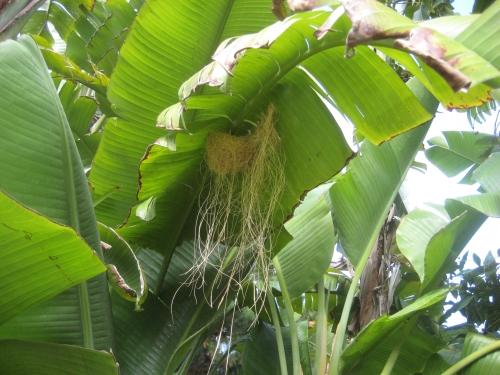
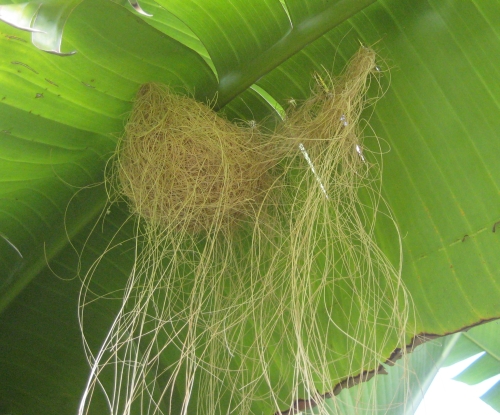
Orchard Oriole
The Orchard Oriole nest is suspended from a forked twig like that of Baltimore Oriole, but is never deep enough to be termed “pensile” and its depth is usually less than the nest’s outside diameter. The nest is composed of green grass, which becomes yellow when dried; lined with fine grasses, vegetable down, catkins, cotton, animal wool, bits of yarn, and feathers; sometimes it is not lined. This is a photo sent in by Wendy from Averill Park New York of an Orchard Oriole nest
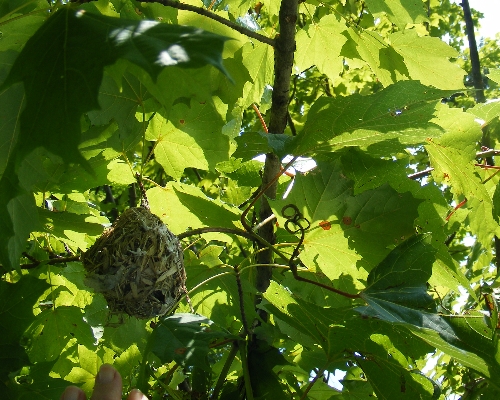
And this photo of the nest with an egg inside was sent to me from Brittany in Oklahoma.
Baltimore Oriole Nest
The Baltimore Oriole breeds in open woodlands, in shade trees, orchards, wooded residential areas, and similar sites. Their nest is suspended in a twig fork, usually at the end of a branch, mostly about 25 to 30 feet up, sometimes 6 to 90 feet up. The nest is a deep pensile pouch about 6 inches long, bound to forked twigs at its rim and with twigs sometimes extending down and bound to the sides. Of long plant fibers, vine bark, hair, string, yarn, and other similar human-made products when available, and other material including Spanish Moss in some locations, woven into a deep cup; lined with hair, plant down, wool, and fine grasses. This photo was sent to me by Stephanie from Nashville.
Bullock’s Oriole Nest
Bullock’s Oriole nests are suspended in a twig fork or often on an ascending branch. They are a pensile pouch of long plant fibers, flax, juniper or willow bark woven into a deep cup, lined with hair, plant down, wool, fine grasses, and moss. This photo sent to me by Susan from Denver, Colorado.
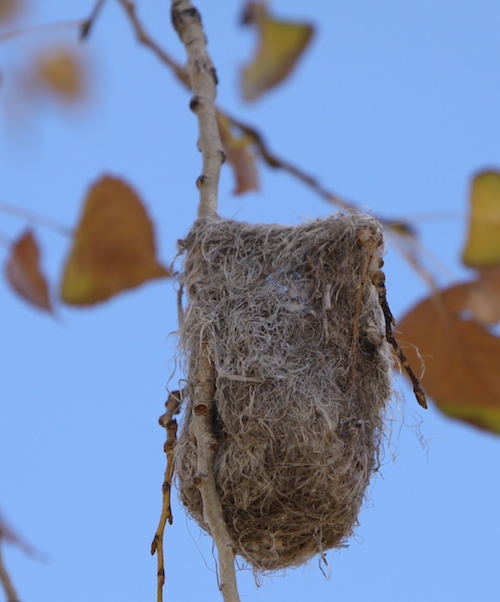
This is one I found in Redding, California with a chick in it!
Red-eyed Vireo Nest
Dalila submitted these great photos of a Red-eyed Vireo nest from southern Ontario, Canada. You can see the original photos on her blog here.
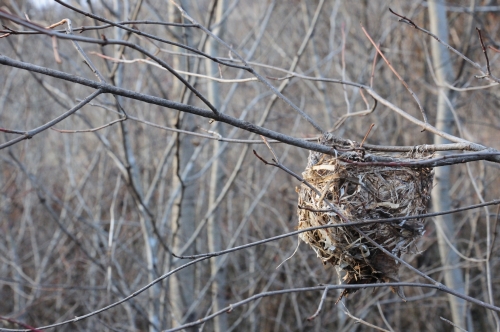
~~~~~~~~~~~~~~~~~~~~~~~~~~~~~~~~~~~~~~~~~~~~~~~~~~~~~~~~
The Red-eyed Vireo breeds in deciduous woodland with dense undergrowth, or scattered groups of trees in open or cultivated areas. The nest is suspended in a horizontal fork, usually of a shrub or low tree branch, 5 to 10 feet up. Another Red-eyed Vireo nest with eggs sent to me from Brigitte in New Hampshire showing nice photos of the eggs.
The two larger eggs with more spots belong to the Brown-headed Cowbird, a brood parasite that lays her eggs in the nest of a host species that will raise her chicks for her. The single smaller egg with fewer spots belongs to the Red-eyed Vireo.
American Redstart Nest with Eggs
American Redstart nests are usually surrounded by foliage within well-vegetated sites, usually against the main trunk of a live tree or in leafy woody shrubs, essentially always supported by at least 3 more-or-less vertical stems for attachment of nest material. The nest is a firm compact cup of grasses, bark fibers and strips, small rootlets and vine tendrils; bound with spider’s webs and ornamented externally with lichen flakes, birch bark, seed heads and plant down; lined with fine grasses, plant and bark fibers, and often hair. These photos were sent to me by a reader from Massachusetts.
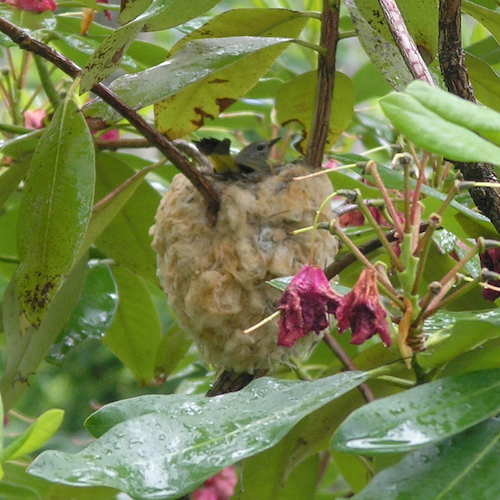
The large bluish egg with brown specs belongs to the Brown-headed Cowbird
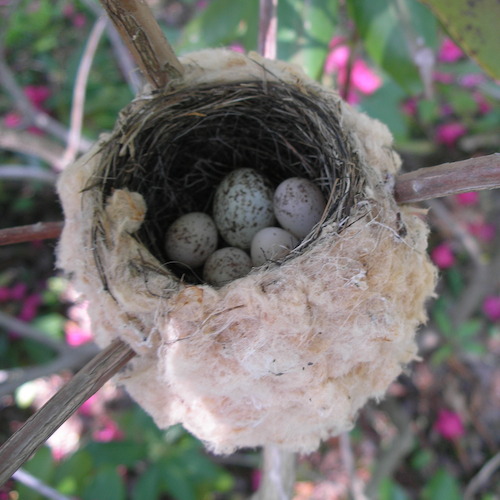
California Quail Eggs and Nest
This photo was sent to me by my friend Amber Galusha. They are California Quail eggs found right next to her driveway.
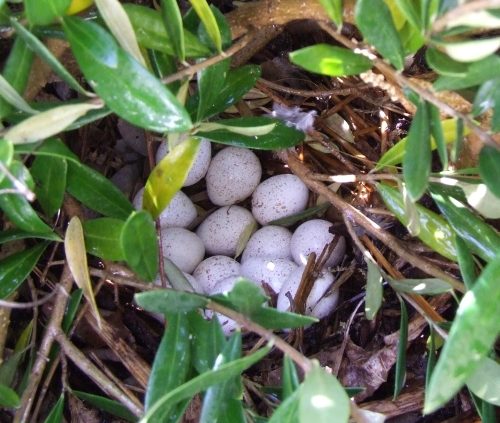
Gambel’s Quail Eggs and Nest
Gambel’s Quail breed in arid desert scrub. Their nest is a shallow scrape on the ground at the base of the trunk of a small tree or shrub, under a low shrub or fallen branches, or sheltered and shaded by a tall tuft if herbage. This photo was sent to me from Scottsdale Arizona from Nancy’s yard.
and a photo from Jonas
This excellent photo from Savannah in Lake Havasu City, Arizona, shows the rare unmarked eggs that Gambel’s Quail can produce.
Barn Swallow Nest and Eggs
The Barn Swallow nest is an open shallow cup of mud pellets mixed with vegetable fibers and plant fragments, usually stuck against a vertical surface, often found on upper ledges of rafters in buildings. They are sparsley lined with feathers. These photos were sent to me by Sonja.
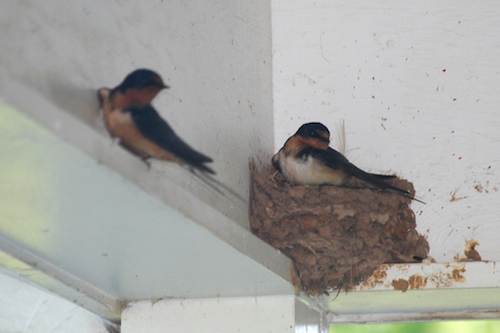
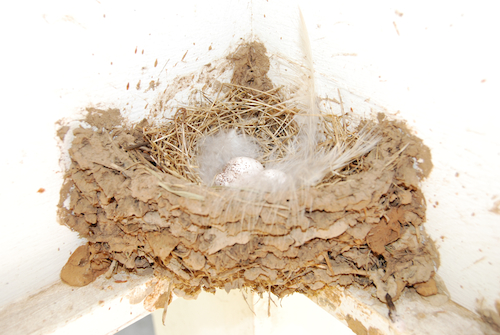
Claire sent me some more great photos of a Barn Swallow nest with close up shots of the eggs.
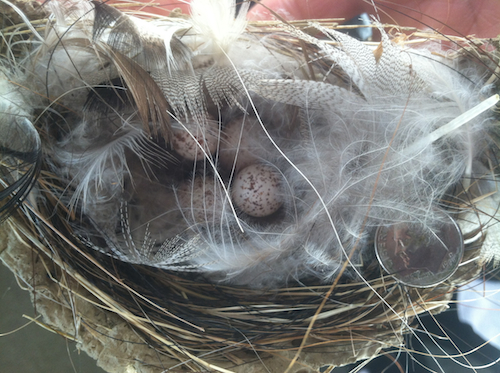
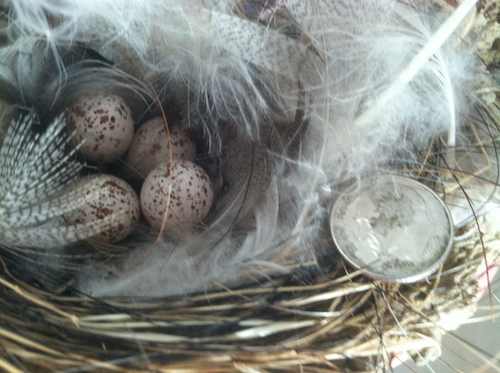
Here is another excellent example of the Barn Swallow nest and eggs sent from Tennessee by Joseph.
Black Phoebe Building a Nest
The Black Phoebe cements its nest to the vertical surface of a wall with mud. They are usually three to ten feet off the ground and the top of the nest is normally between 1 to 2 3/4 inches from the ceiling of the structure being used. You will notice mud on the walls of the building in these photos. The female flutters near or clings to the wall and places or flings mud pellets onto the vertical surface, forming a horizontal line or shallow upward arc. She builds the base of the nest out from the wall into a platform, then builds the nest cup up from the platform and lines the nest. Thanks go to Michelle from California for these photos.
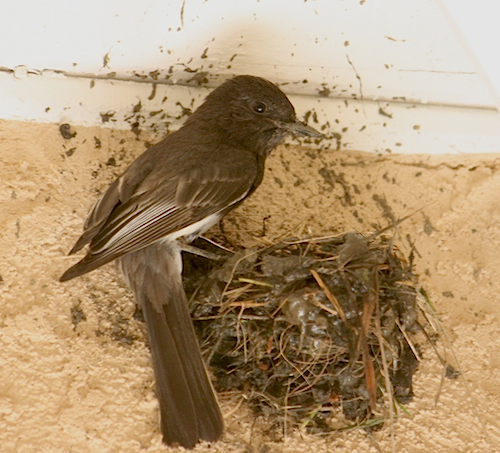
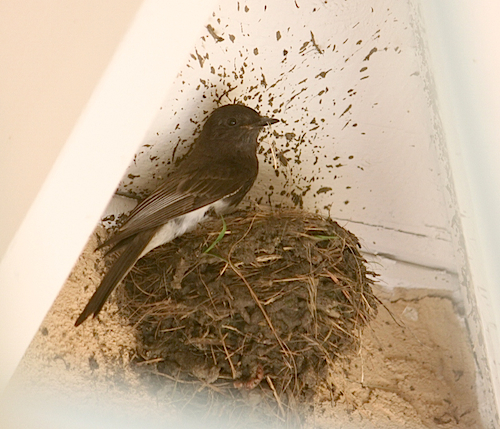
Eastern Phoebe Nest and Eggs
Eastern Phoebes usually breed around farms and other buildings. More often on a ledge, rafter or raised site with some overhanging protection, in or on a building, under a bridge, or in any niche of this kind. Their nest is a cup of mud pellets mixed with moss, dry grass, fibers or weeds, and vine stems; lined with fine fibers, rootlets and hair. This photo comes to me from Aimme.
Here are some more shots of an Eastern Phoebe nest with eggs from Kim in Michigan.
This series of photos from Melissa in New York shows an Eastern Phoebe nest, found in their backyard play set, with 4 Phoebe eggs and one Brown-headed Cowbird egg…
then the Cowbird hatches first…
followed by the Eastern Phoebe chick. Note that the Cowbird nestling is already three times larger than the Phoebe nestling.
This Eastern Phoebe nest, atop a porch ceiling fan, was sent to me by Paige from Alba, Texas
And another from Stephen in Indiana showing the nestlings!
Cliff Swallow Nests
Cliff Swallows breed in places where rock outcrops, cliff faces or buildings provide sites. The nest is a rounded mud structure fixed to a vertical surface protected by an overhang. They usually nest in large colonies.
Northern Rough-winged Swallow Nest with Eggs
The Northern Rough-winged Swallow usually nest in a burrow dug in a steep-faced earth, sand or gravel bank. Burrows are of variable length and old Kingfisher burrows are also used. They will also use crevices and holes in buildings and man-made structures, drainpipes and even dryer vents like this nest sent to me by Kelly Bannister. Their nest is an accumulation of grasses, weeds and loose plant material with a cup lined with fine grasses and rootlets.
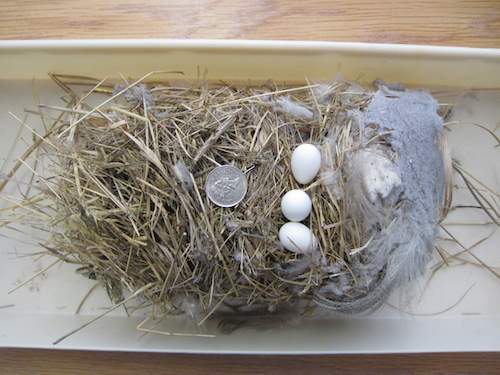
Violet-green Swallow Nest and Eggs
The Violet-green Swallows nest in a crevice or hole in a cliff surface or rock outcrop, in a natural cavity in a tree or in a man-made nest box. Their nest is an accumulation of dry grasses with a cup lined with feathers and sometimes hair or fine fibers.
Violet-green Swallow Eggs in Nest
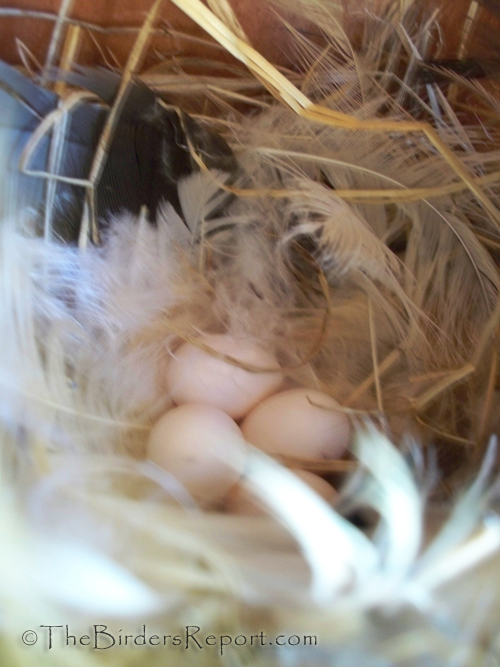
Tree Swallow Nest and Eggs
These photos are form my Bluebird trails. The net and eggs…
the nestlings a day old…
and the nestlings at day 10.
Black-billed Magpie Nest
These photos of a Black-billed Magpie nest were taken by Laura Young near Banner Wyoming. These huge stick dome nests are built around a mud bowl and lined with grass, rootlets and horse hair.
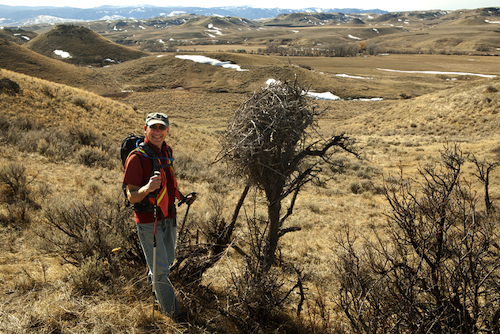
You can see the mud used to anchor the platform in this photo
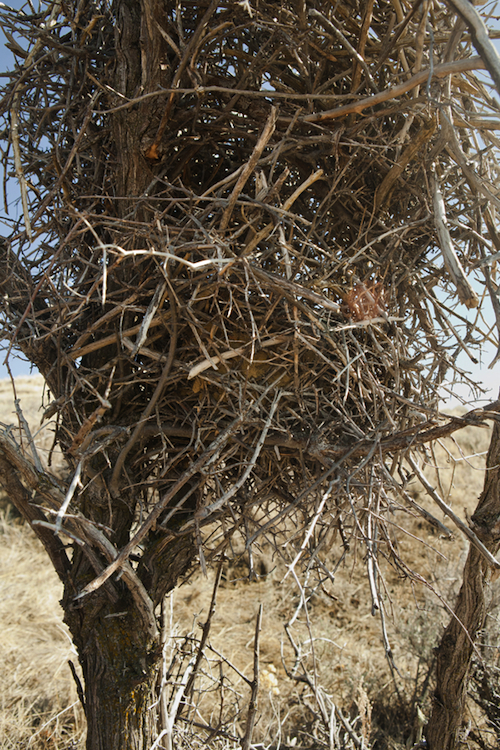
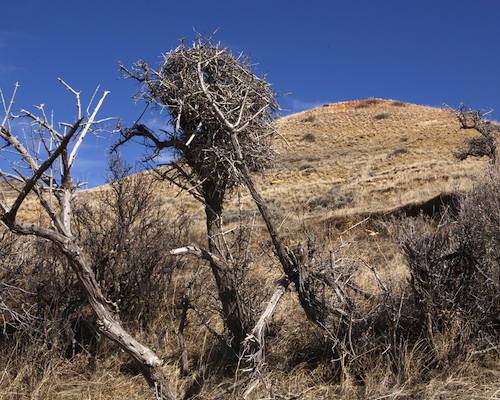
Blue-gray Gnatcatcher Nest and Eggs
The Blue-gray Gnatcatcher usually nest in a tree or shrub, saddling a branch or in a fork. This one sent to me by Dan From Missouri was nesting on a grape vine in his vineyard. Their nests are a deep, rounded cup, neat and compact, narrowing slightly at the rim. Made of plant down, bark and plant fibers, fine grasses, catkins, feathers, and hair; bound together and to the support by spider’s webs; the outside covered with lichen flakes; and lined with plant down and feathers. They are usually built saddling a limb or fork. Saddled nests are often built against a twig or side branch, also around twig or knot for support; often screened above by foliage with high leaf density immediately surrounding the nest.
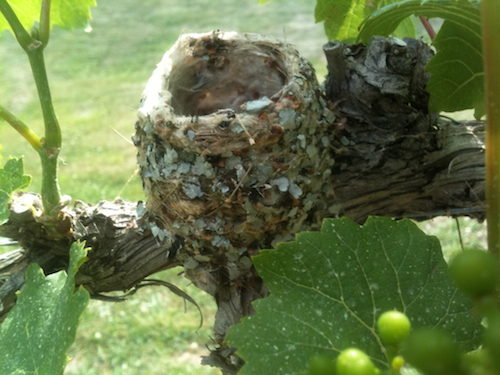
They usually lay 4 to 5 very pale to pale blue eggs, speckled, spotted or blotched with chestnut-red, purplish-red, or reddish-brown and paler purple.
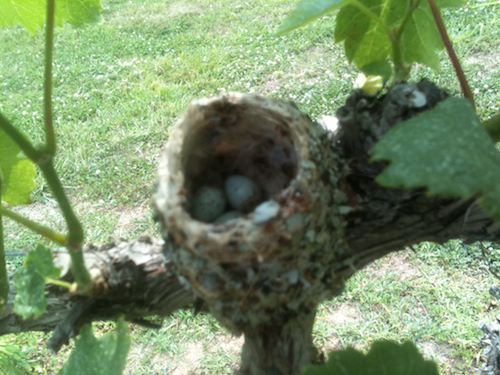
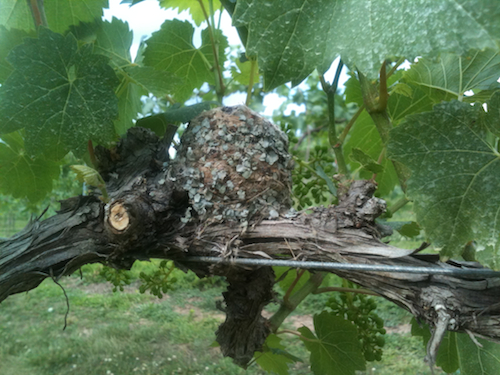
Here are a couple of great photos of the Blue-gray Gnatcatcher’s nest …
and eggs from Jason in Oklahoma.
Common Nighthawk Nest and Egg
The Common Nighthawk breeds in open areas, forest clearings, cultivation, barren rock, gravel or beaches. They nest on the bare ground and frequently on the flat graveled roofs of buildings. This bird is nesting in the parking lot of Roger McCollum’s business in Alabama! He has placed cones around the female who is sitting on the nest in this photo he sent me.
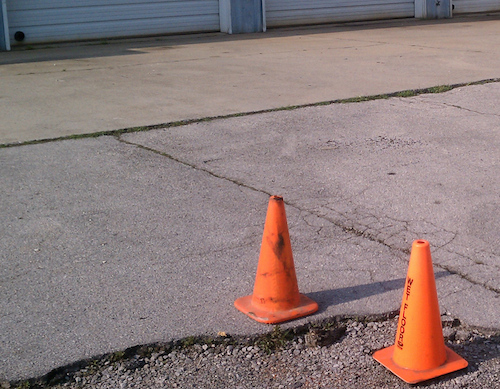
Here’s a nice close up of her
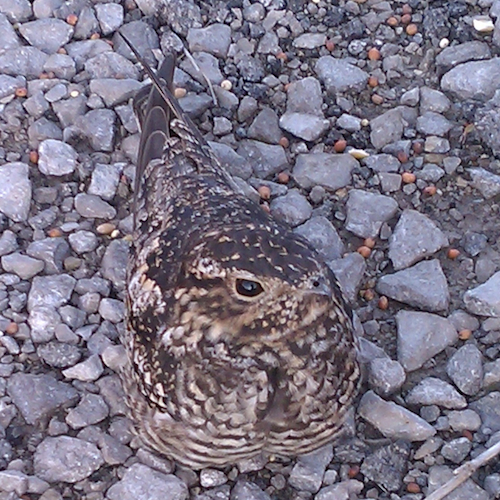
They usually lay two eggs but so far Roger has seen only this one.
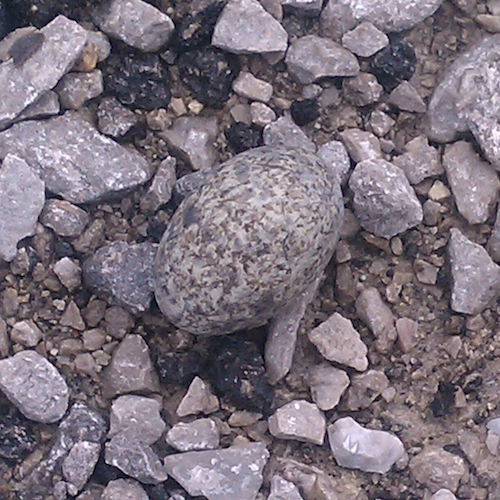
Common Nighthawks rely on their camouflaged plumage to evade predation but if a predator gets too close they will react and may actually flush from their nest.
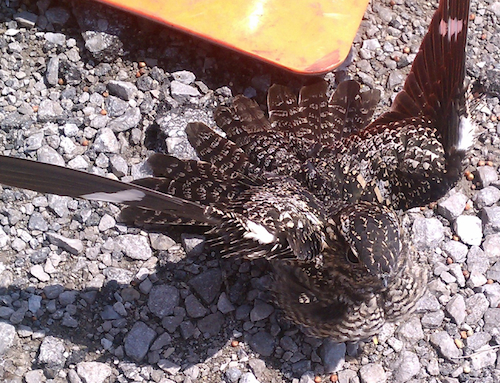
And finally mom with her chick.
Roger has posted his Common Nighthawk story on his Facebook page.
For an in depth look at bird eggs there is a great resource at The Royal Albert Museum .

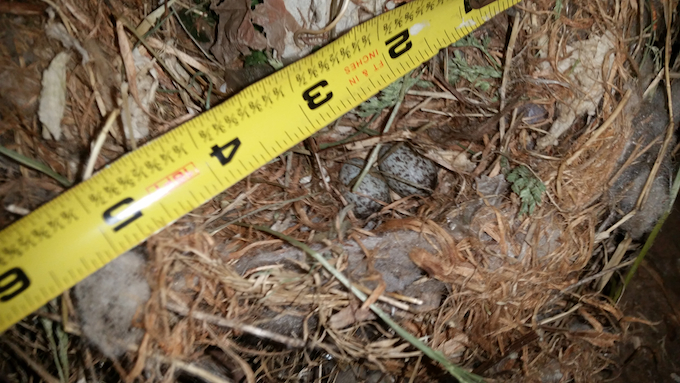
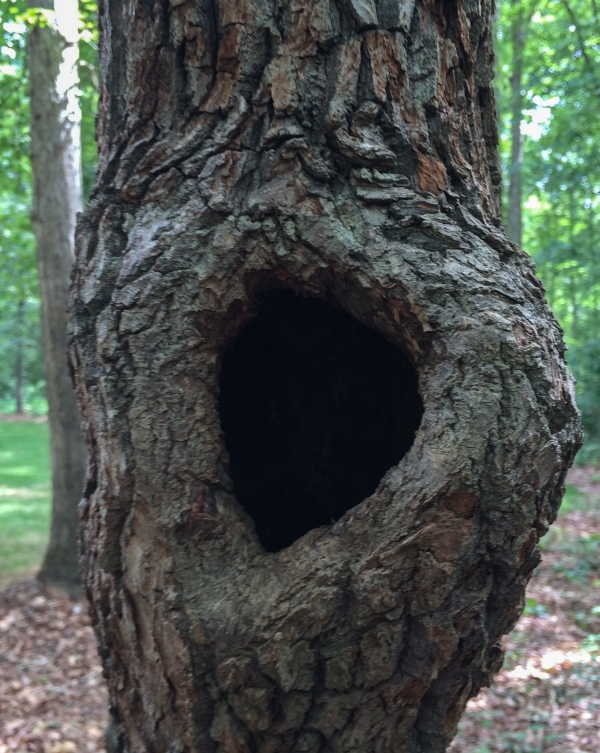
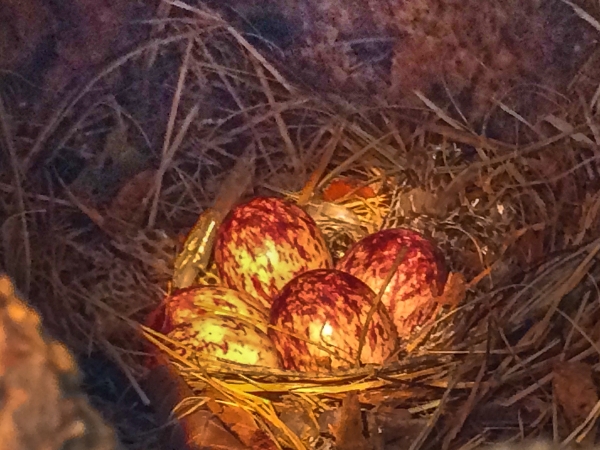
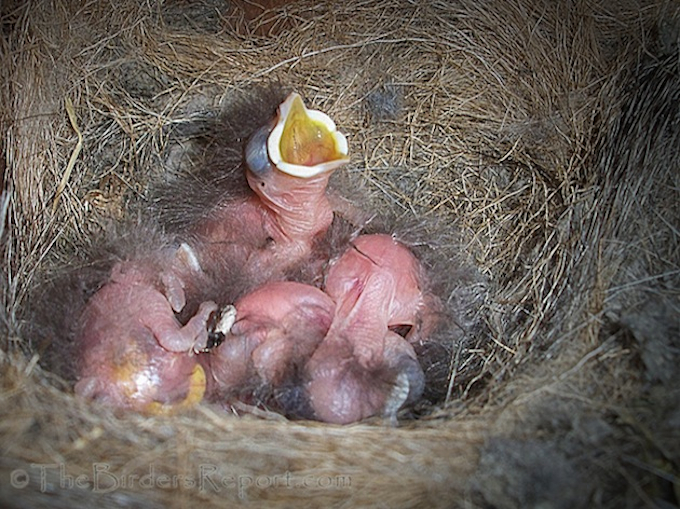
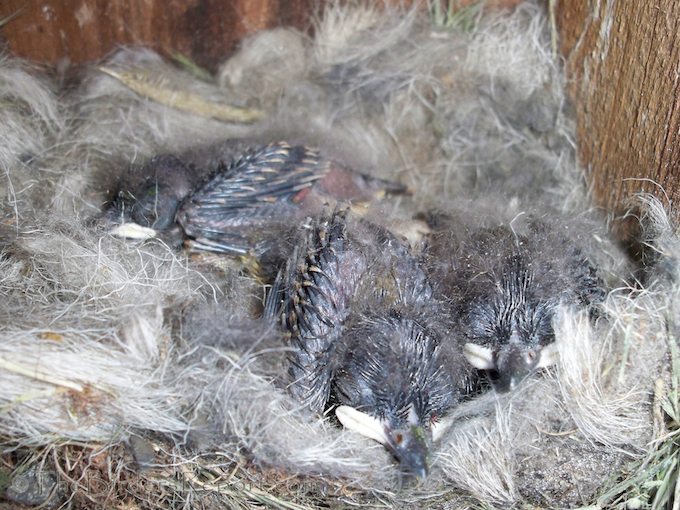
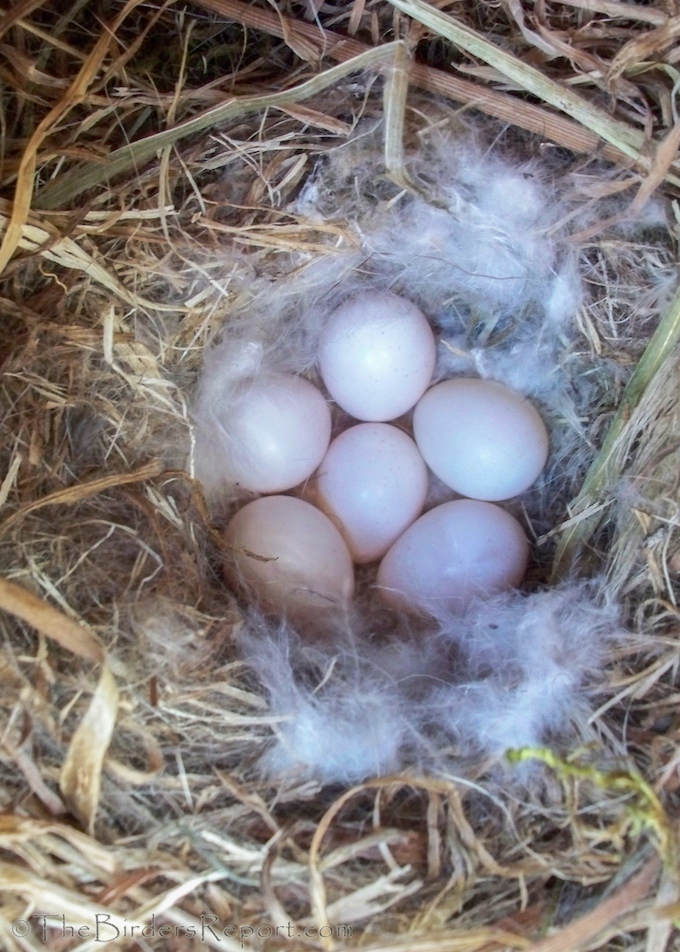
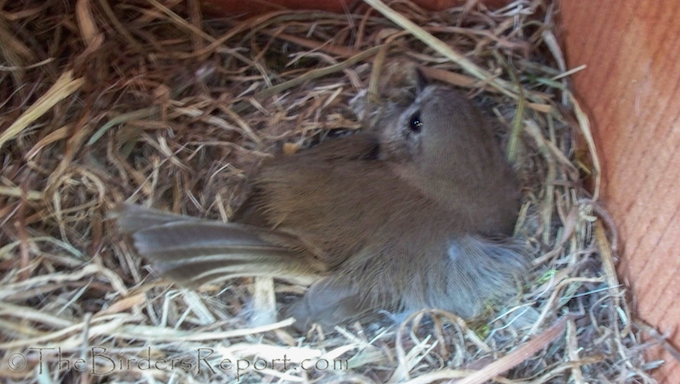
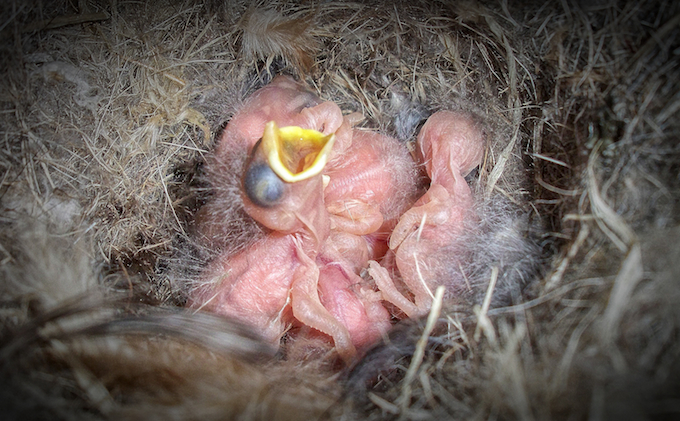
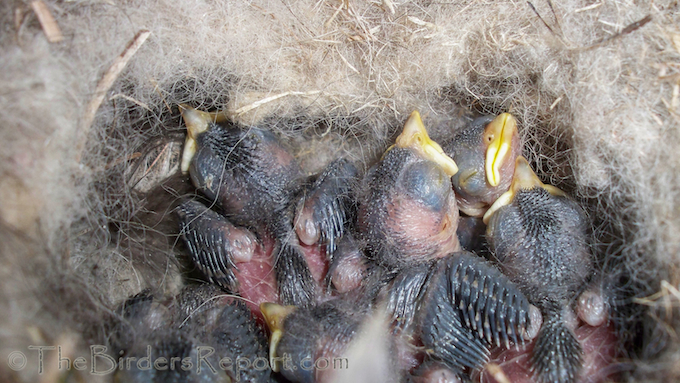
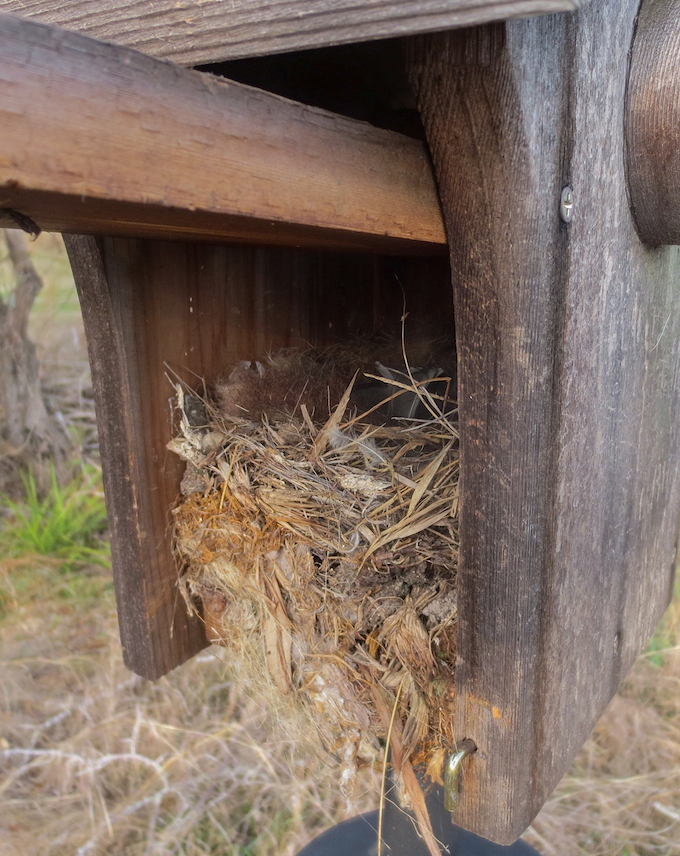
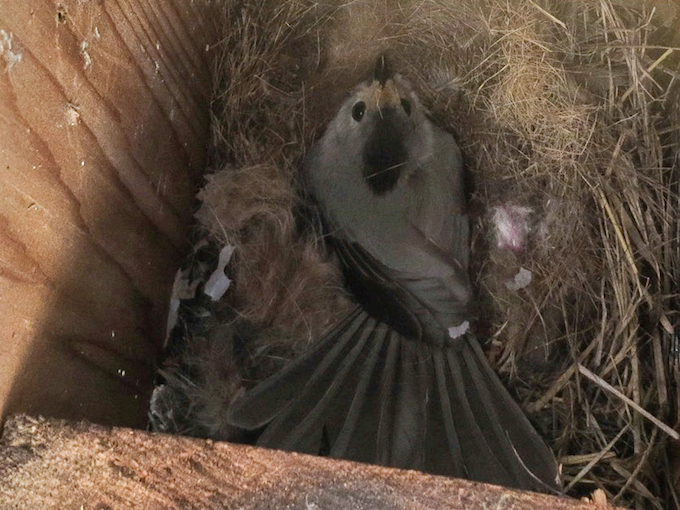
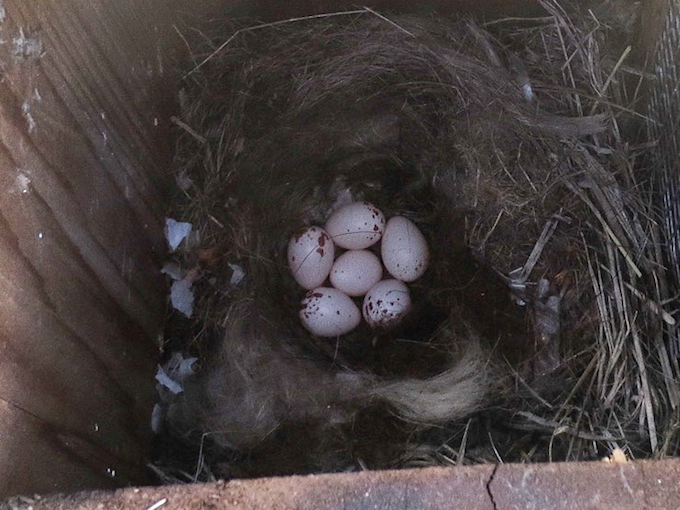
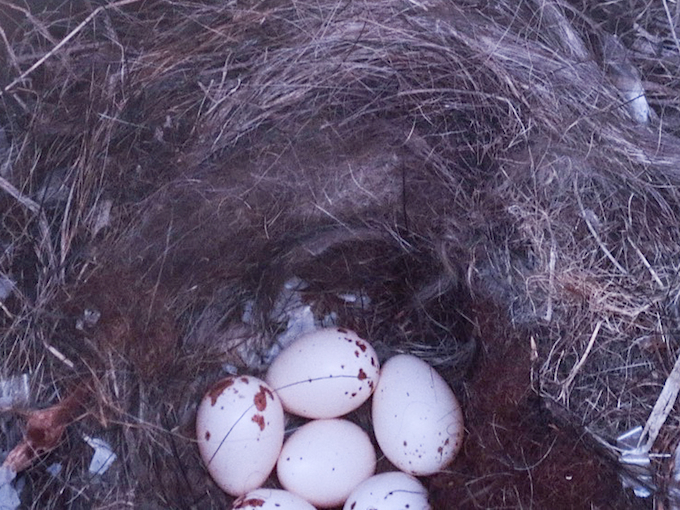
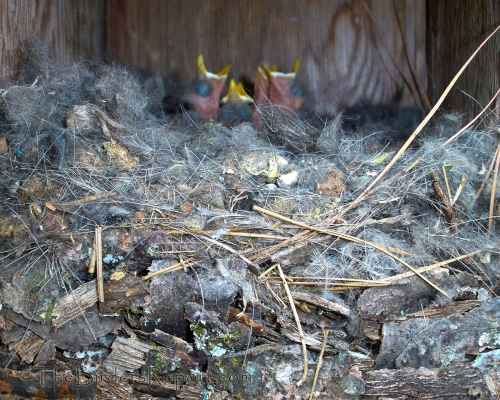
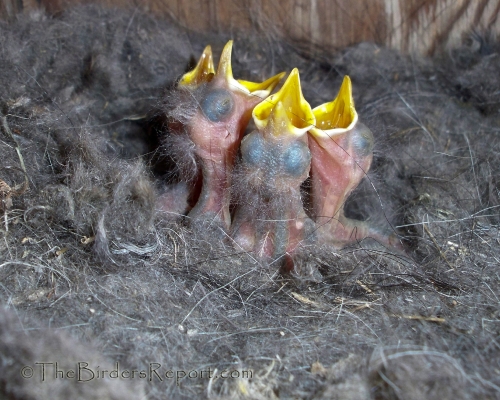
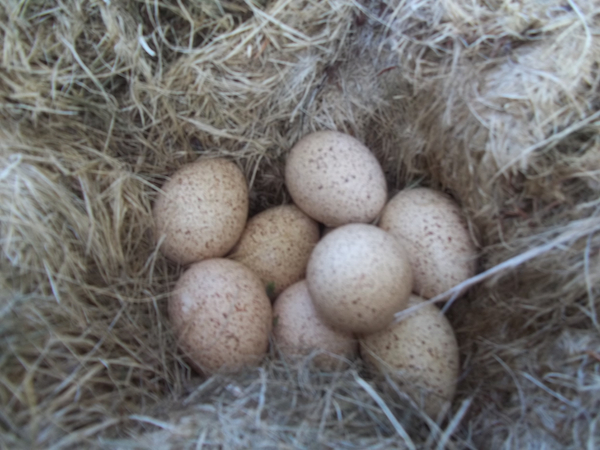
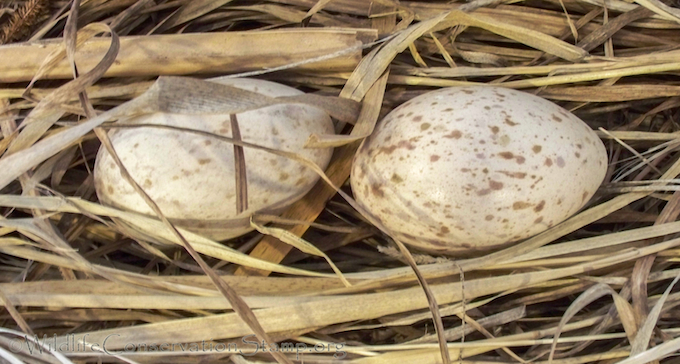
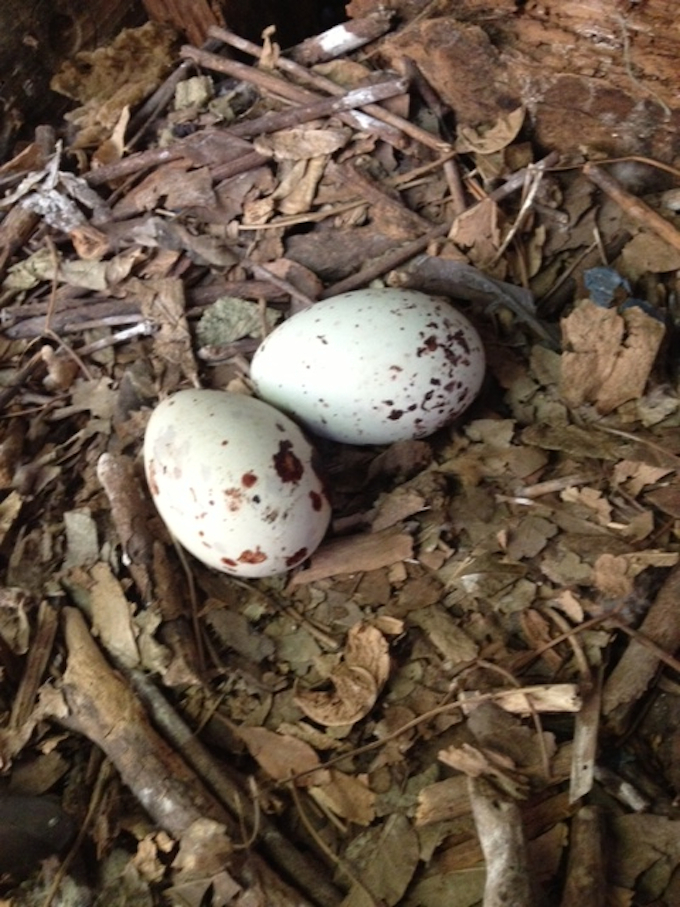
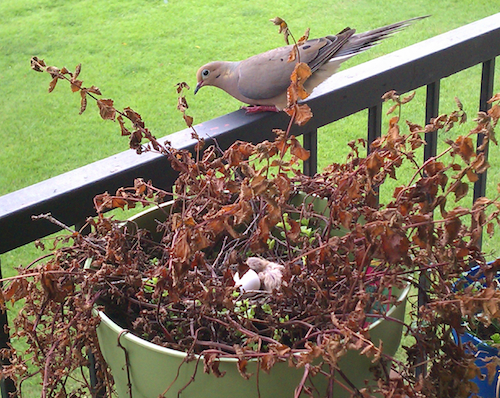
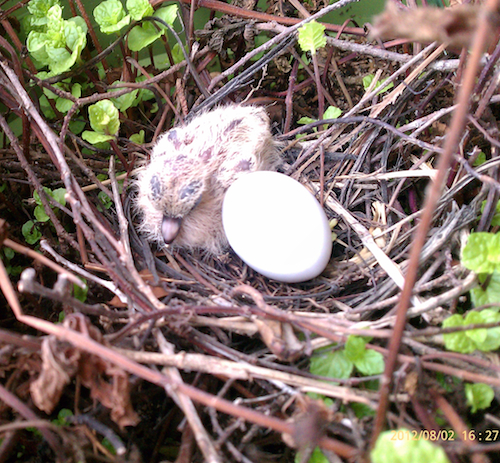
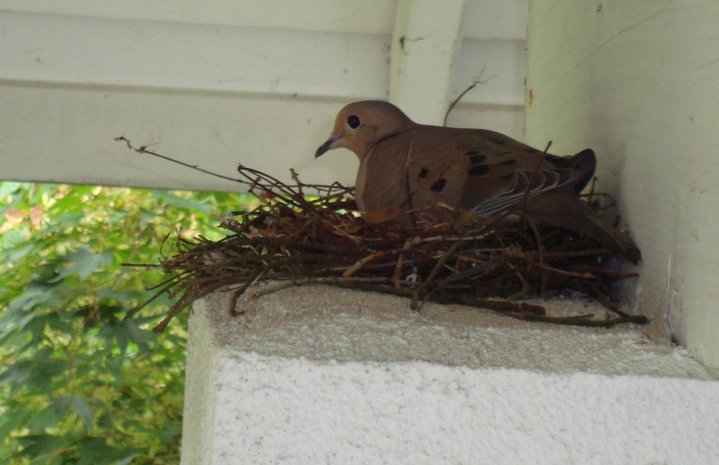
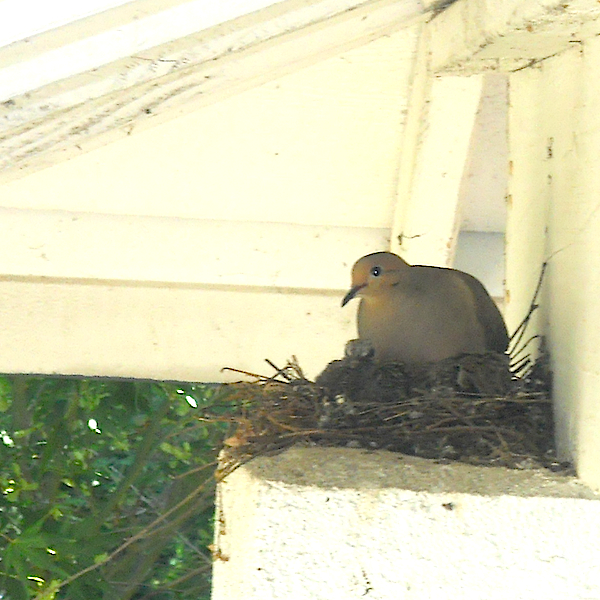
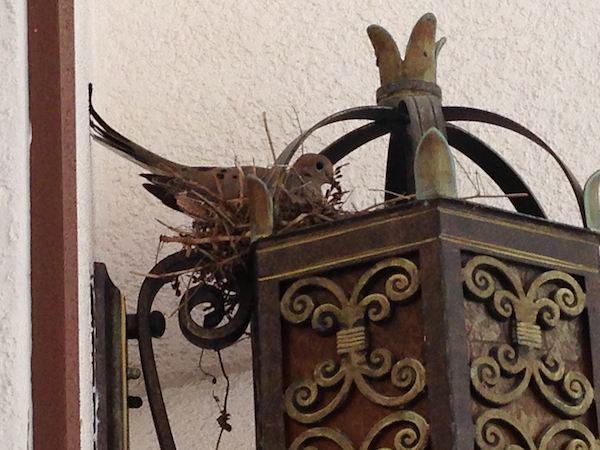
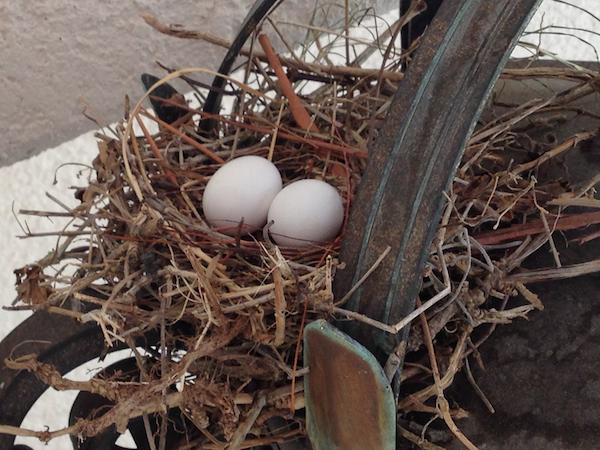
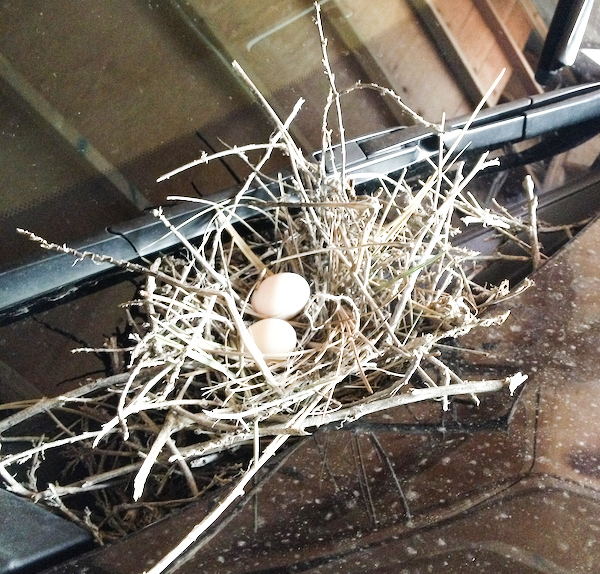
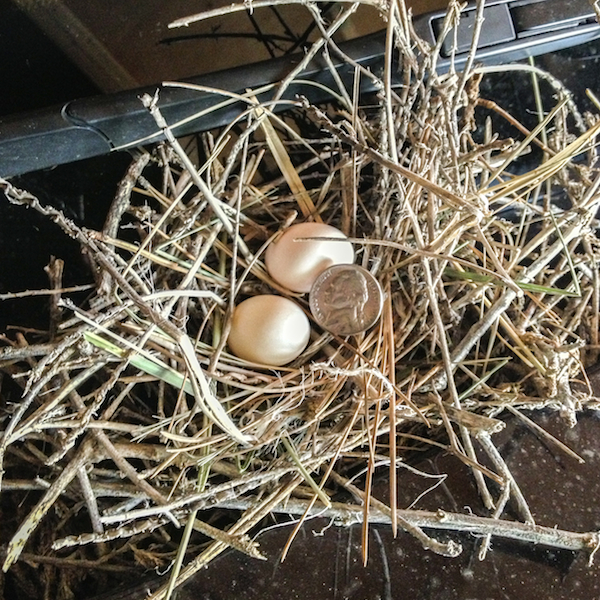
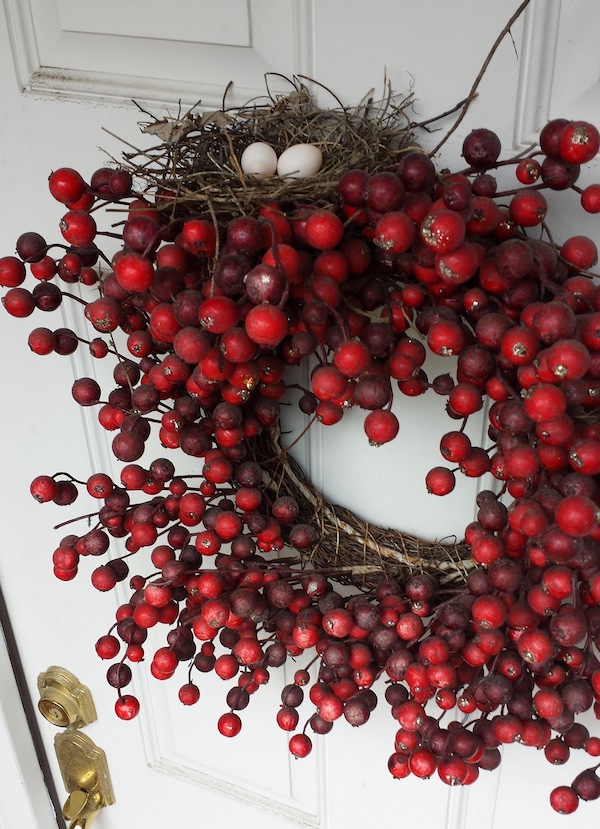
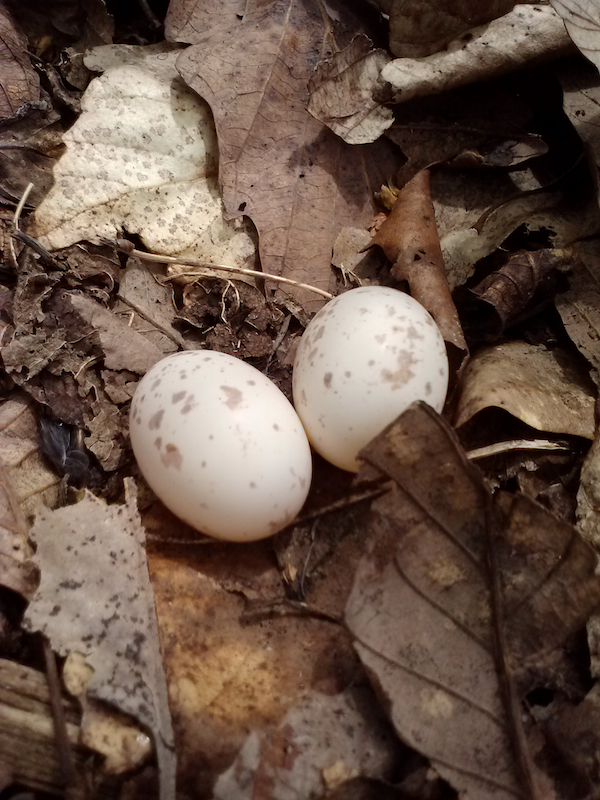
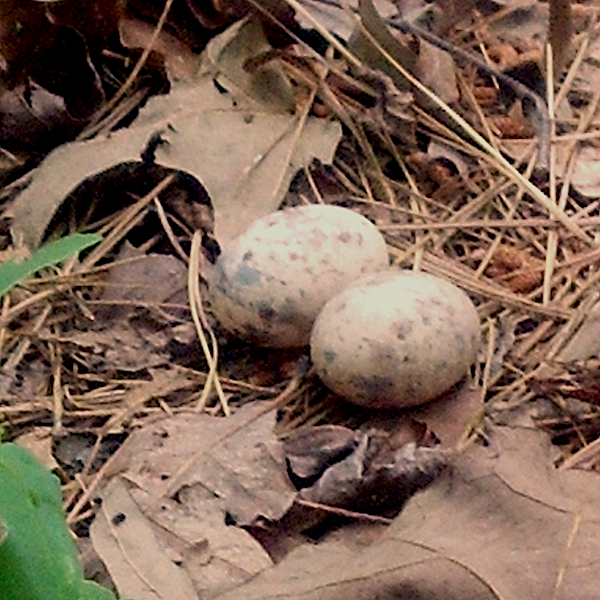
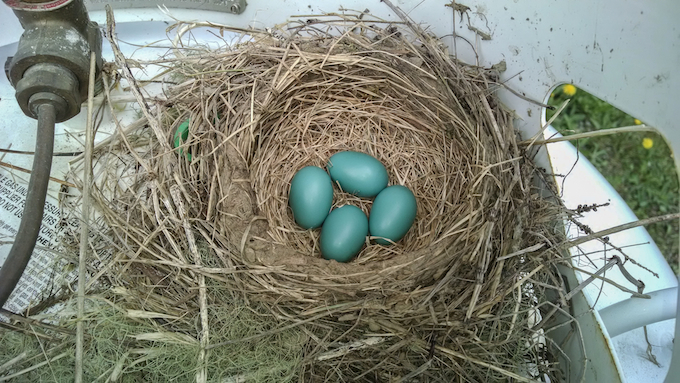
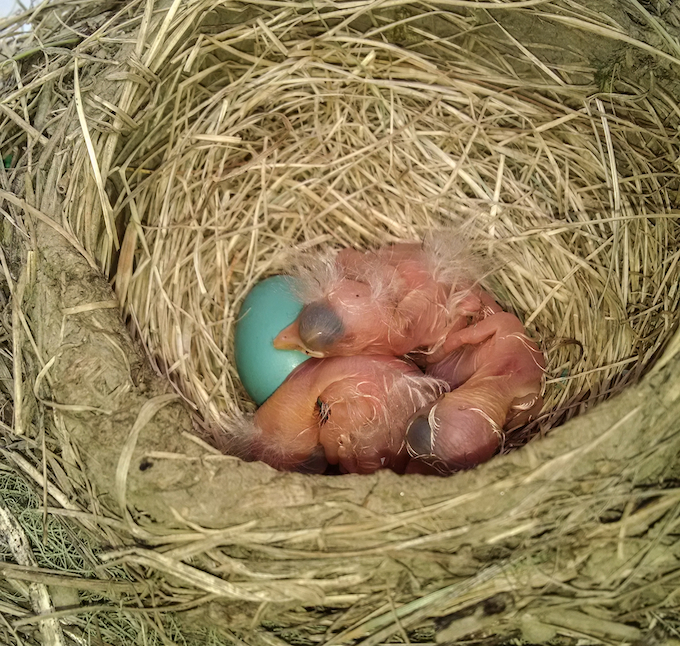
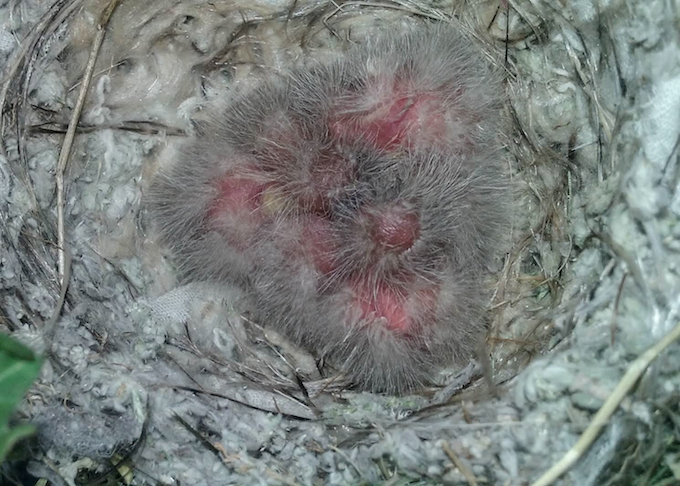
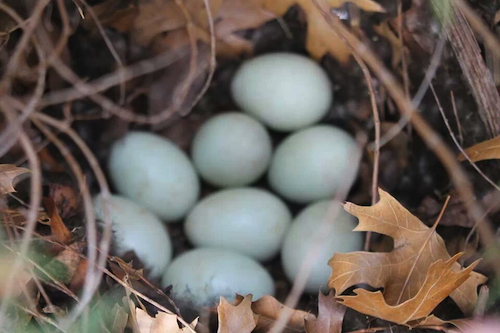
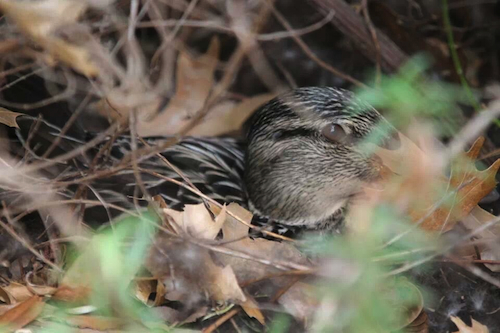
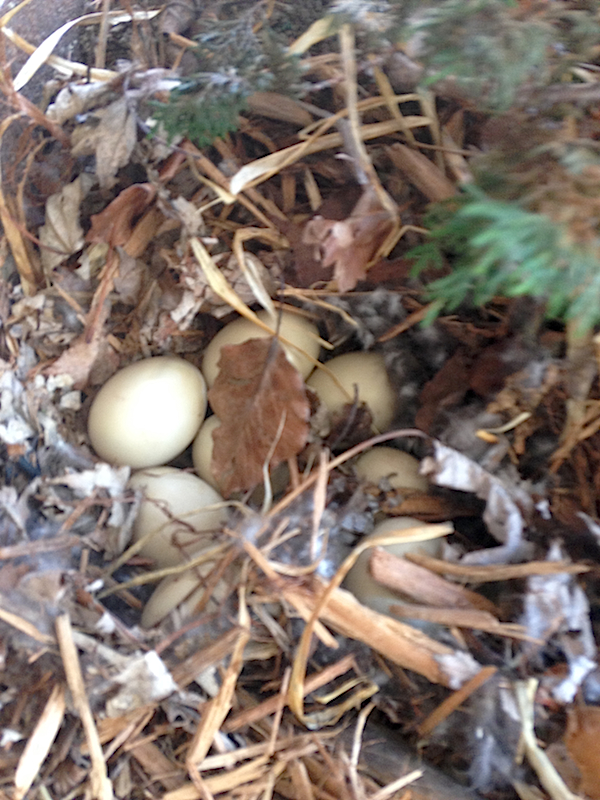
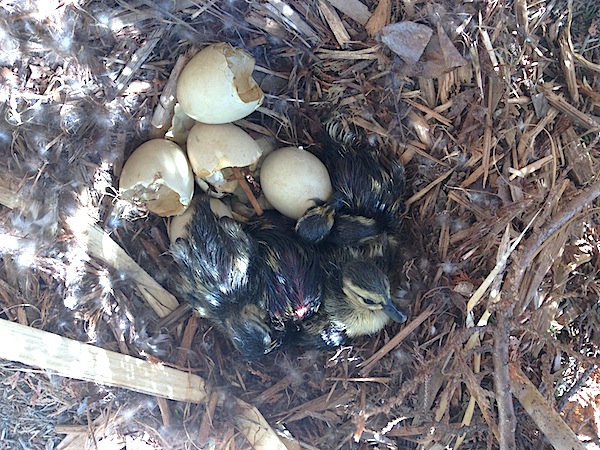
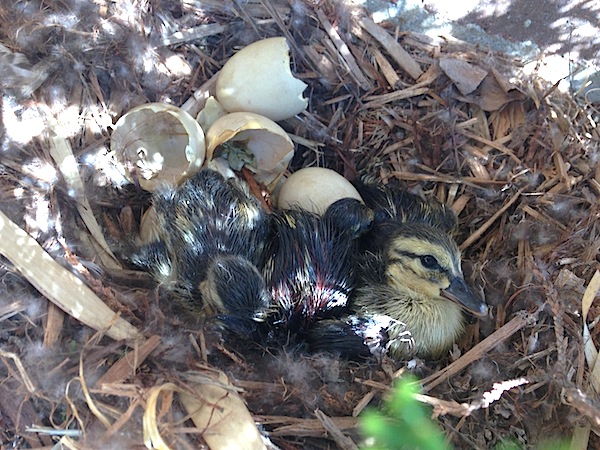
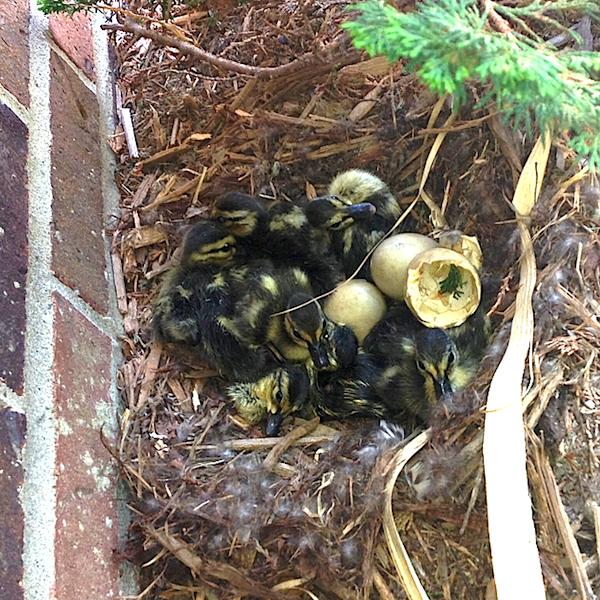
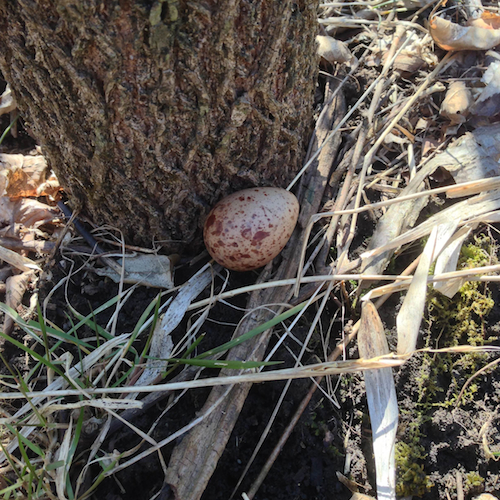
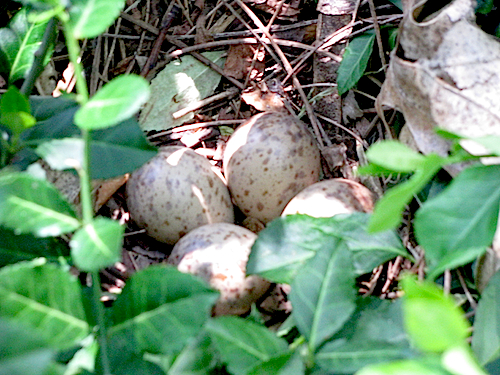
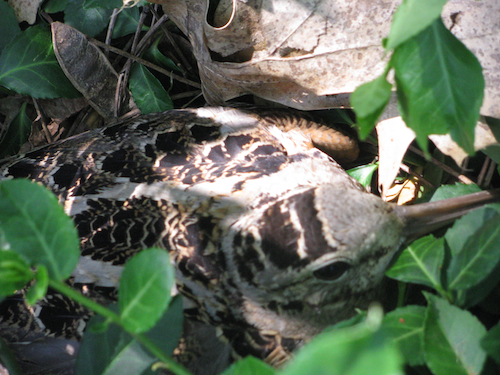
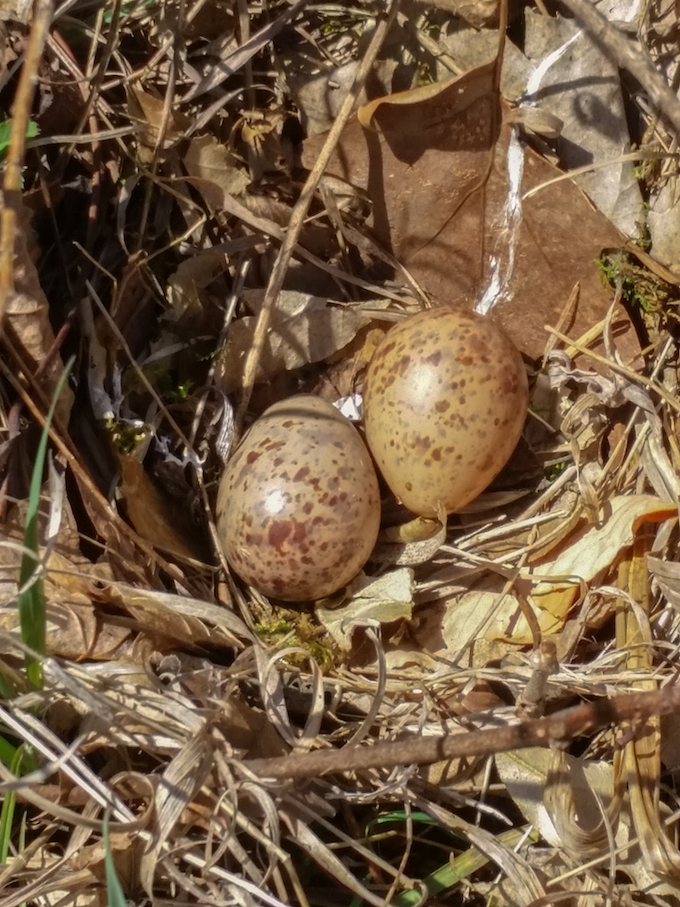
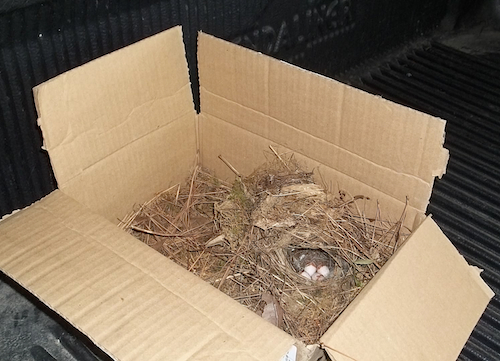
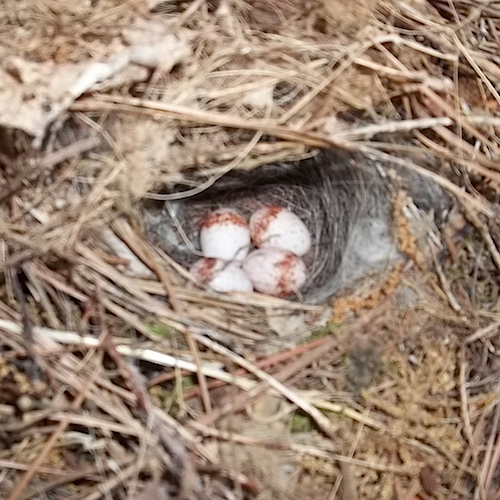
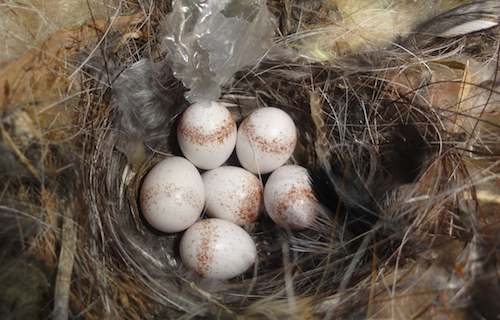
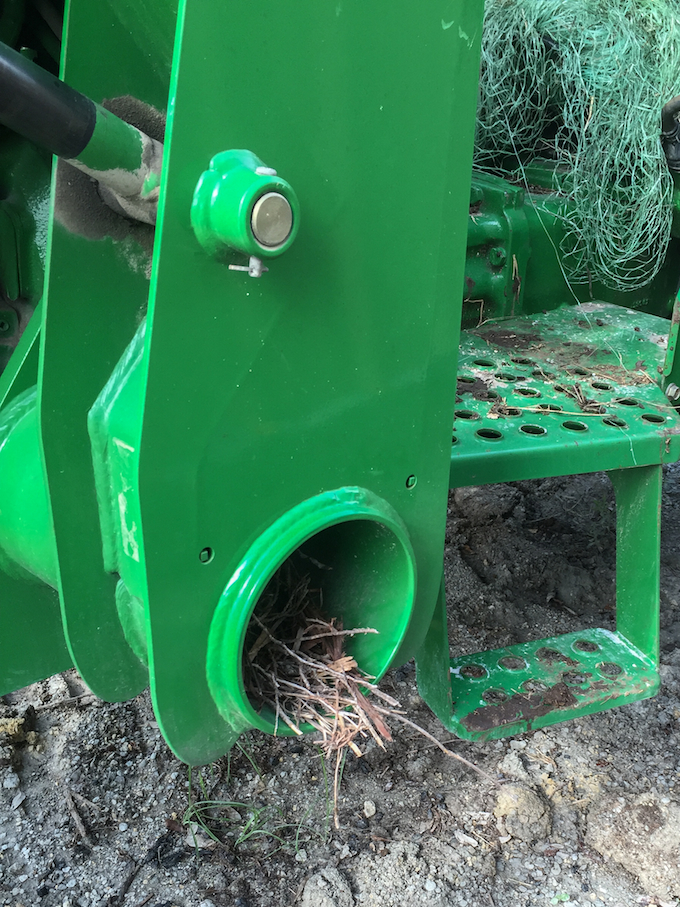
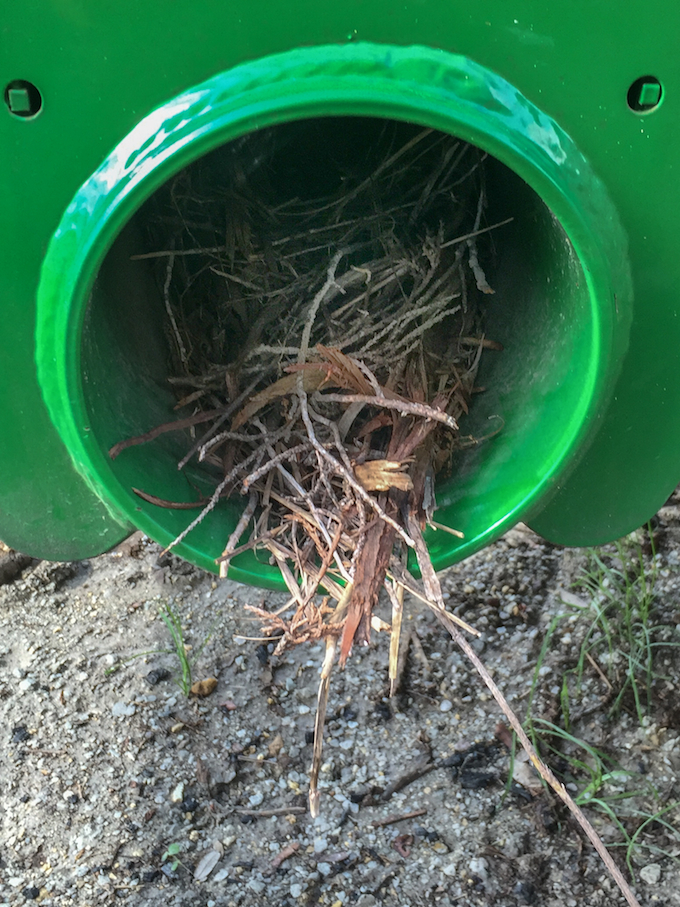
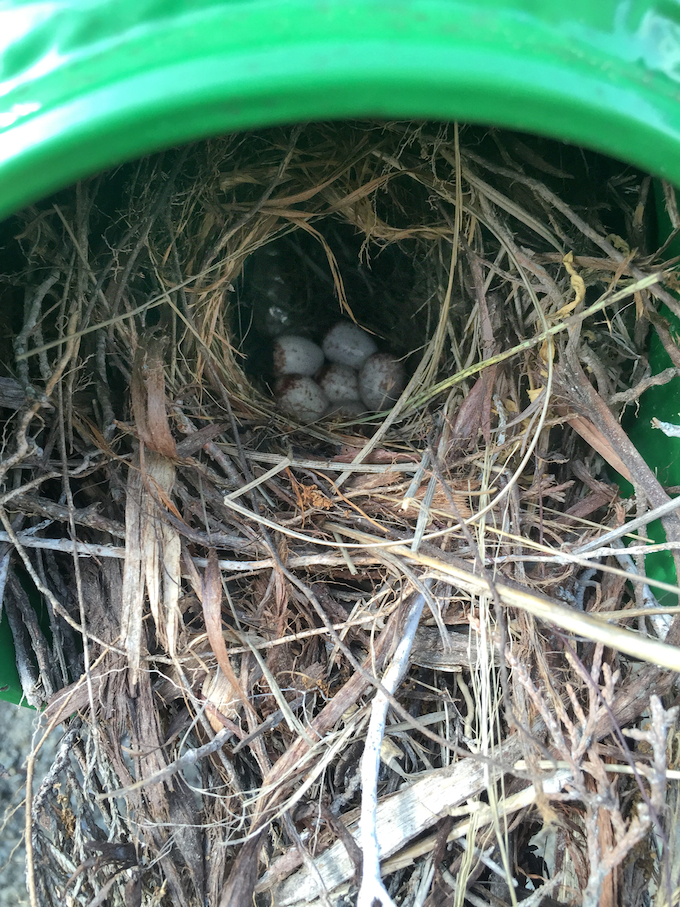
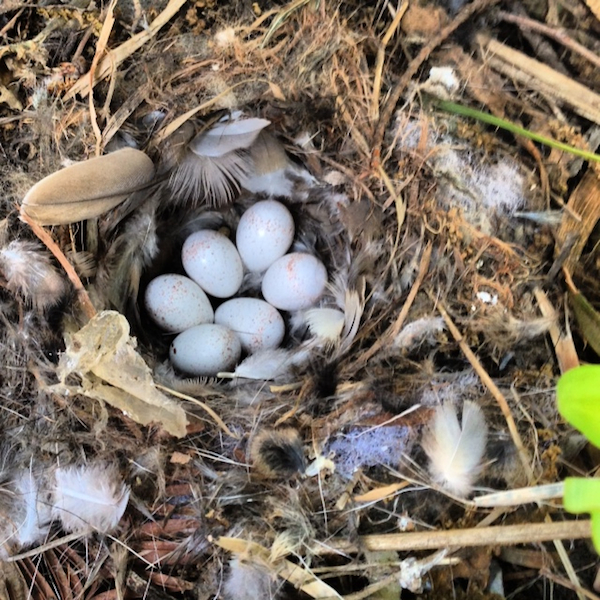
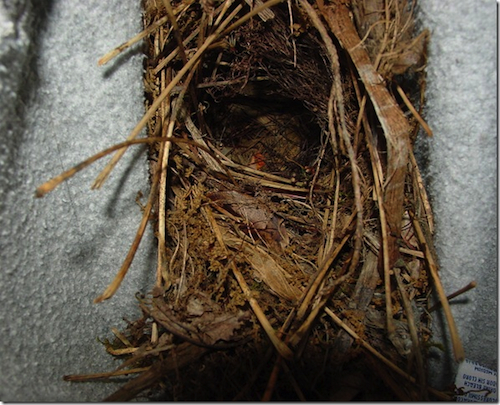
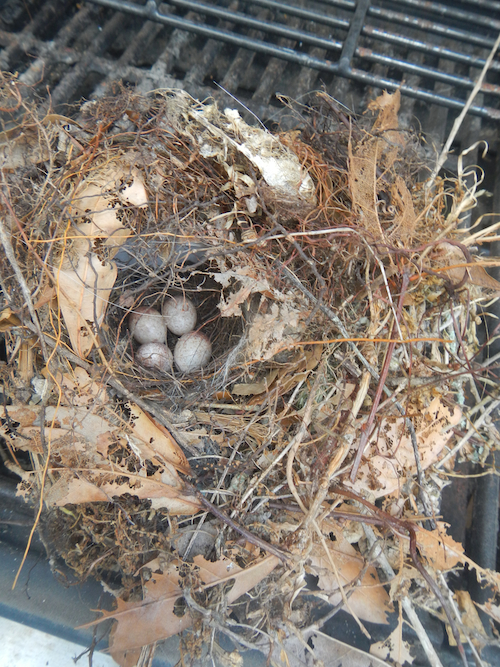
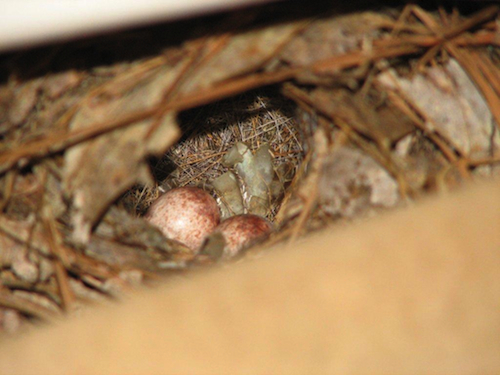
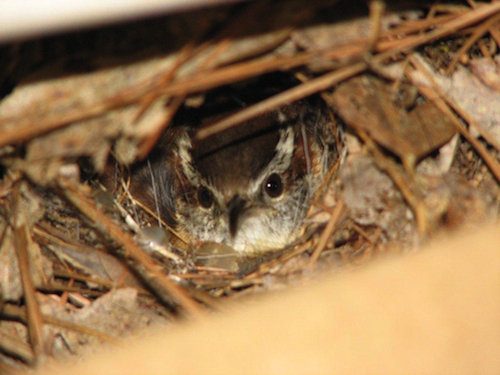
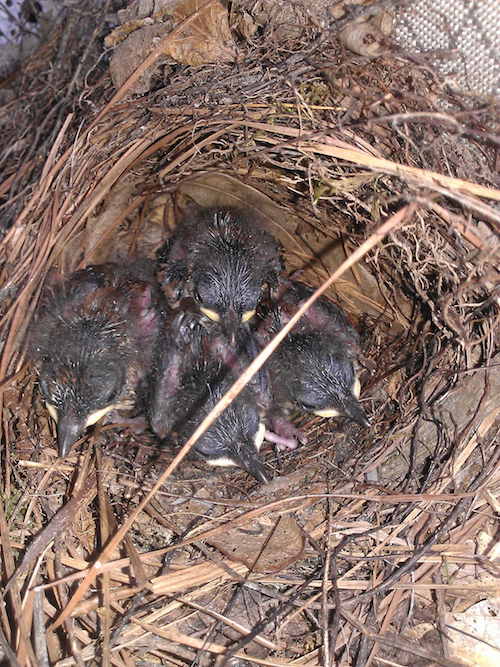
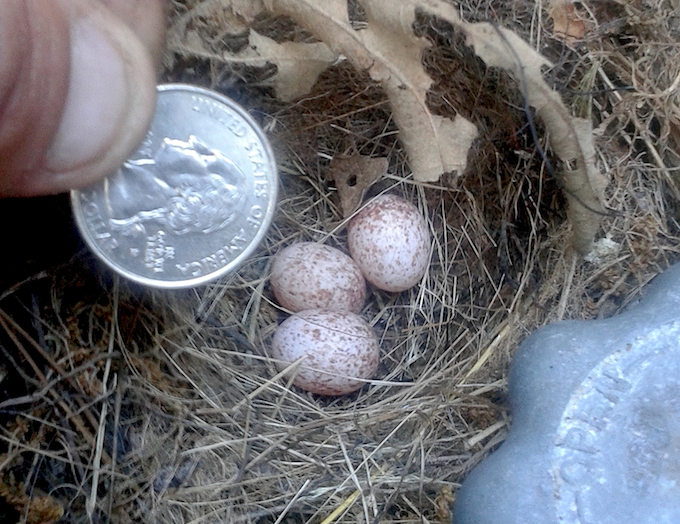
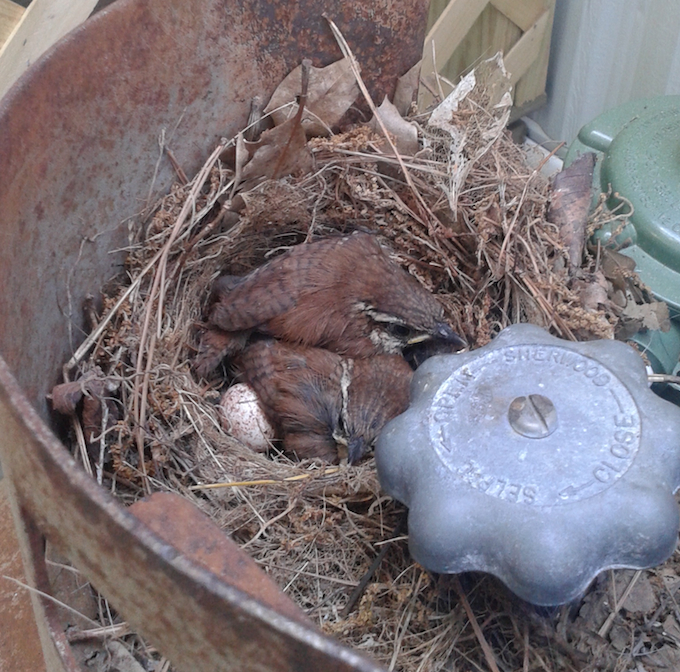
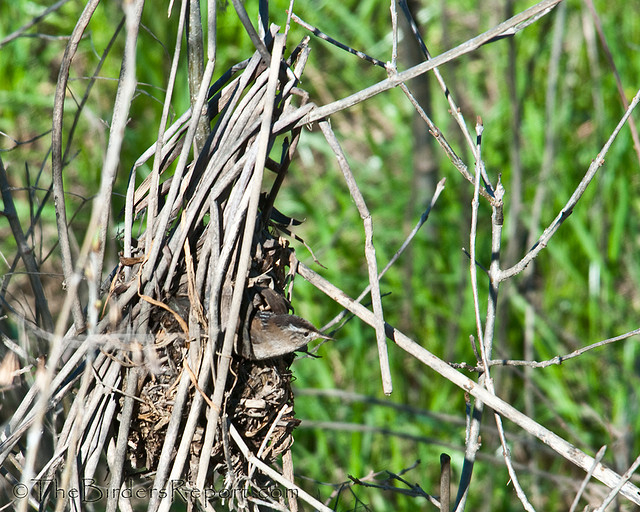
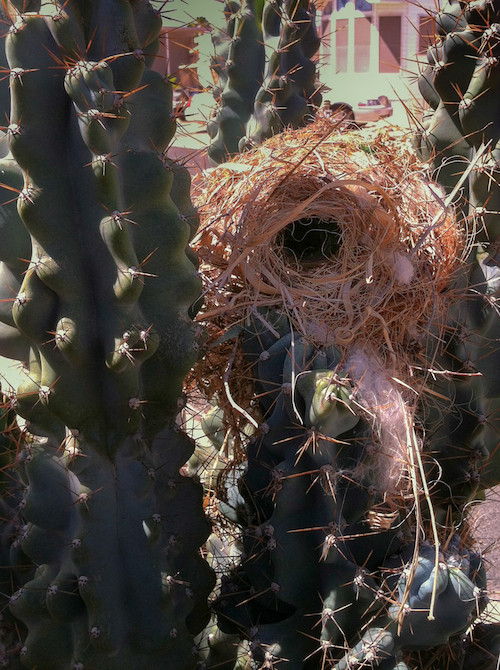
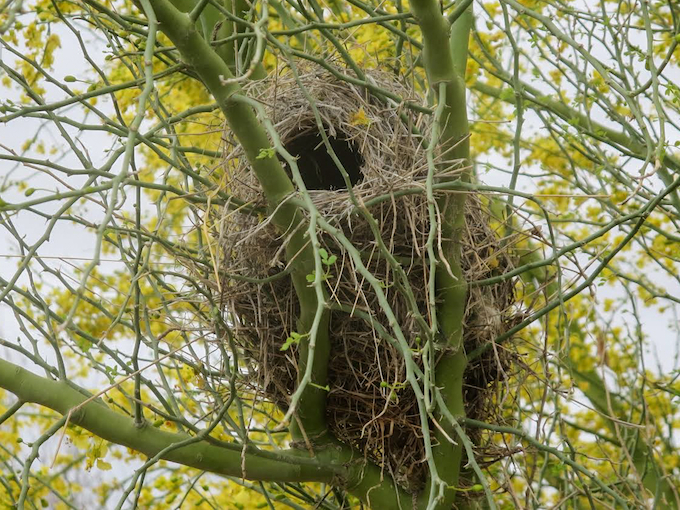
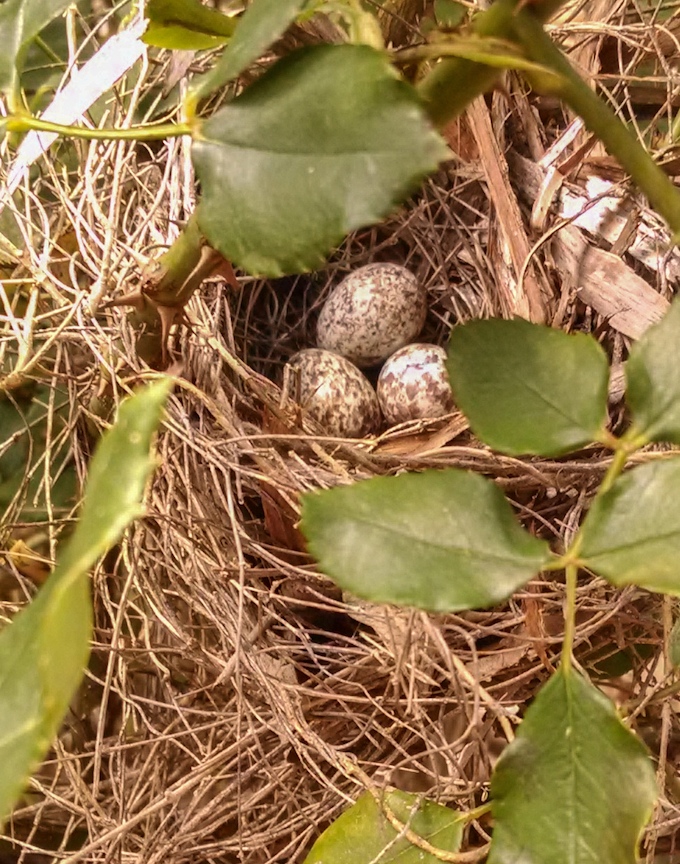
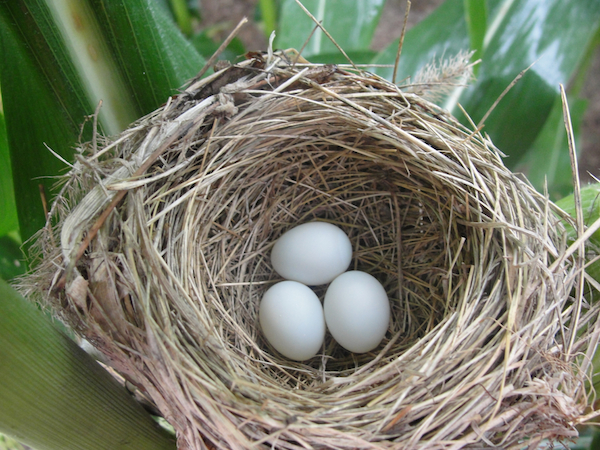
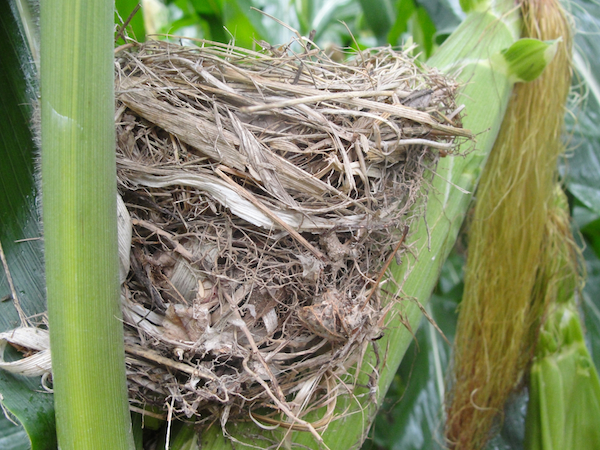
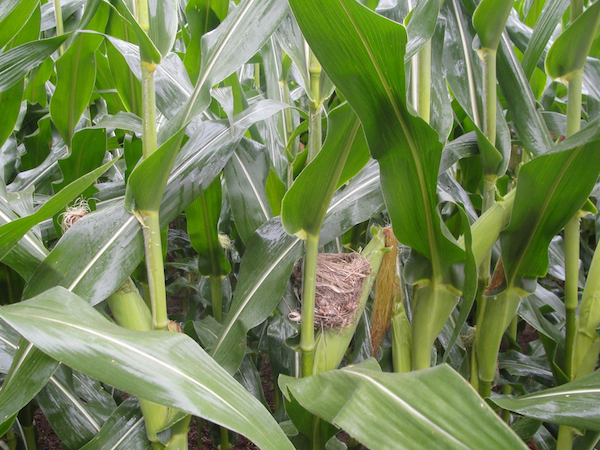
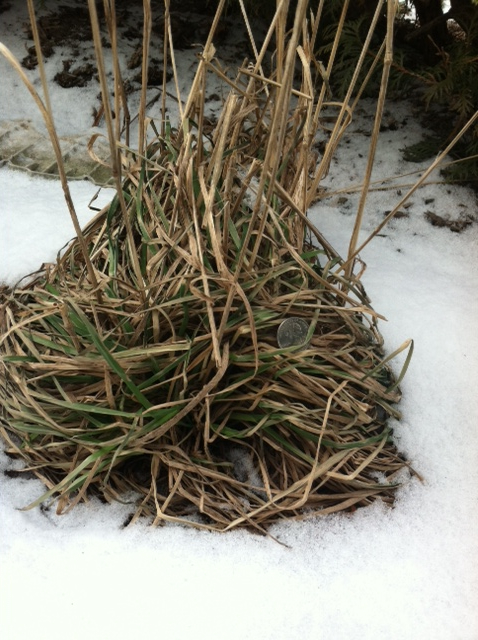
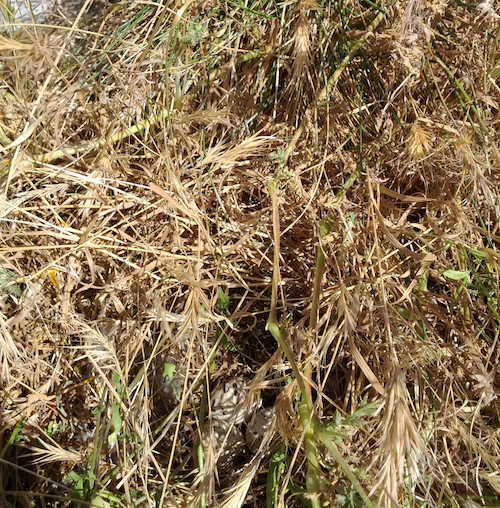
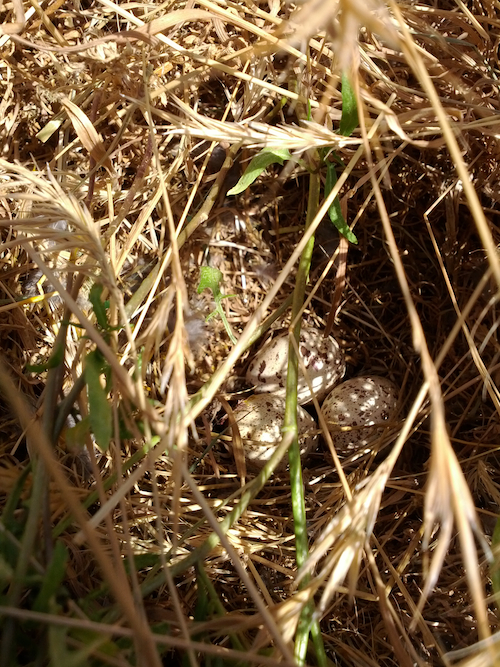
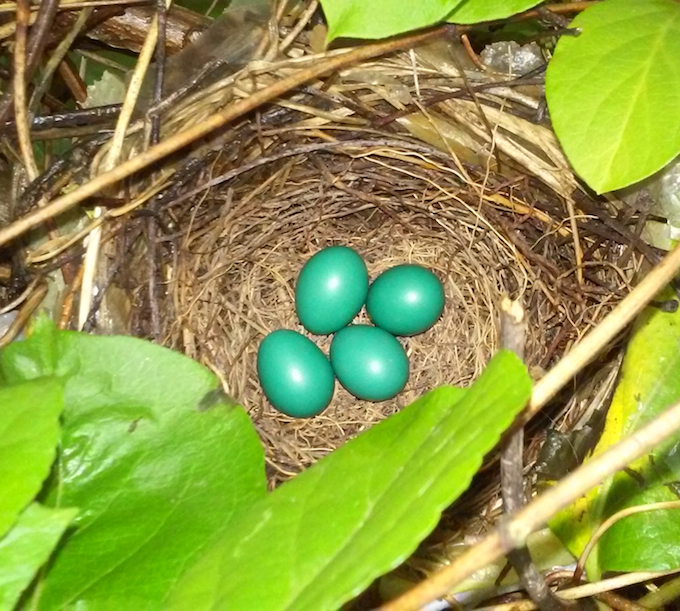
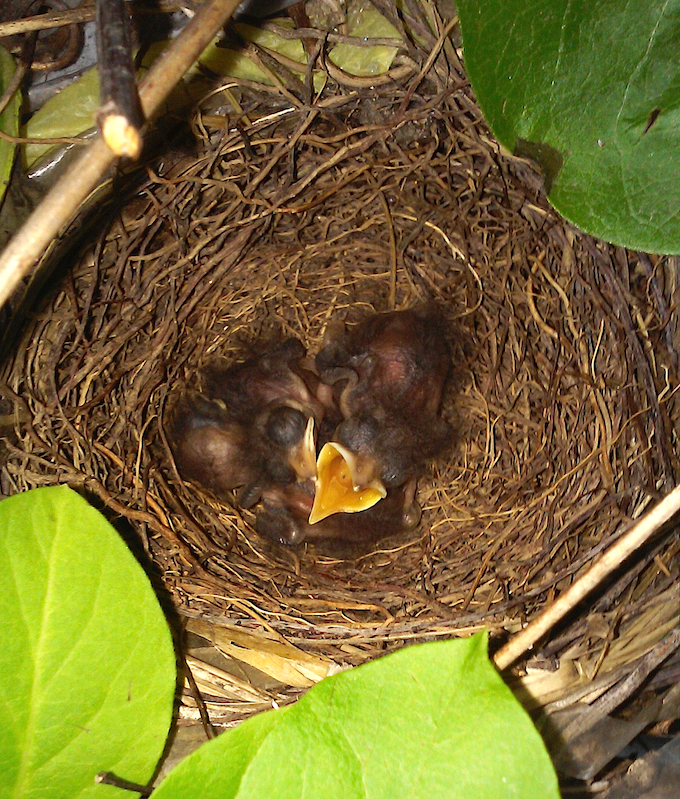
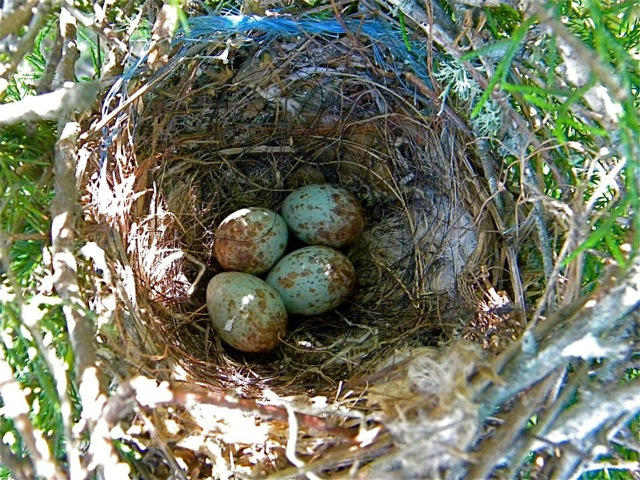
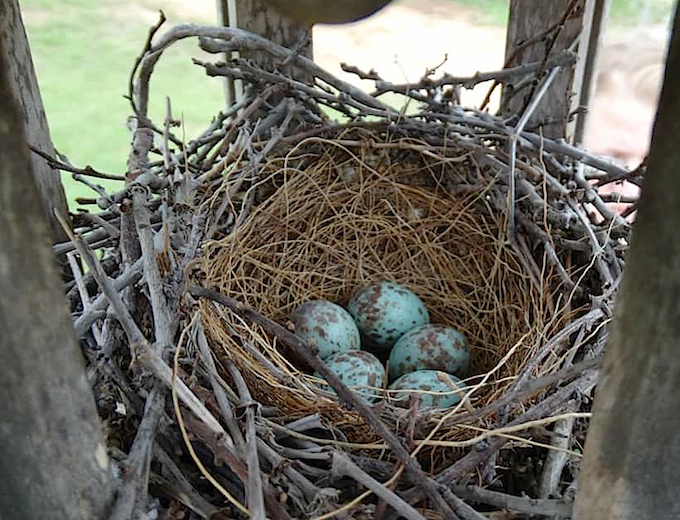
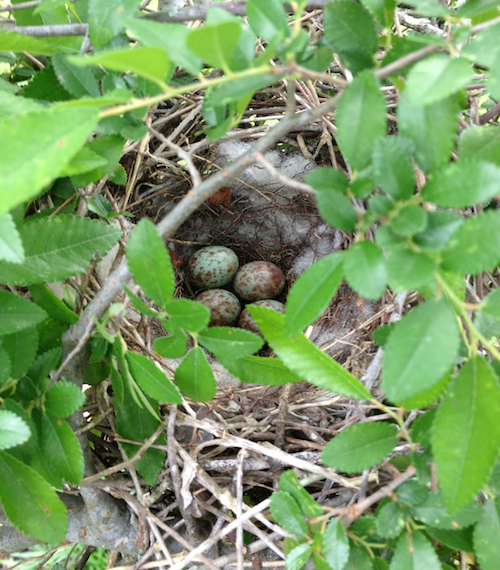
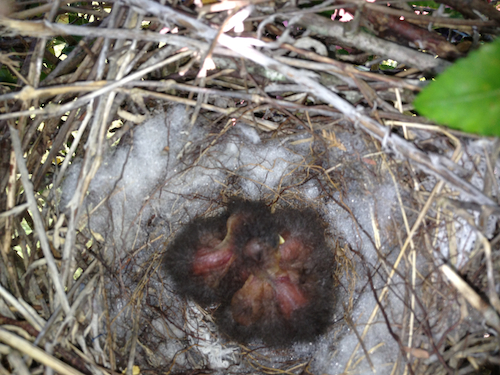
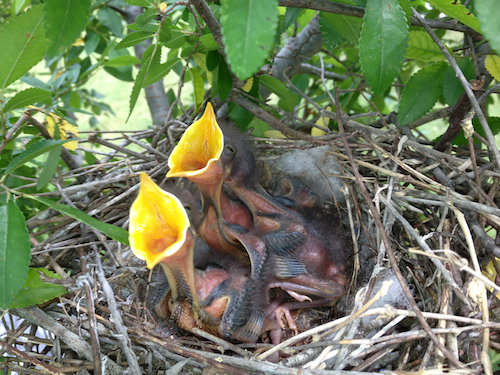
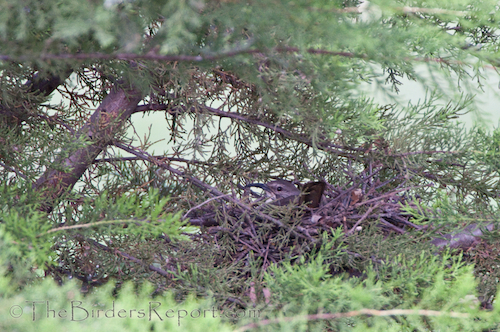
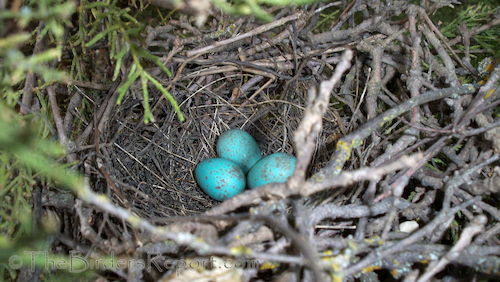
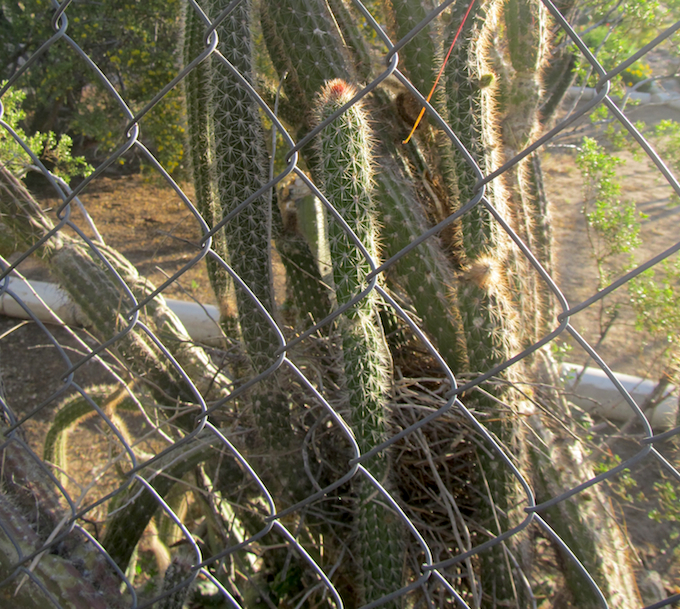
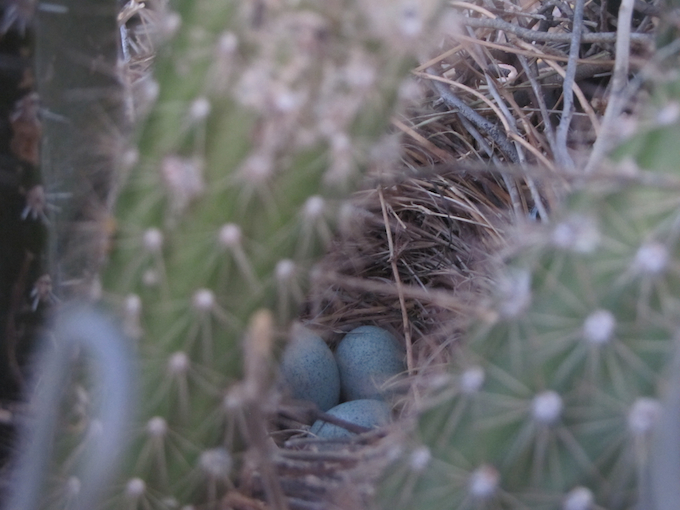
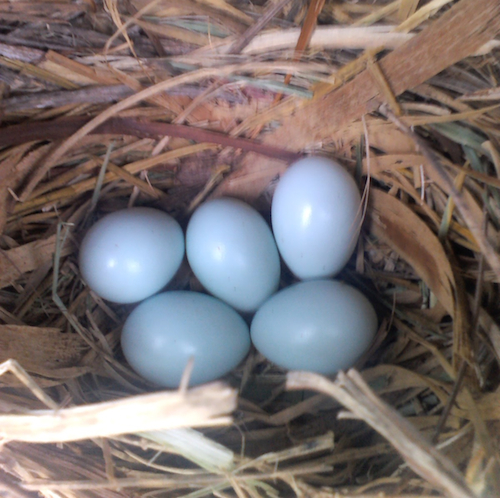
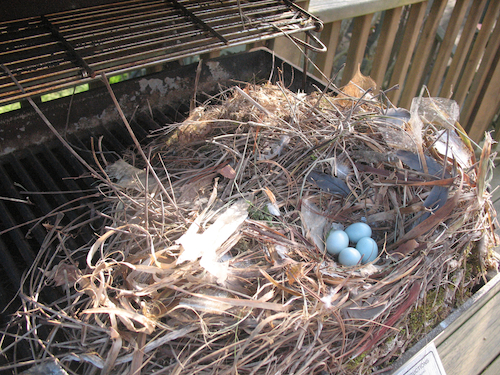
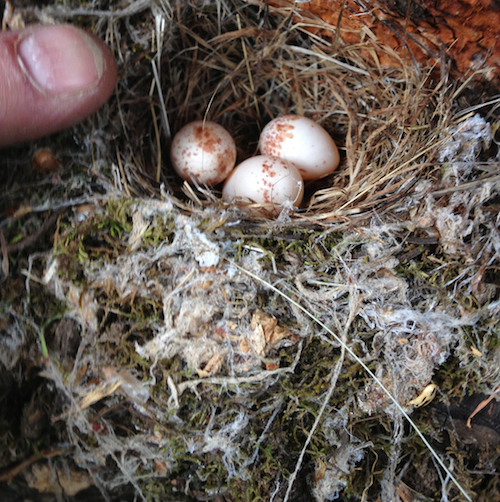
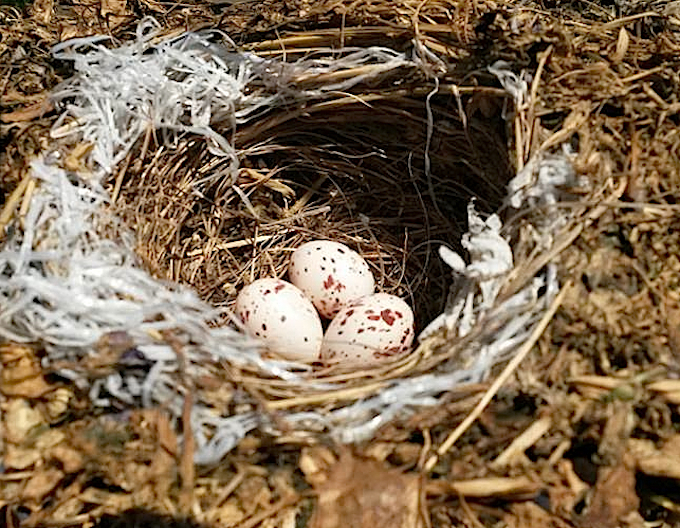
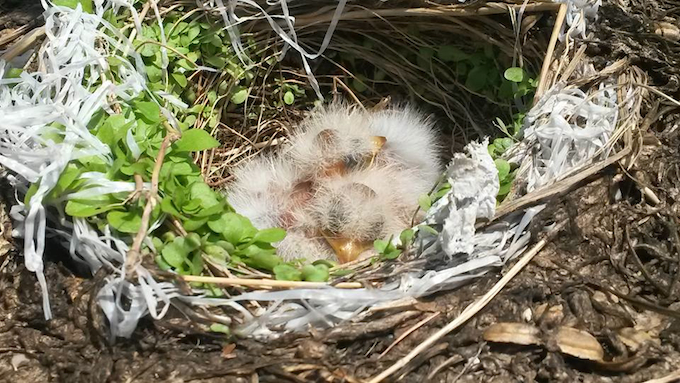
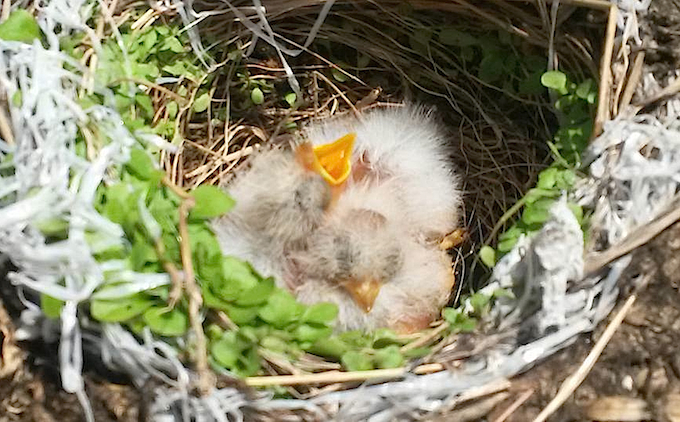
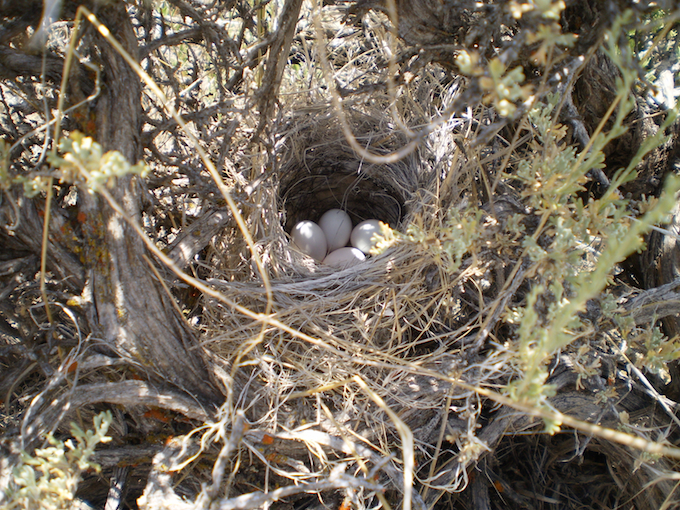
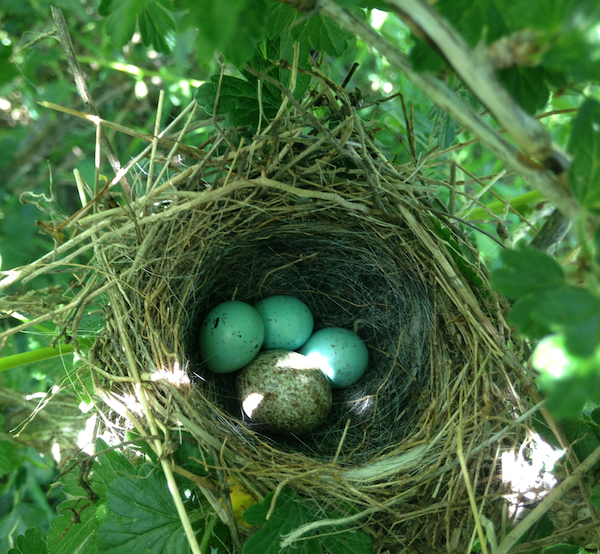
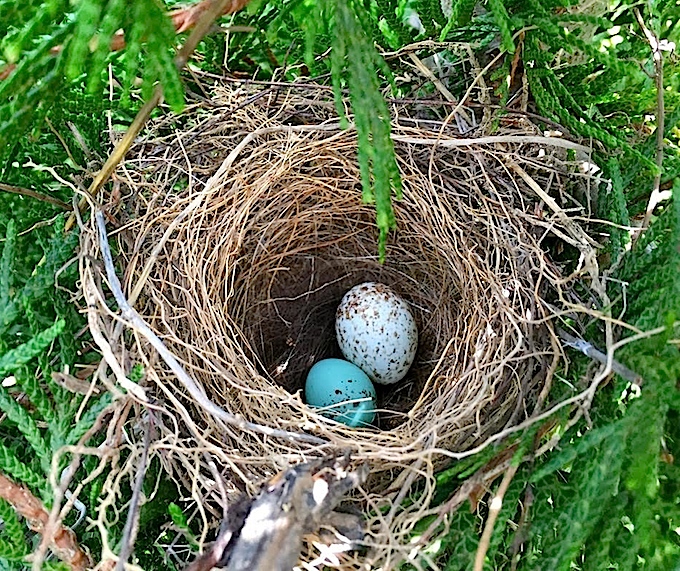
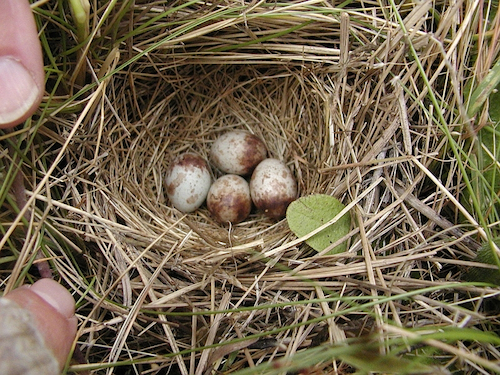
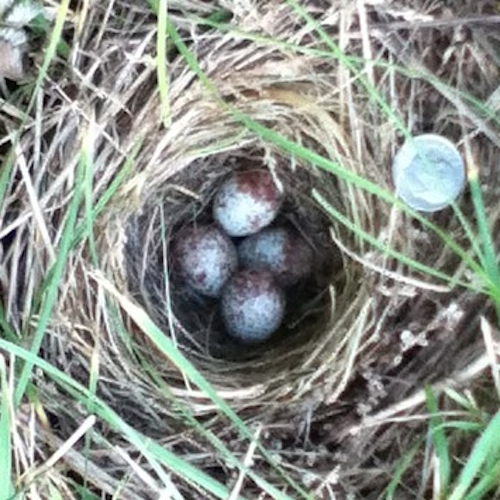
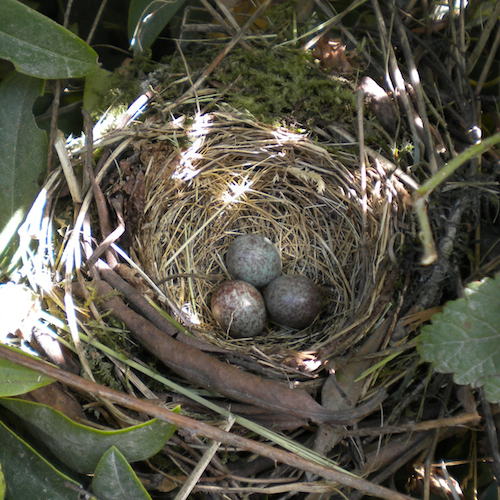
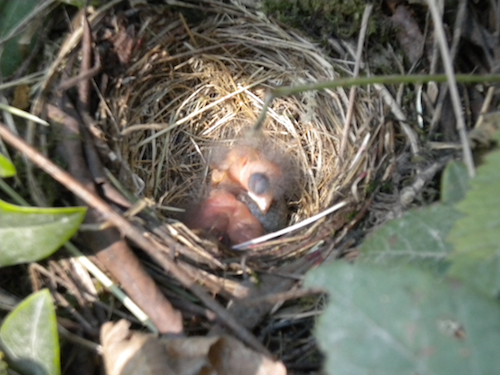
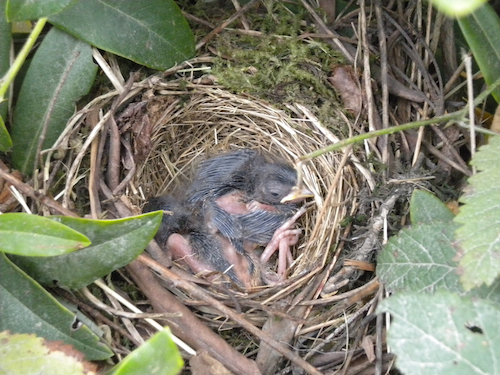
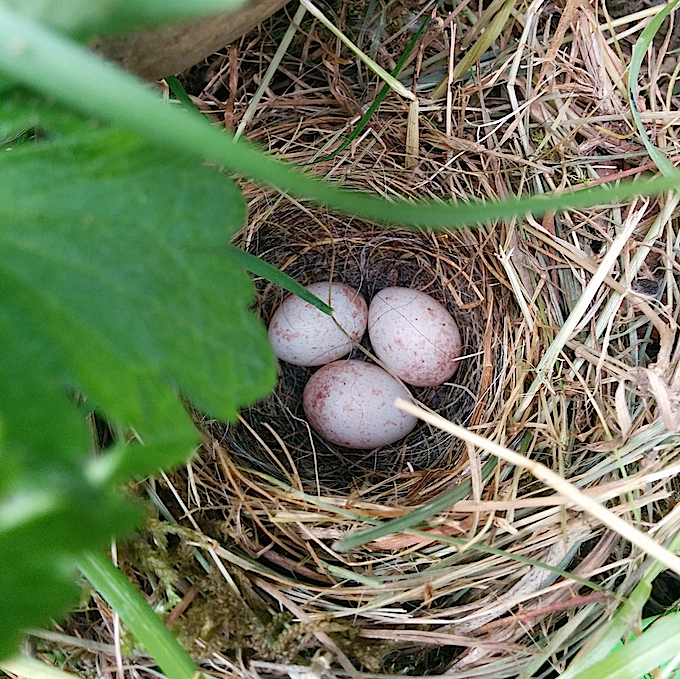
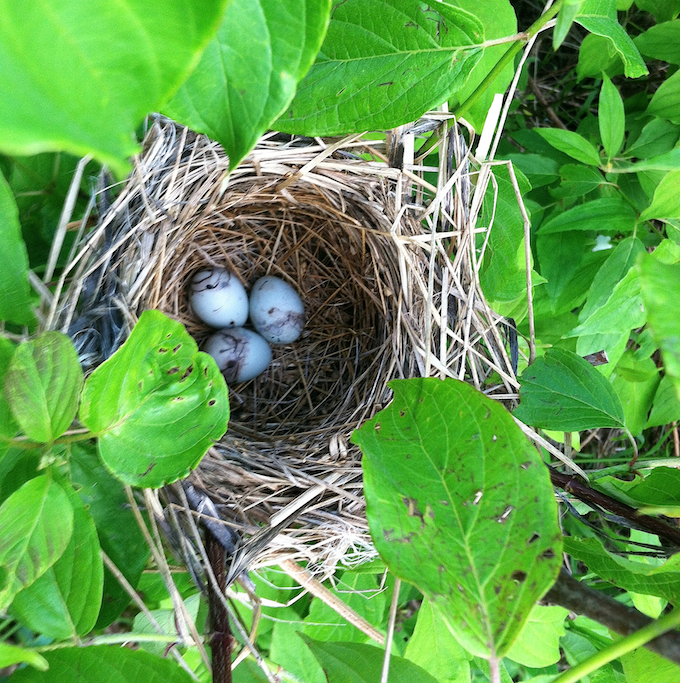
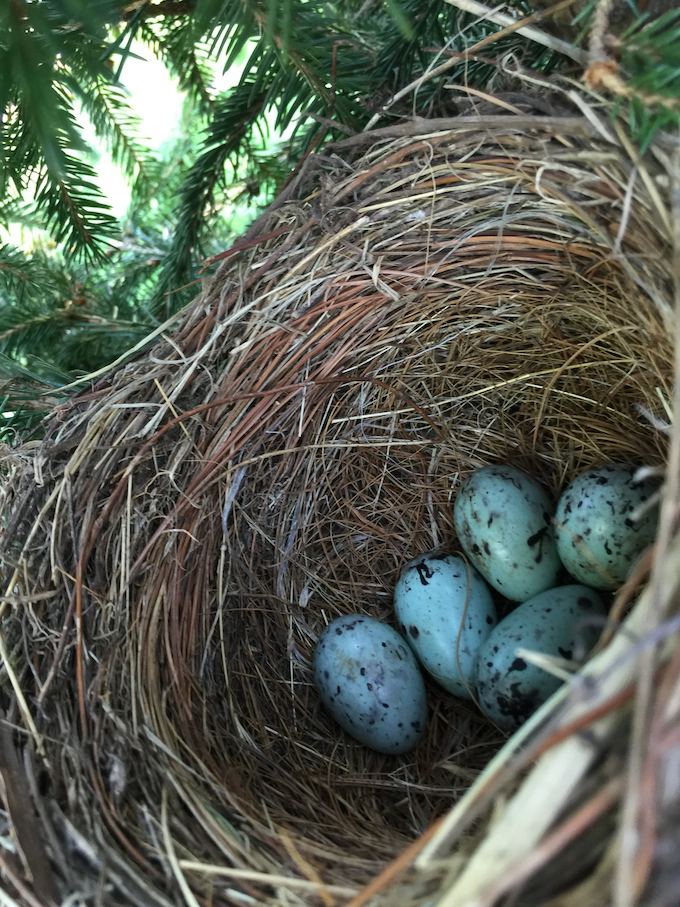
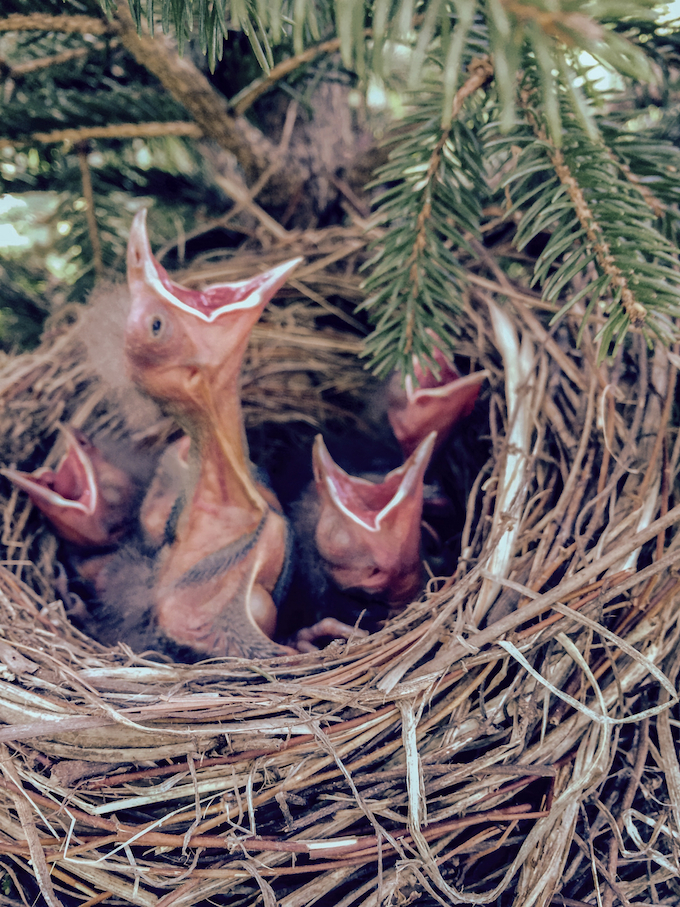
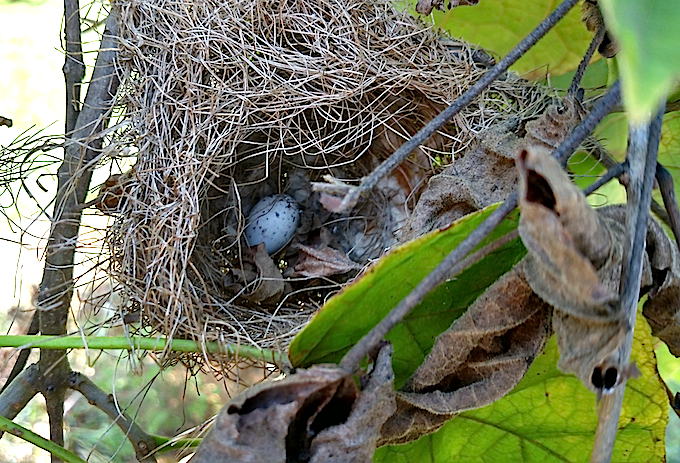
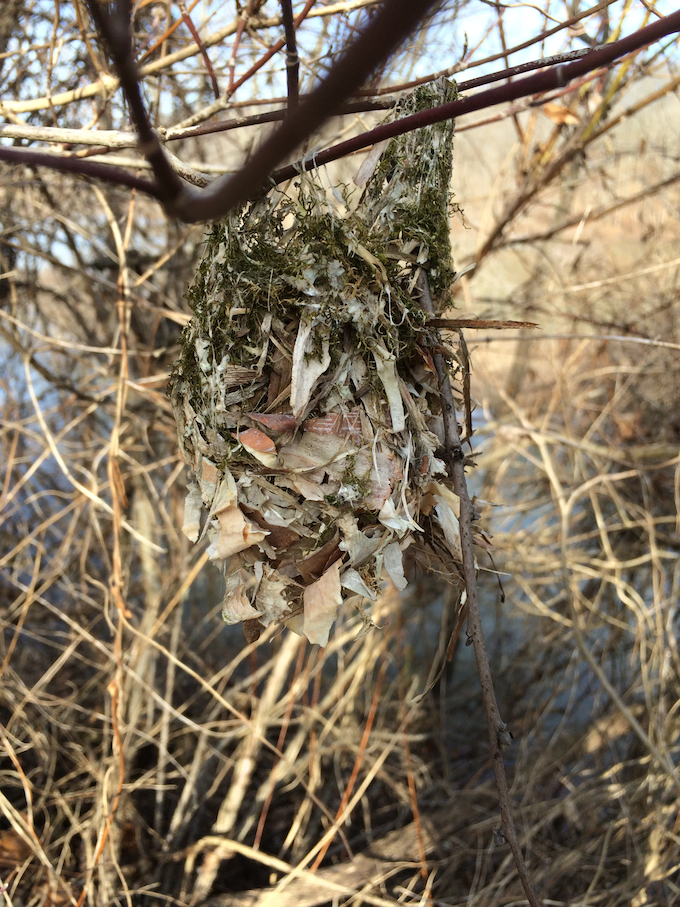
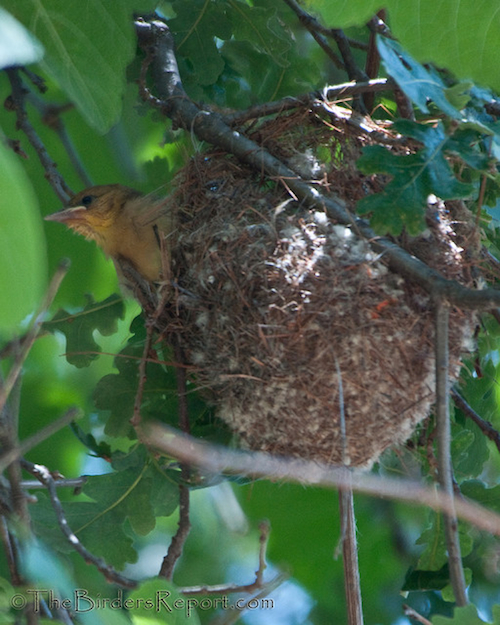
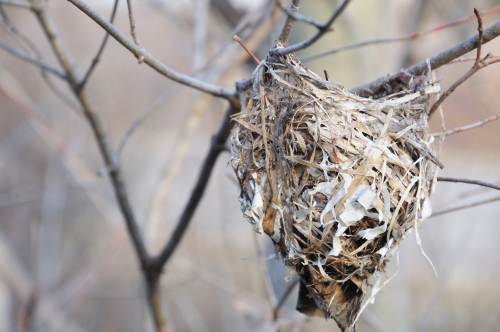
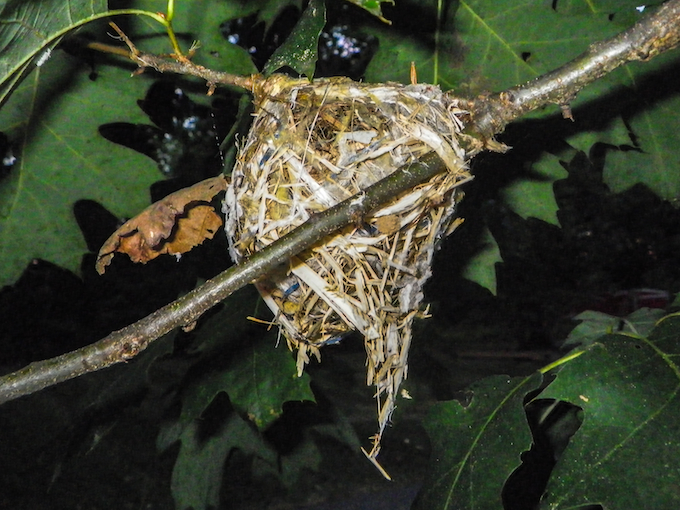
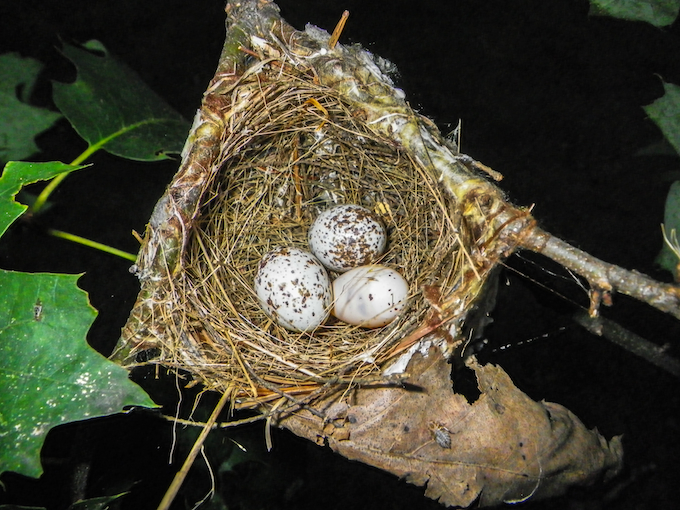
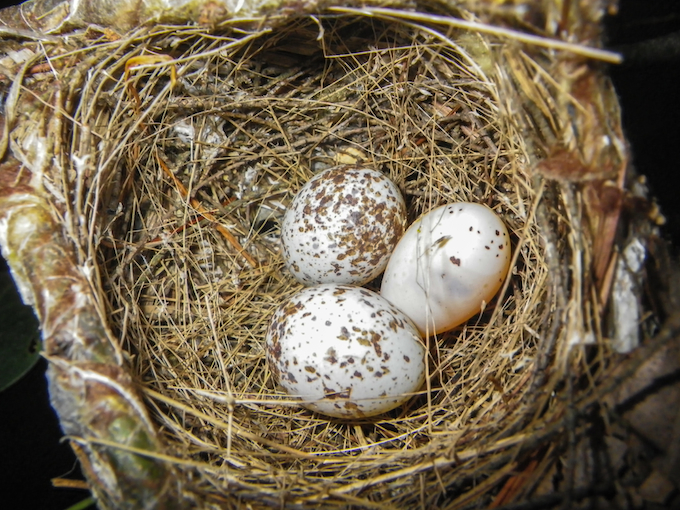
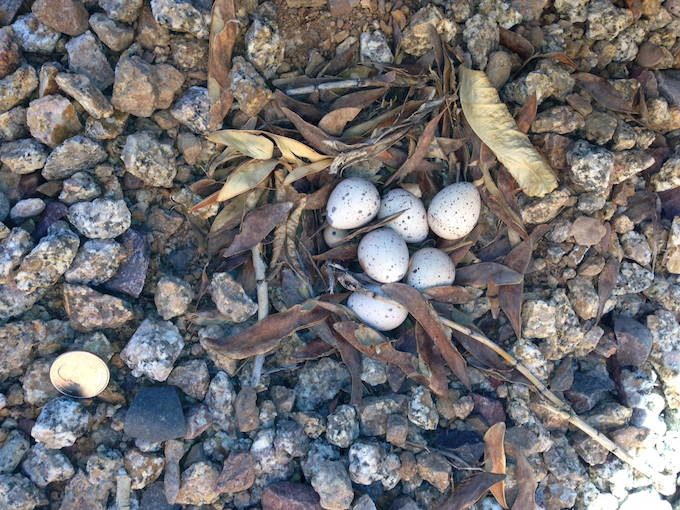
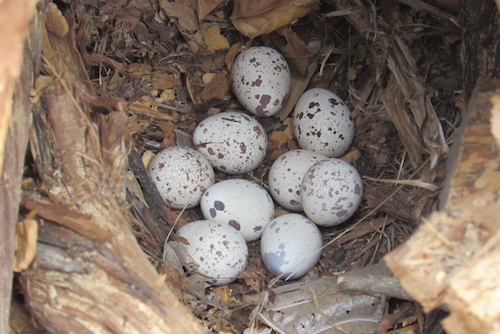
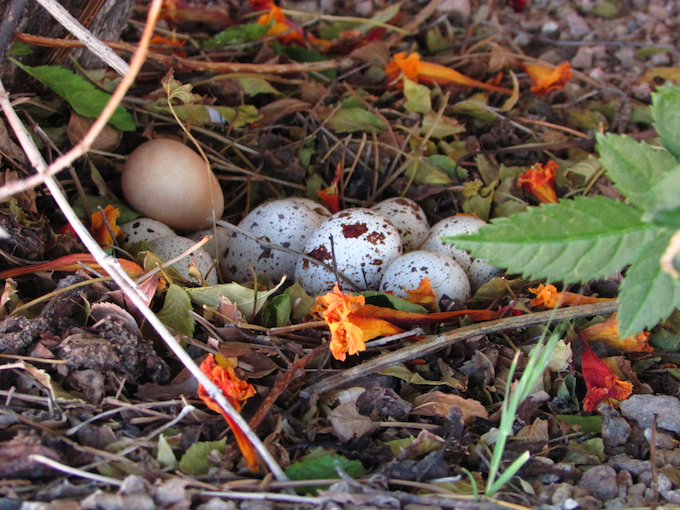
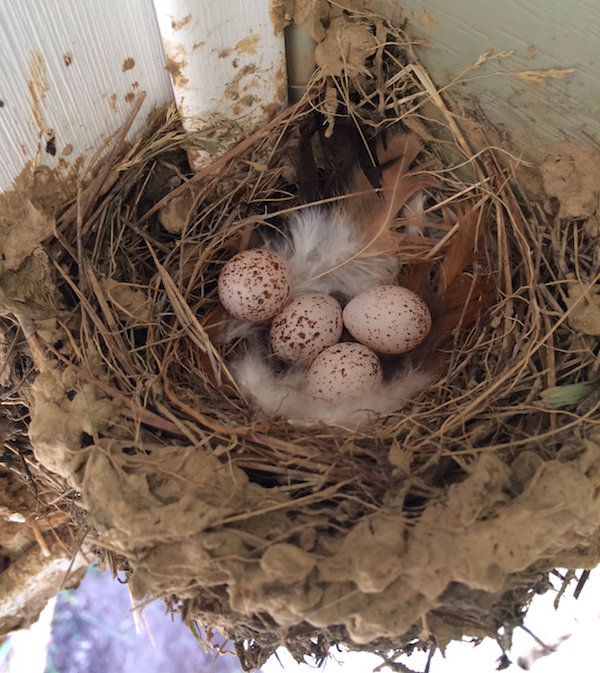
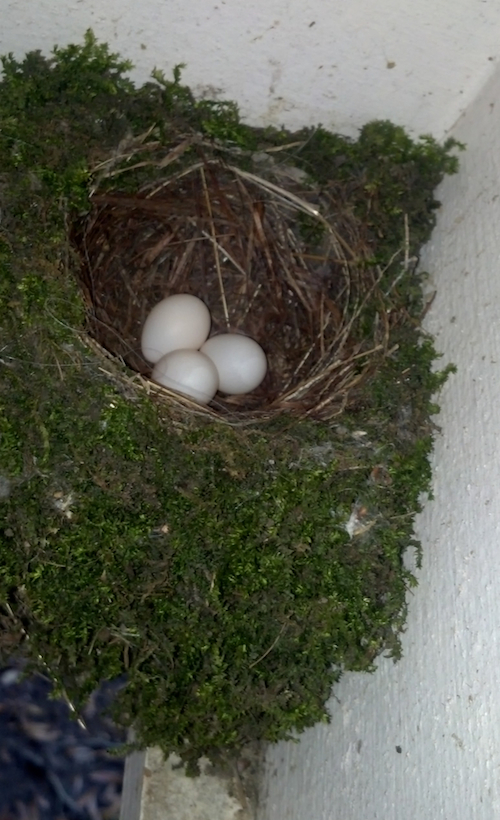
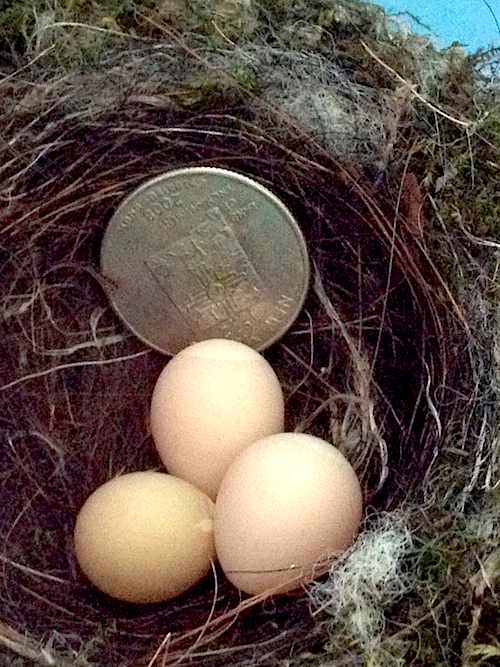
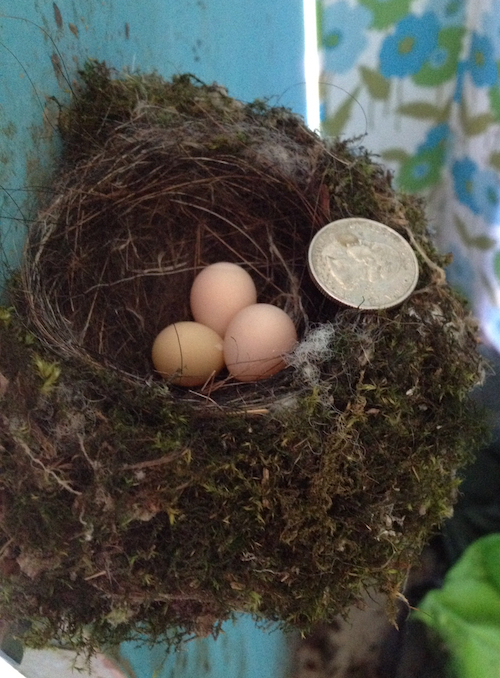
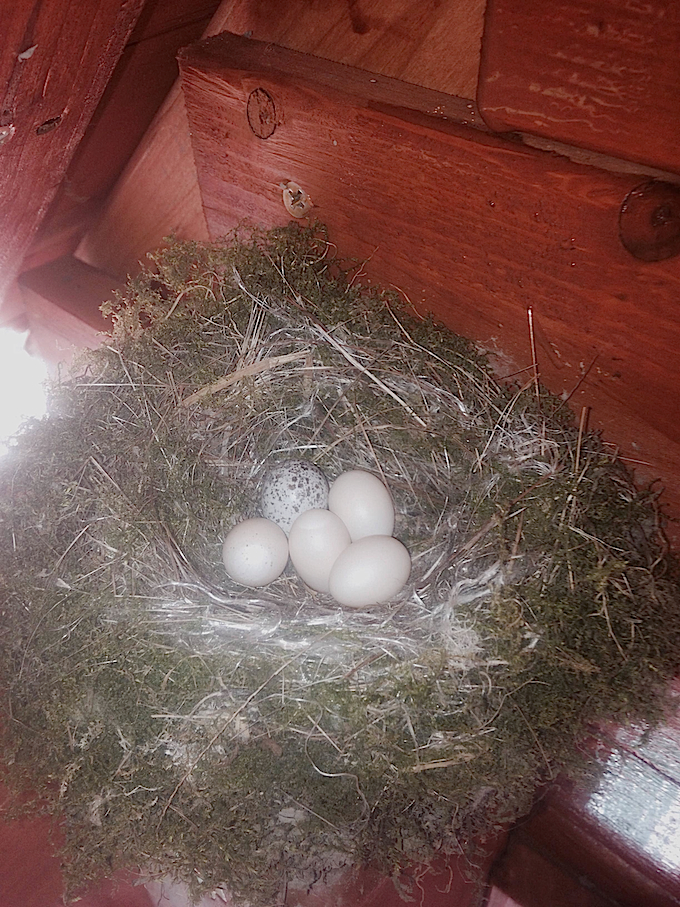
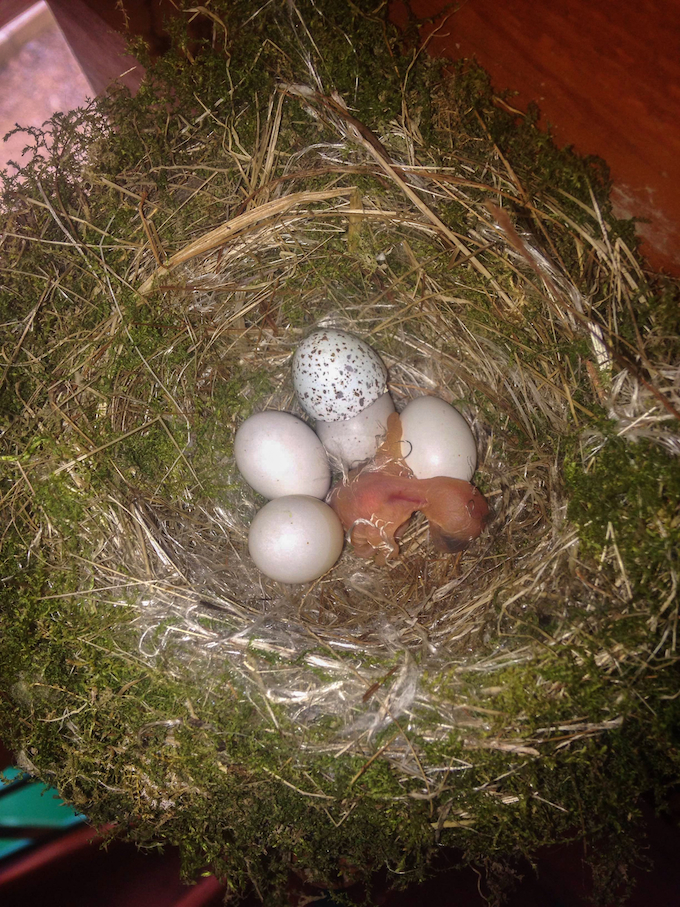
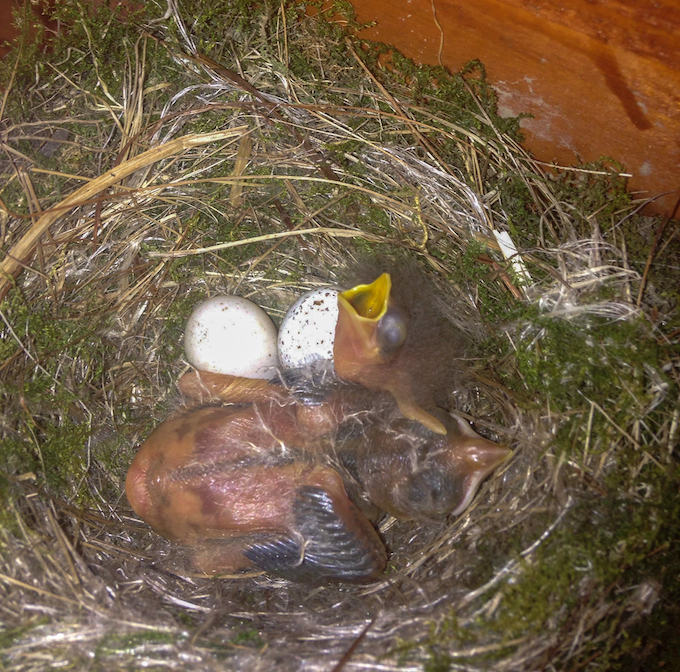
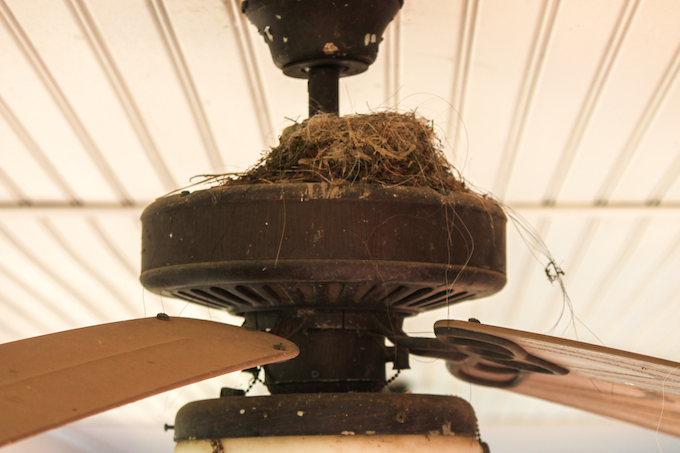
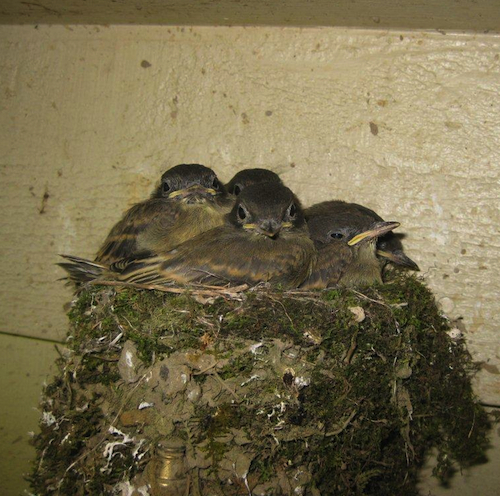
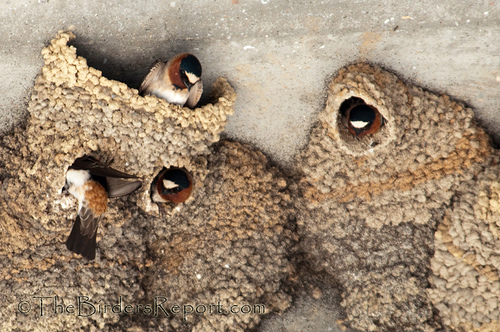
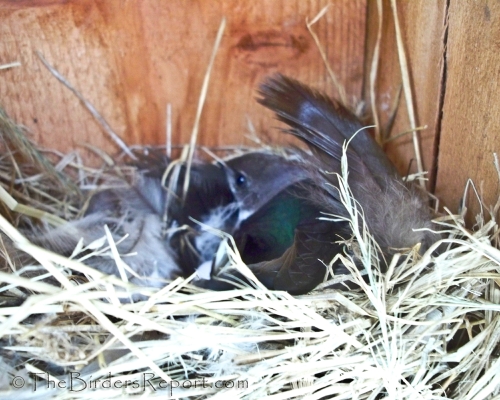
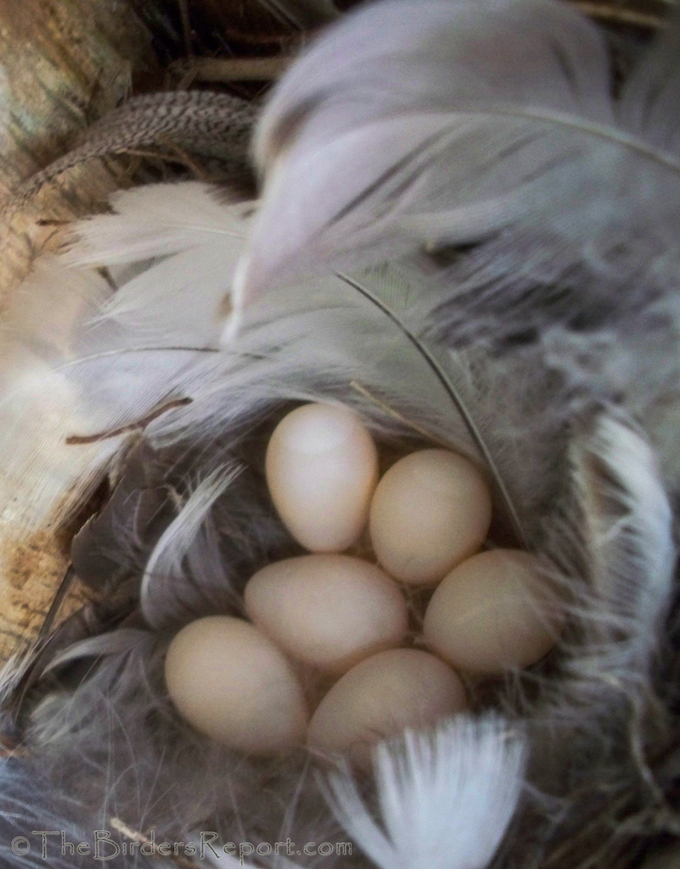
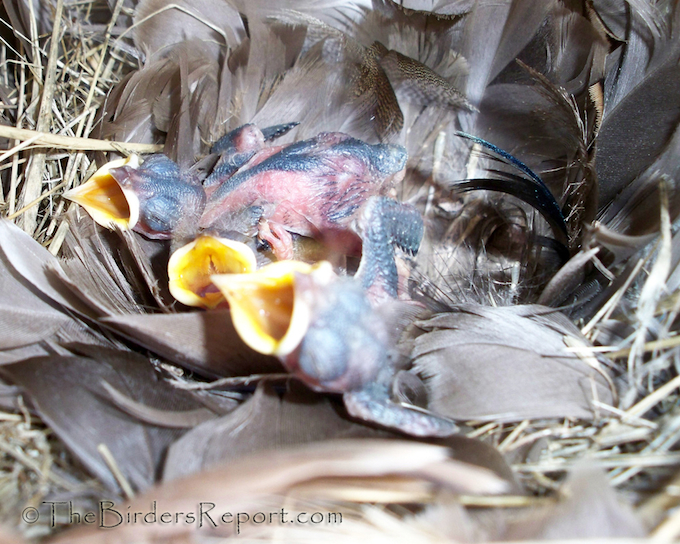
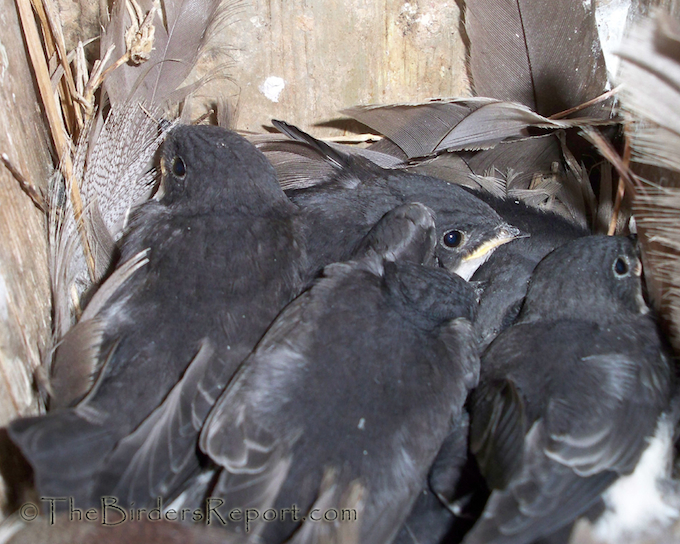
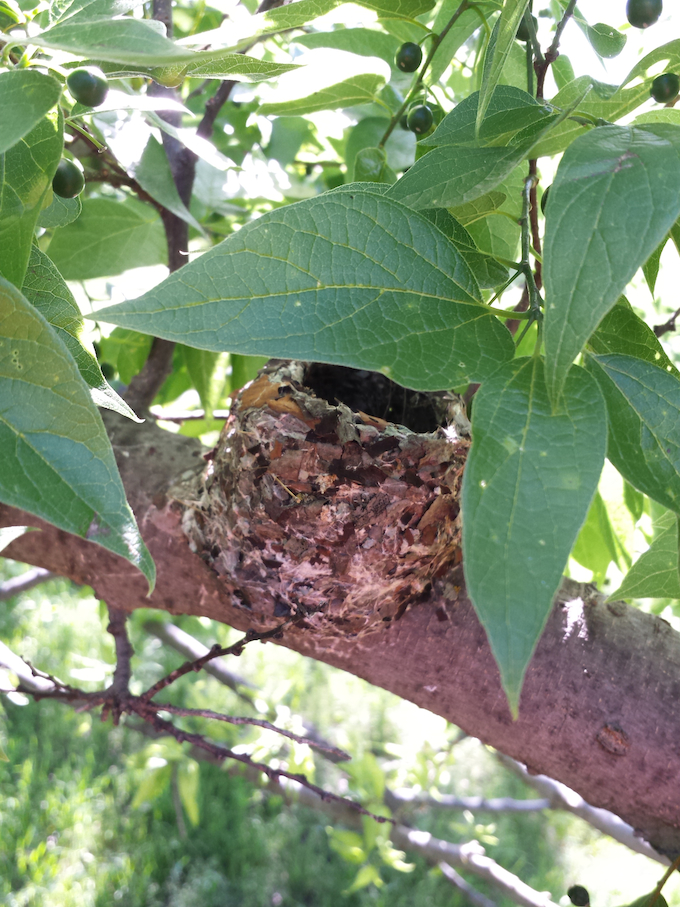
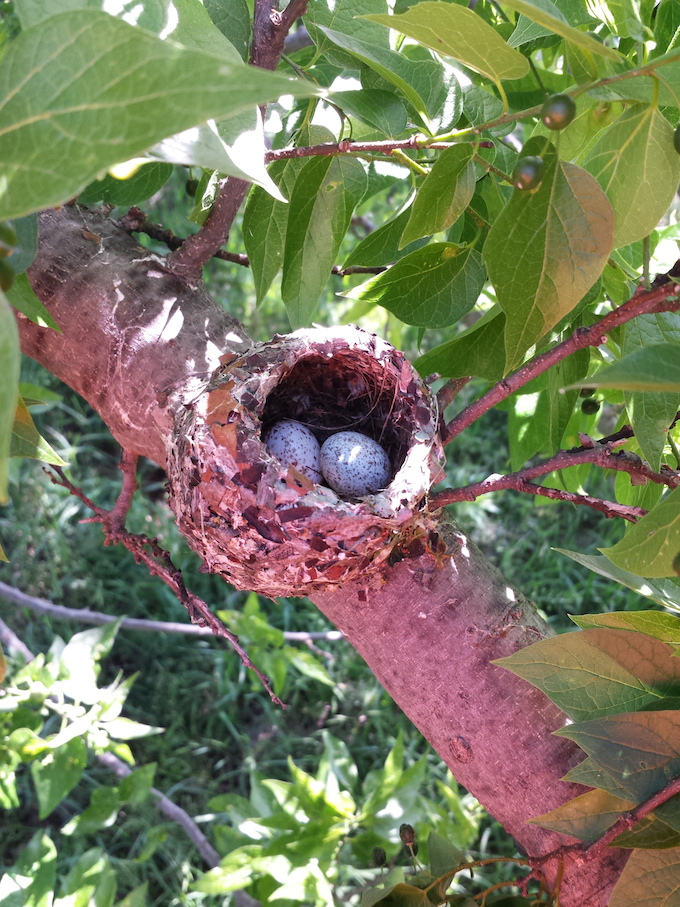
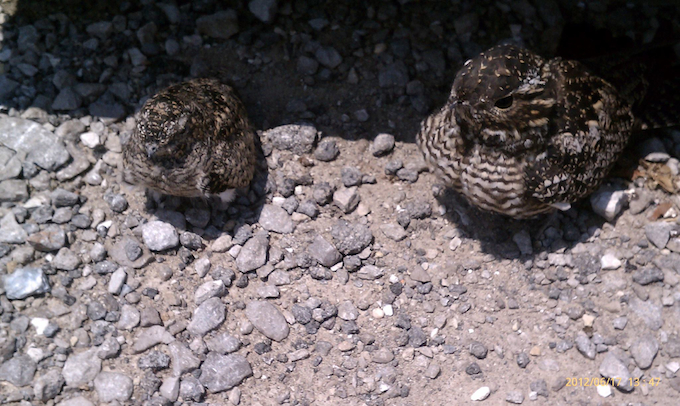



Social Media Connect